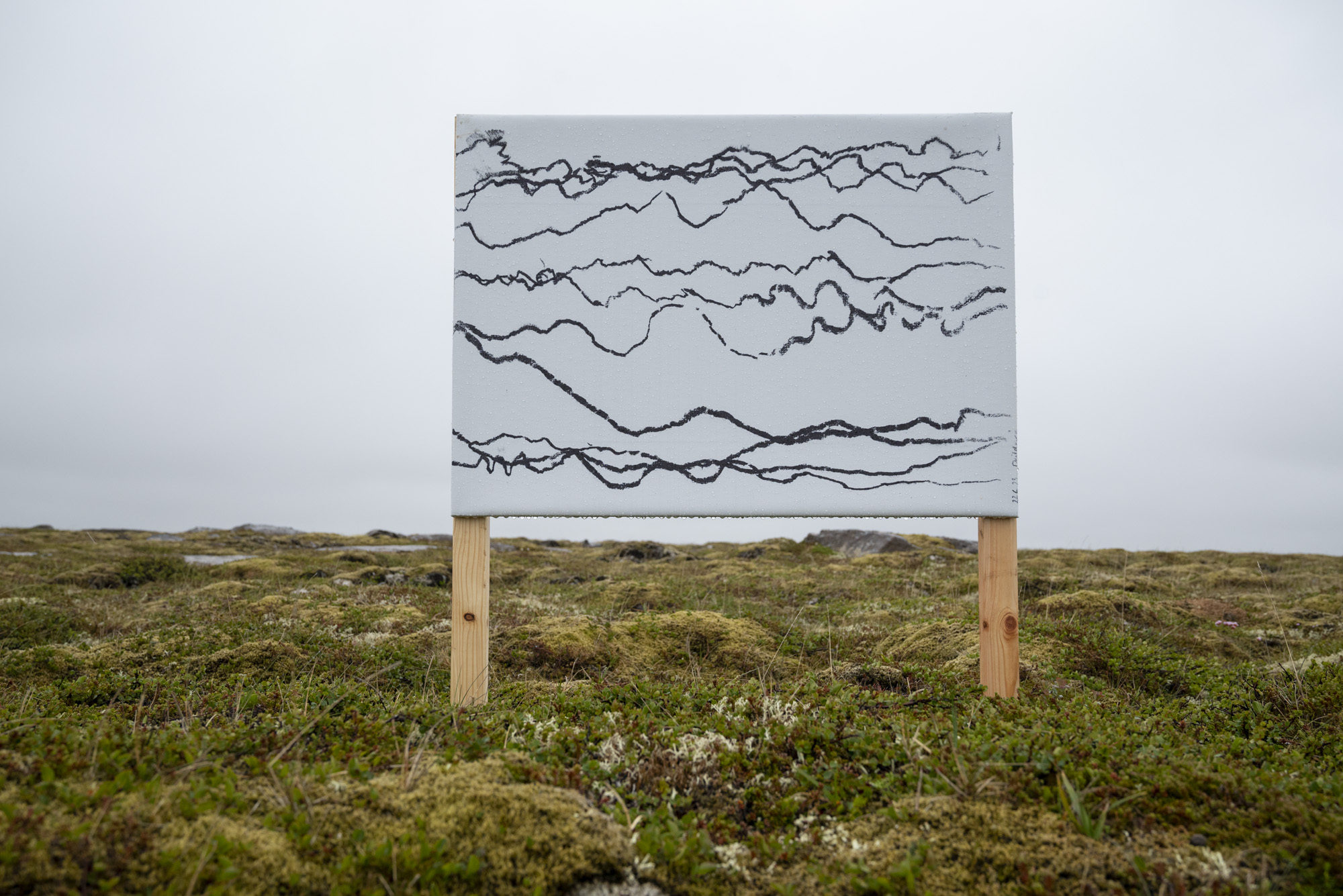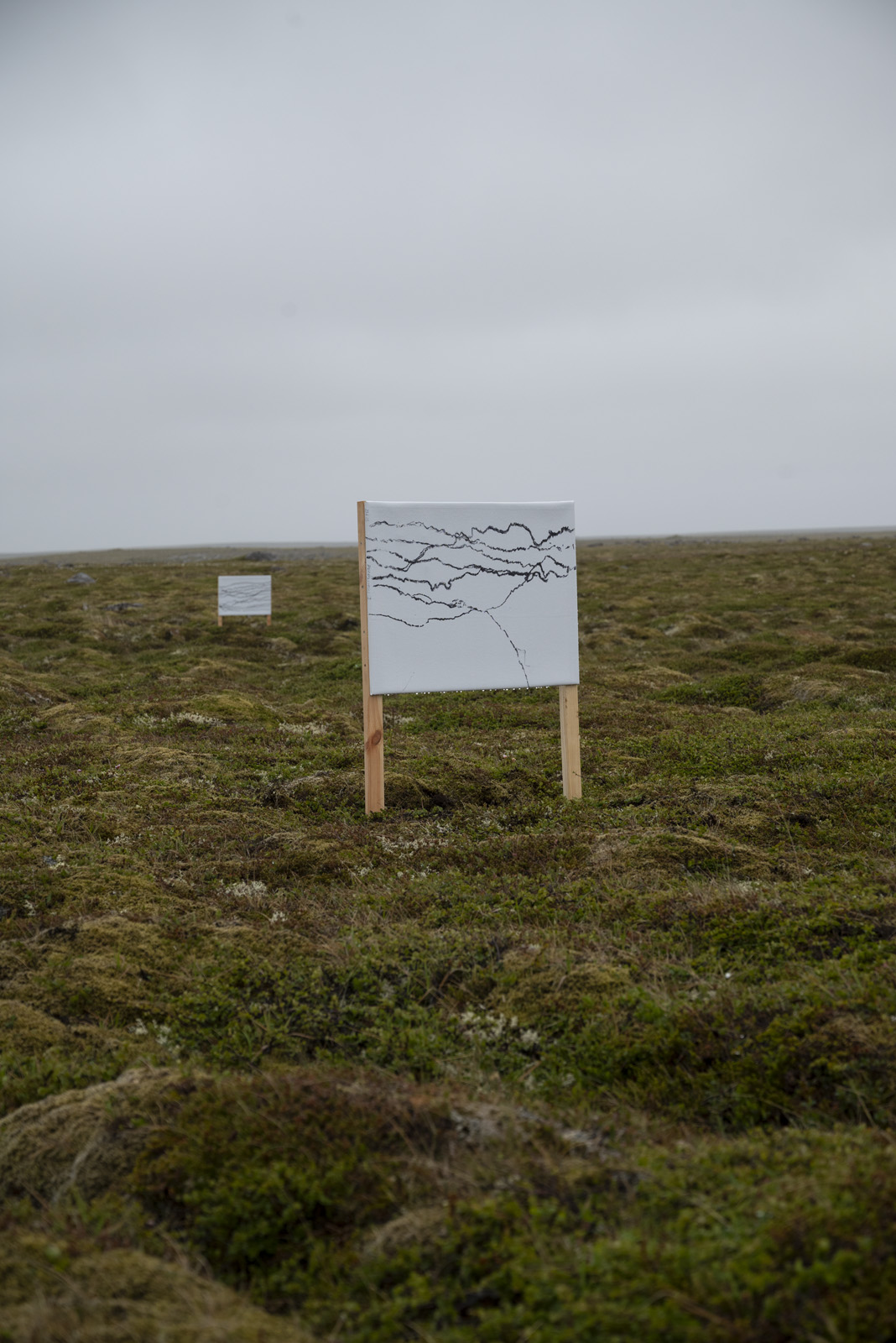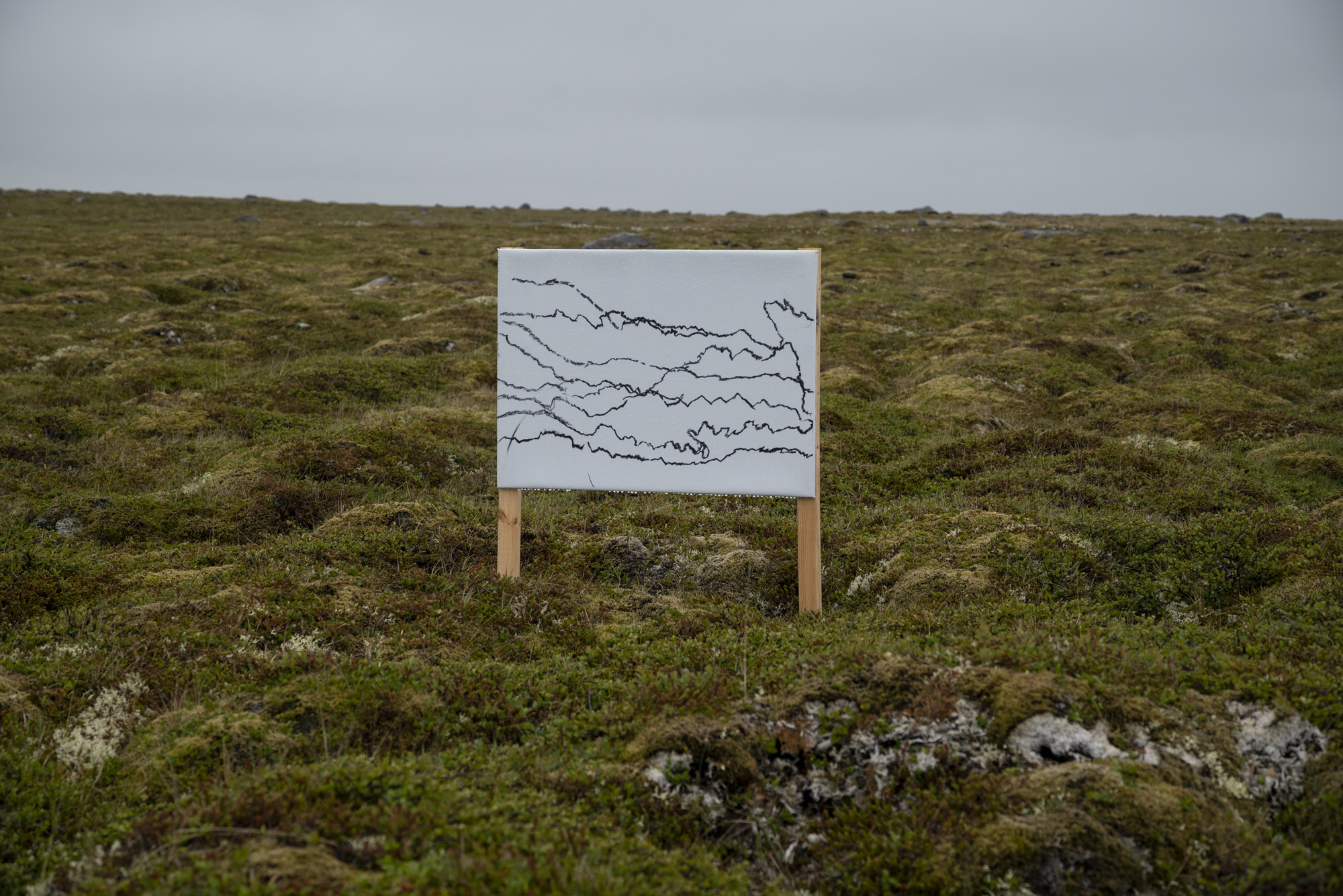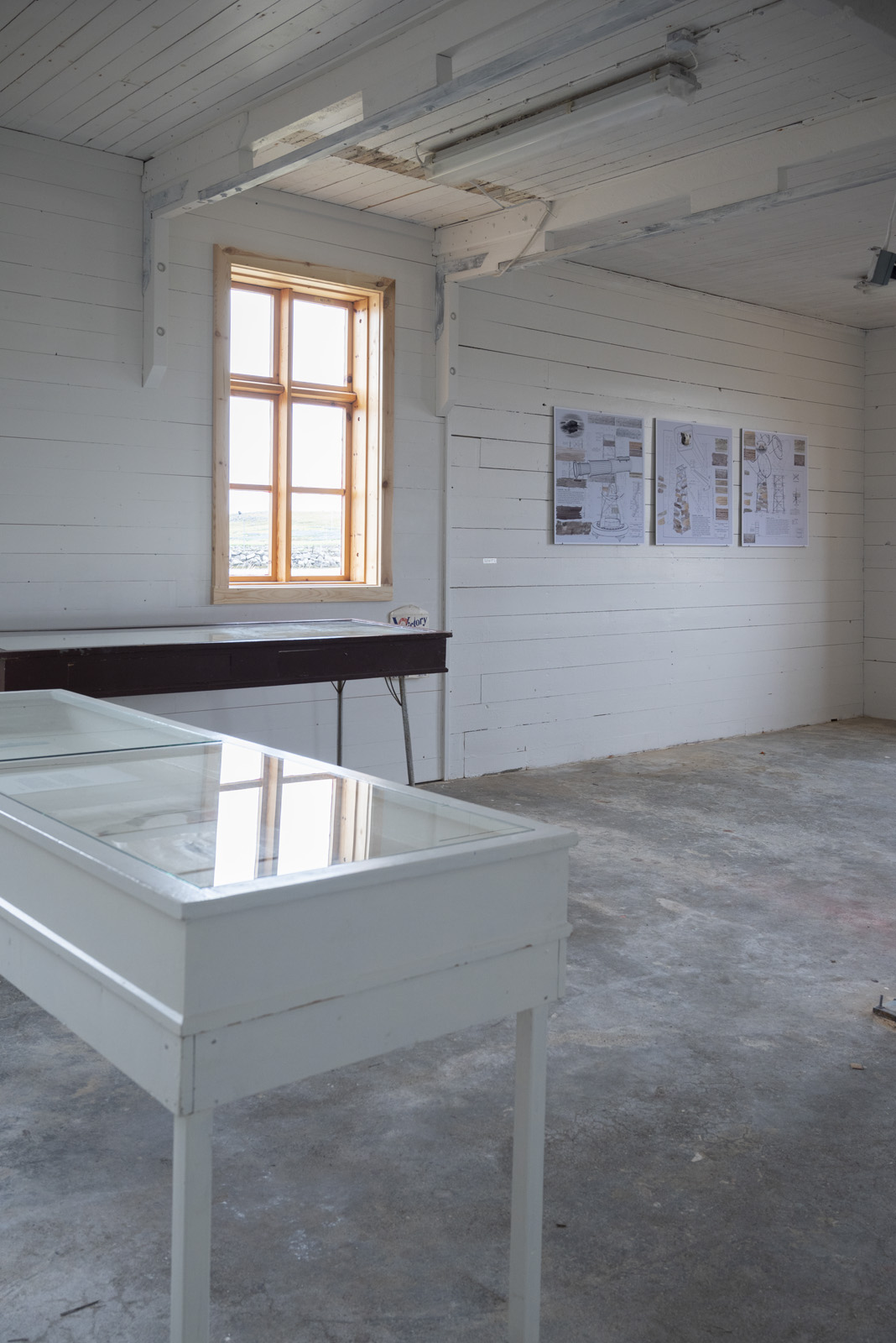When the artist Sigtryggur Bjarni Baldvinsson and the scientist Pedro Rodriges met in Raufarhöfn a few years back, they quickly bonded over their shared interest in the natural world; studying and witnessing environmental changes currently unravelling. Pedro is located in Raufarhöfn in the research centre RIF which monitors the evolution of fauna and flora in the Tundra environment of the plain of Melrakaslétta. Alarmed by the urgency of the current climate crisis, they decided to initiate an experimental exhibition project, inviting artists to Melrakaslétta. This project aimed to immerse artists in the environment, history, and potential future of the region by becoming intimate with a place.
For two consecutive summers, a group of 14 artists visited the Northernmost inhabited region of mainland Iceland. They spent time together, hiked together, sat in silence, observed the moss and birds and started to embody the variety of the Slétta, its history, richness, and beauty but also the challenges that nature and societies face.
Upon returning to their respective studios, each artist developed new work inspired by their experiences in the Northeast. Through artistic research, embedded within their practice, each work directly responds to what they have witnessed.
With this project, we aim to bring awareness to current issues that the Slétta is facing, but also more generally the current climate crisis. Each piece offers a unique perspective, demonstrating the multifaceted nature of complex problems.
This experimental way of exhibition-making was successful in allowing the artists to embody a place, a history, and knowledge through meeting people, places, non-humans, talking, feeling, and being. I am pleased to see how each work became very personal, respectful of the Slétta, but also critical and thought-provoking.
The exhibition primarily takes place in Óskarsbraggi, both in the exhibition space on the ground floor, facing the harbour, and in the upper floors spreading throughout the building. Another part of the exhibition takes place outside, in the village of Raufarhöfn, with outdoor sculptures, sound pieces and photographs. Finally, another artwork invites the visitors to venture all the way into the wild of the Slétta, about a 20-minute drive north of Raufarhöfn, into the tundra.
As an attempt to communicate and share the experience of this exhibition we have collected photographs from the show along with texts from the catalogue provided below, but of course, we highly recommend you to drop by Raufarhöfn for a full experience of the works.
Julie Sjöfn Gasiglia, curator.
Ground Floor:
Sólveig Aðalsteinsdóttir
Kindagötur
Sólveig Aðalsteinsdóttir exhibits 2 works, one is situated under the blue sky out in Melrakkasletta, the other, 7 charcoal drawings, is installed in Óskarsbraggi
North of Raufarhöfn you can see five signboards by Sólveig. These are drawings called, Kindagötur (sheep-trails).
Sólveig recounts how she walked across Melrakkaslétta last summer. She followed the narrow sheep paths, letting the trails of the sheep guide her journey. With a sketchbook and charcoal in hand, she recorded the curved and winding lines of the trails. She did not look at the drawing paper but focused her attention on the foot that tread the path while her hand drew.
The song of birds resonated in the air.
Kindagötur
Sólveig Aðalsteinsdóttir exhibits 2 works, one is situated under the blue sky out in Melrakkasletta, the other, 7 charcoal drawings, is installed in Óskarsbraggi
North of Raufarhöfn you can see five signboards by Sólveig. These are drawings called, Kindagötur (sheep-trails).
Sólveig recounts how she walked across Melrakkaslétta last summer. She followed the narrow sheep paths, letting the trails of the sheep guide her journey. With a sketchbook and charcoal in hand, she recorded the curved and winding lines of the trails. She did not look at the drawing paper but focused her attention on the foot that tread the path while her hand drew.
The song of birds resonated in the air.
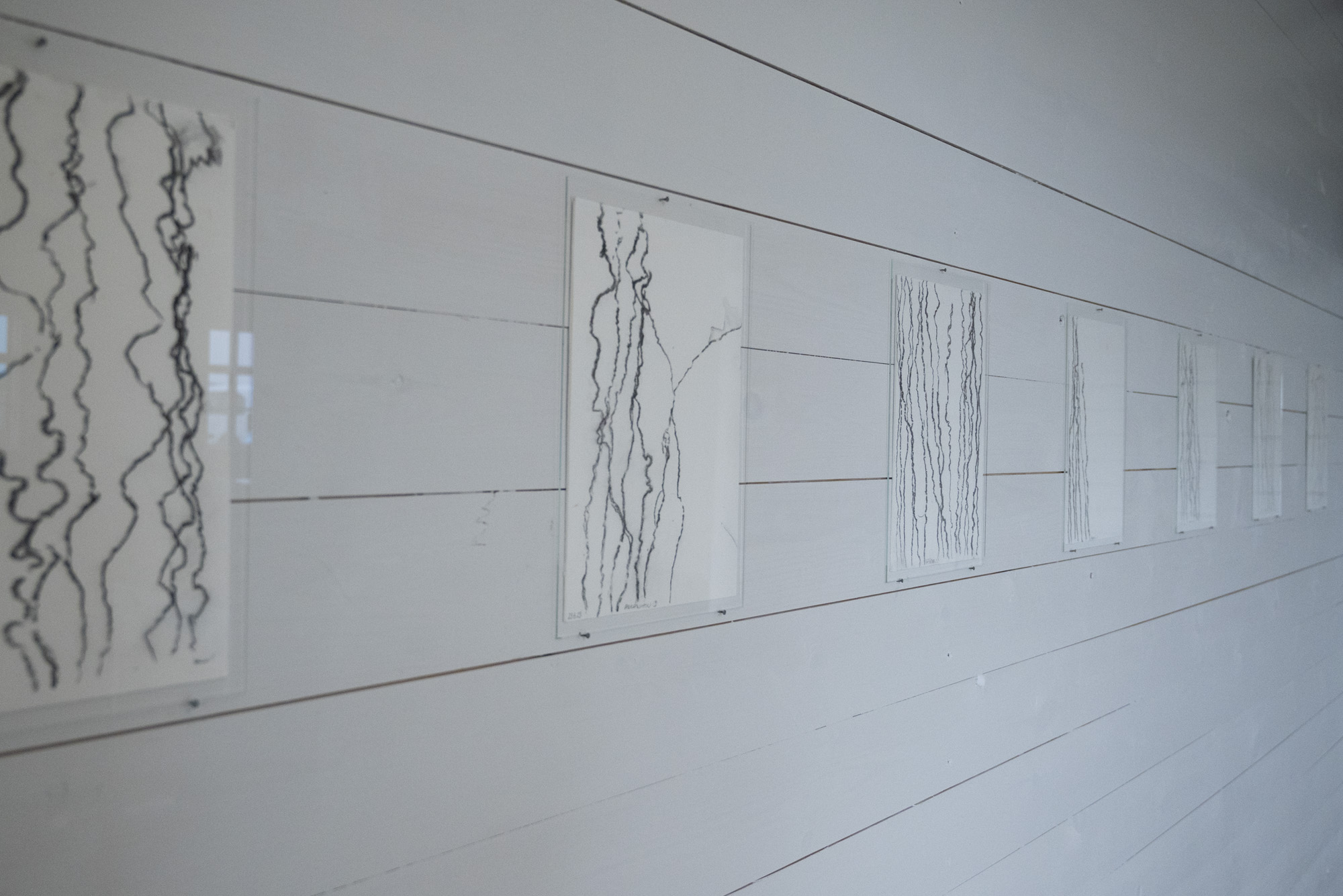
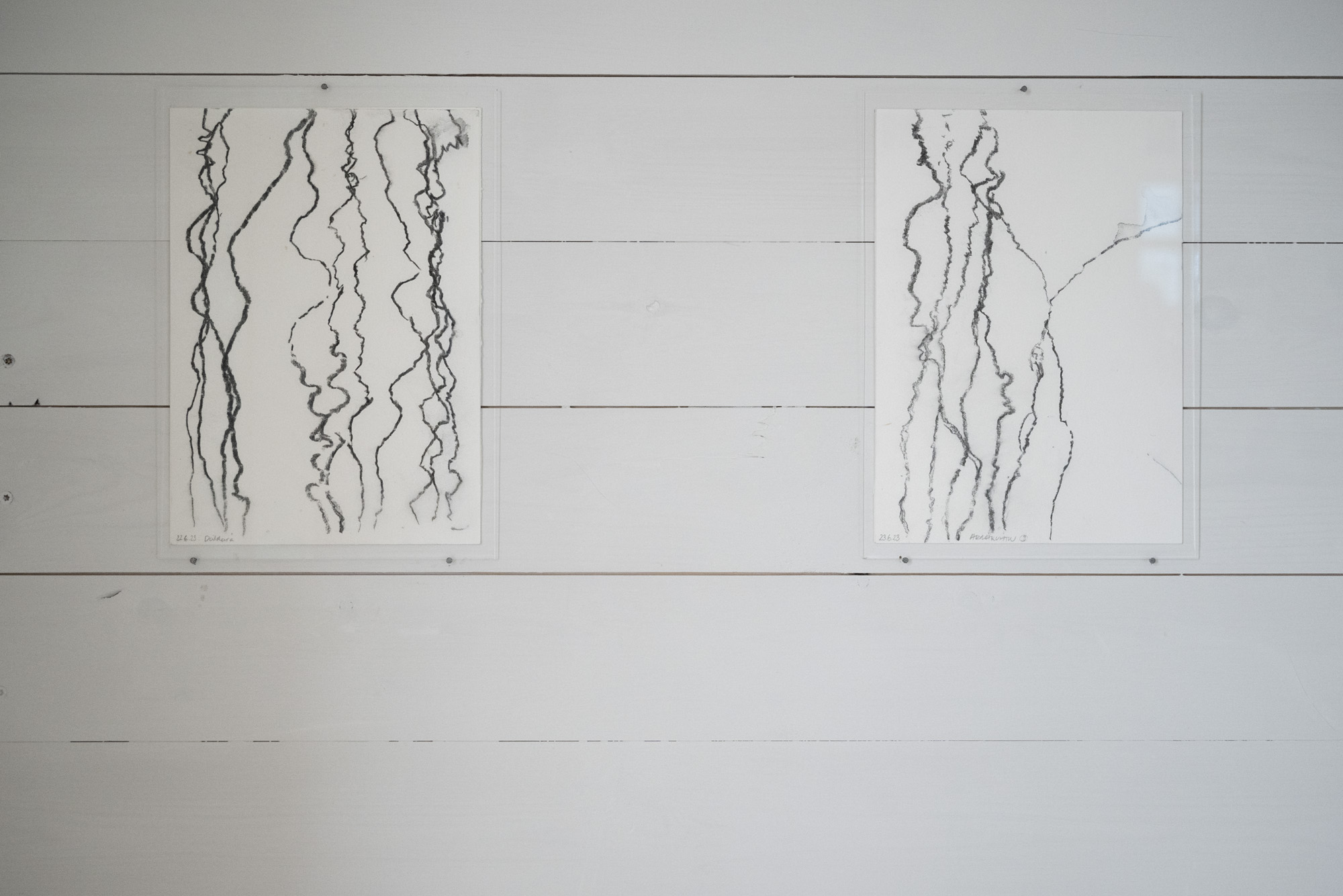
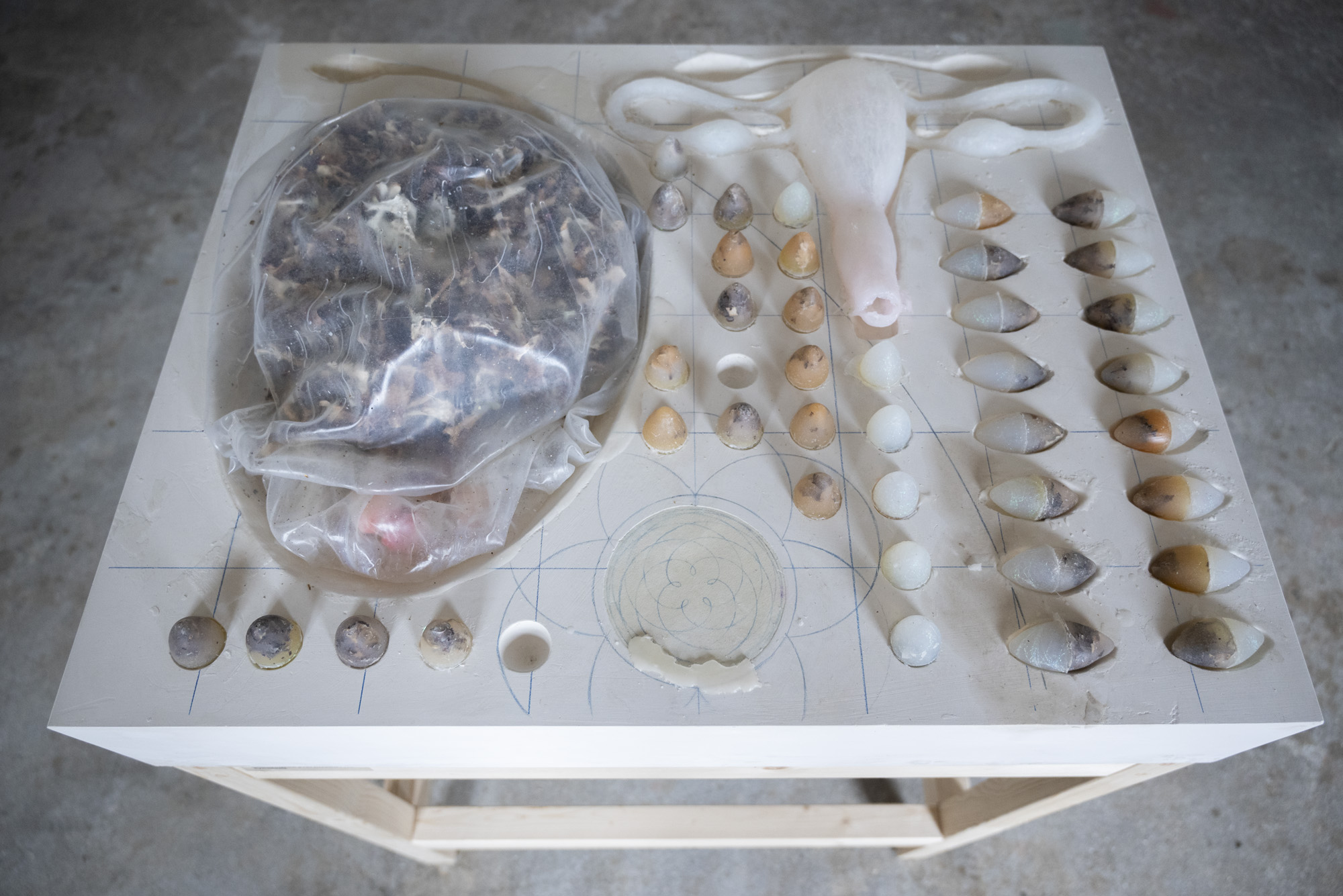
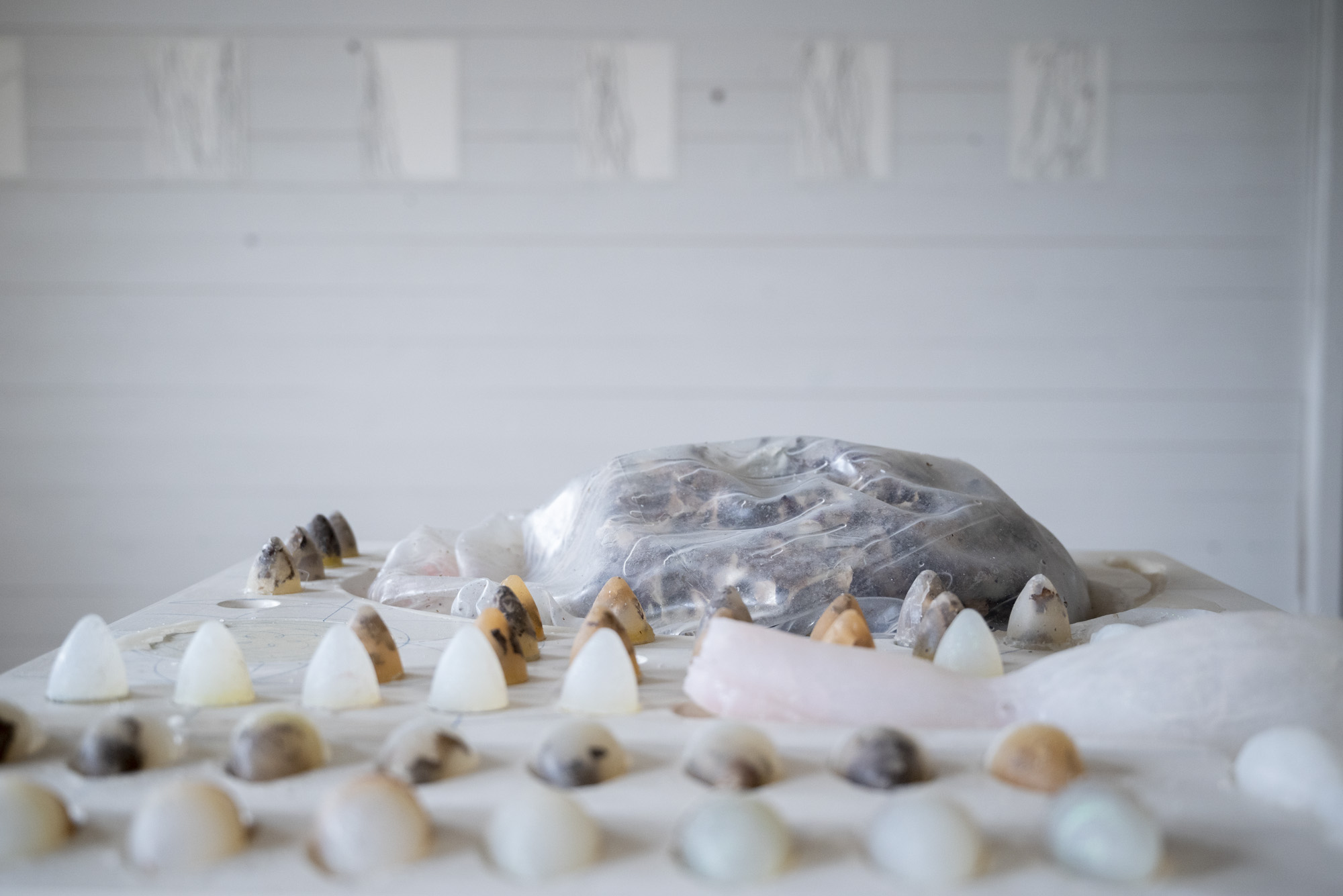


Ragnhildur Stefánsdóttir
Symbiosis, 2024.
Fjallagrös have been on my mind. These tiny yet vigorous arctic lichens (True Icelandic lichen) grow on Melrakkaslétta. Lichens are complex life forms that grow as the symbiotic partnership of fungi and algae. Two organisms become one through mutual support: the algae provides nutrition and photosynthesis; the fungi harvests water and minerals. A clear division of labour and mutual respect!
This work takes it title from the concept of a mutually dependent relationship as with that of lichens, but also our relationship to nature and to each other. . It could be the symbiosic of lichens refers our relationship to nature and each other. Lichen Symbiosis also brings to mind opposites: algae as the light, fungi as darkness. The algae is under, the fungus is over.
The tectonic plates on Melrakkaslétta divide it along its length into wetlands and dry lands.
And then Þórshani (Red Phalarope fulicarius)emerges. This rare bird visits Melrakkaslétta at around the same time I like to be there on clear summer nights in June and July. Þórshani only comes here to lay eggs and then takes her chicks to tropical lands.
The egg ́s pattern recalls for me eminisces the appearance of lichens, when then led to the idea of fusing the - which led to a fusion of egg and the lichen. I split the egg is split in two: one half with lichen and the other a light conductor. Eggs and light conductors bring to mind mother ́s womb, the fallopian tube, and the fetal membrane.
I lay an imagined membrane over what I wish to preserve. The work Symbiosis is born from the symbiosis of thought processes and experiences on Melrakkaslétta.
Symbiosis, 2024.
Fjallagrös have been on my mind. These tiny yet vigorous arctic lichens (True Icelandic lichen) grow on Melrakkaslétta. Lichens are complex life forms that grow as the symbiotic partnership of fungi and algae. Two organisms become one through mutual support: the algae provides nutrition and photosynthesis; the fungi harvests water and minerals. A clear division of labour and mutual respect!
This work takes it title from the concept of a mutually dependent relationship as with that of lichens, but also our relationship to nature and to each other. . It could be the symbiosic of lichens refers our relationship to nature and each other. Lichen Symbiosis also brings to mind opposites: algae as the light, fungi as darkness. The algae is under, the fungus is over.
The tectonic plates on Melrakkaslétta divide it along its length into wetlands and dry lands.
And then Þórshani (Red Phalarope fulicarius)emerges. This rare bird visits Melrakkaslétta at around the same time I like to be there on clear summer nights in June and July. Þórshani only comes here to lay eggs and then takes her chicks to tropical lands.
The egg ́s pattern recalls for me eminisces the appearance of lichens, when then led to the idea of fusing the - which led to a fusion of egg and the lichen. I split the egg is split in two: one half with lichen and the other a light conductor. Eggs and light conductors bring to mind mother ́s womb, the fallopian tube, and the fetal membrane.
I lay an imagined membrane over what I wish to preserve. The work Symbiosis is born from the symbiosis of thought processes and experiences on Melrakkaslétta.
Pétur Magnússon
Vél
When I moved to Raufarhöfn, it was the first time in my life that I lived by the sea. I could watch the tides come and go, just out of the kitchen window. This created for me a whole new perspective on life. This movement that the moon creates.
The work in this exhibition is born from this observation. I imagined a kind of machine that is activated by the tides and designed to perform a small ceremony. I drew a complex machine and exhibited the concept through drawings a few years ago. Its execution would be far too ambitious and complex, but it led me to design a more straightforward version. With little maintenance, it might last for about the duration of the show but its ephemeral nature might not allow for a much longer life expectancy. A buoy is placed in the
sea, in front of Óskarsbraggi. As the tides come in the buoy moves up and down, a steel wire attached to it transfers the movement of the ocean onto the land and into the exhibition hall. There, it moves a ladle up and down in a bowl of water, watering a small plant, twice a day.
Vél
When I moved to Raufarhöfn, it was the first time in my life that I lived by the sea. I could watch the tides come and go, just out of the kitchen window. This created for me a whole new perspective on life. This movement that the moon creates.
The work in this exhibition is born from this observation. I imagined a kind of machine that is activated by the tides and designed to perform a small ceremony. I drew a complex machine and exhibited the concept through drawings a few years ago. Its execution would be far too ambitious and complex, but it led me to design a more straightforward version. With little maintenance, it might last for about the duration of the show but its ephemeral nature might not allow for a much longer life expectancy. A buoy is placed in the
sea, in front of Óskarsbraggi. As the tides come in the buoy moves up and down, a steel wire attached to it transfers the movement of the ocean onto the land and into the exhibition hall. There, it moves a ladle up and down in a bowl of water, watering a small plant, twice a day.
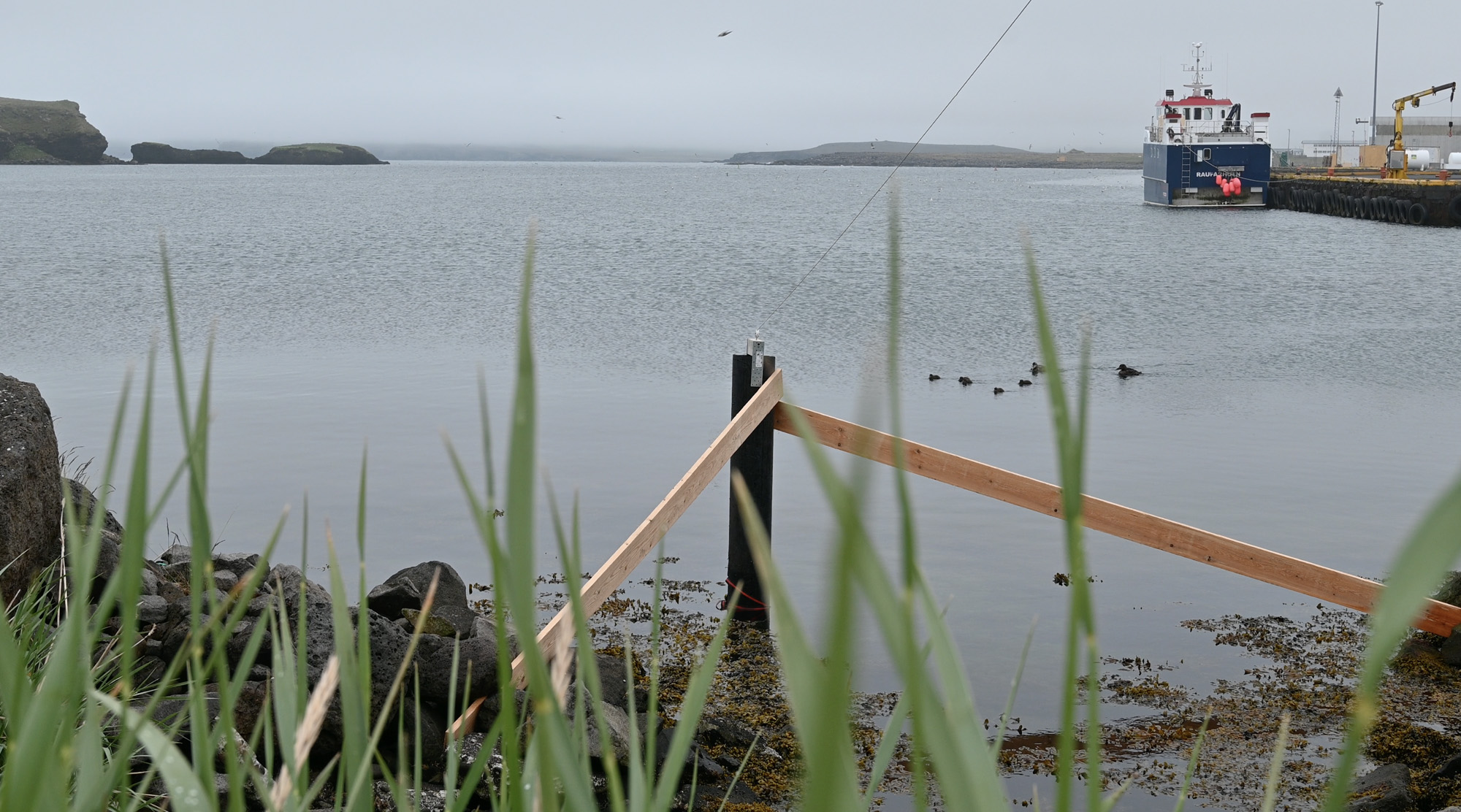

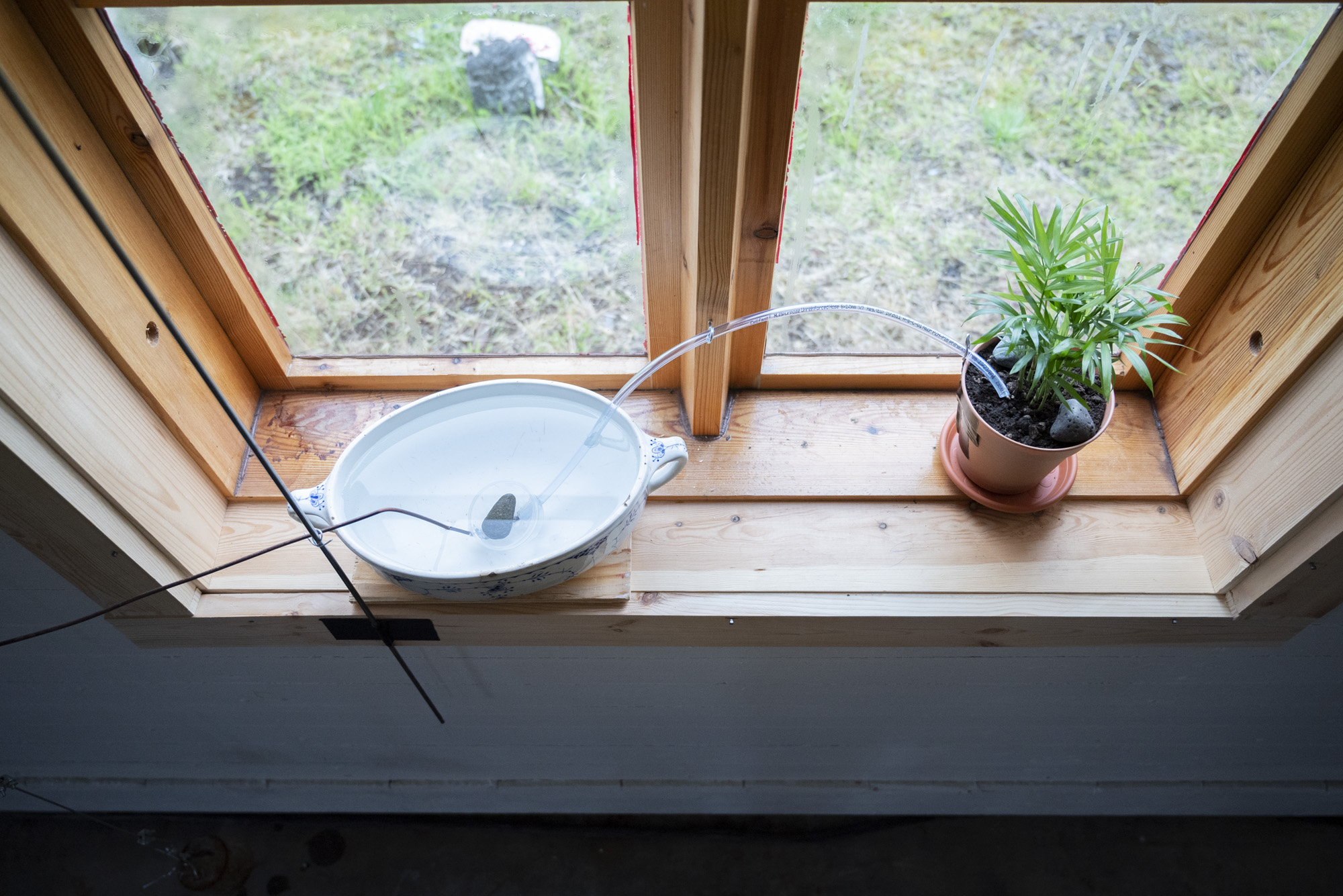
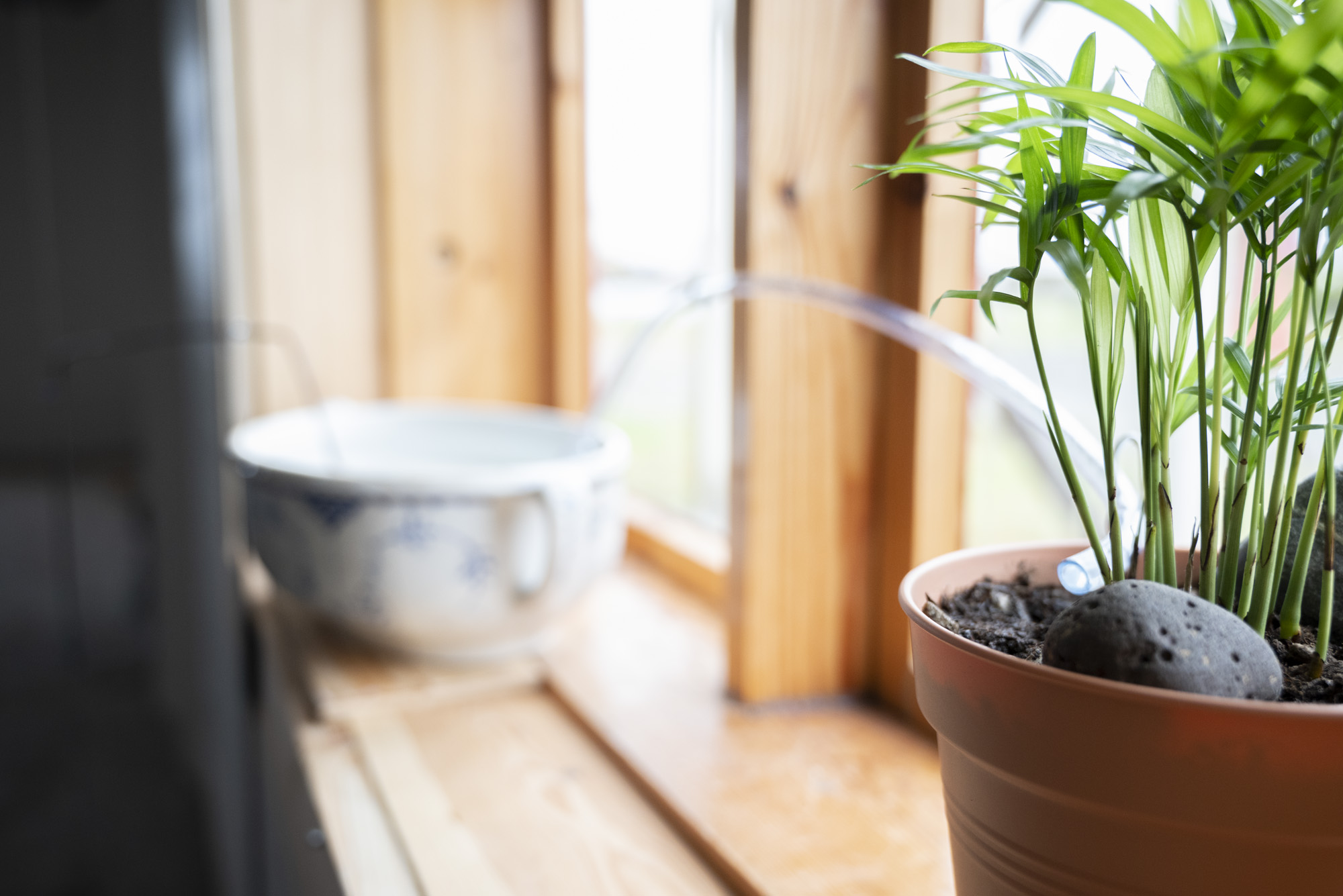
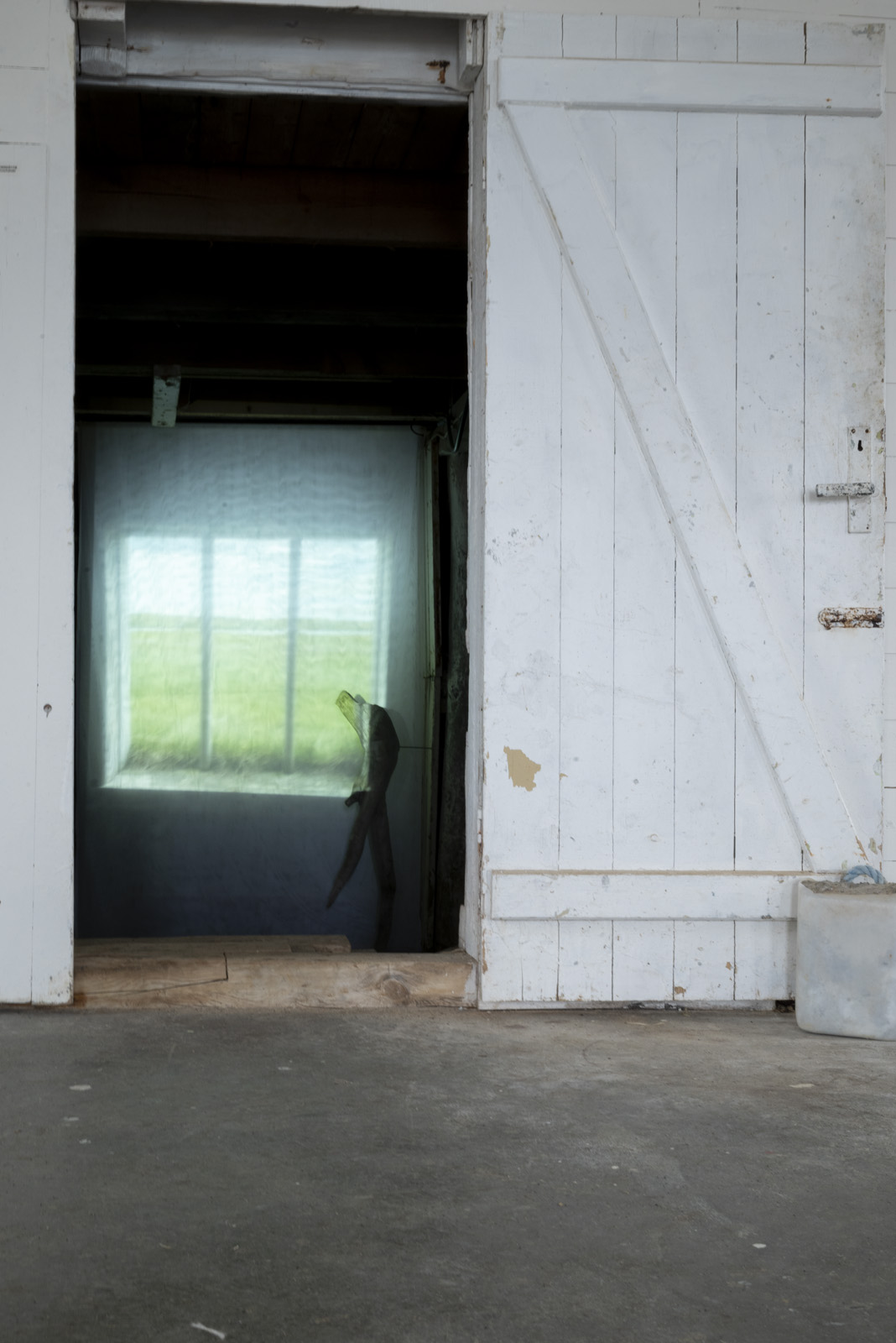
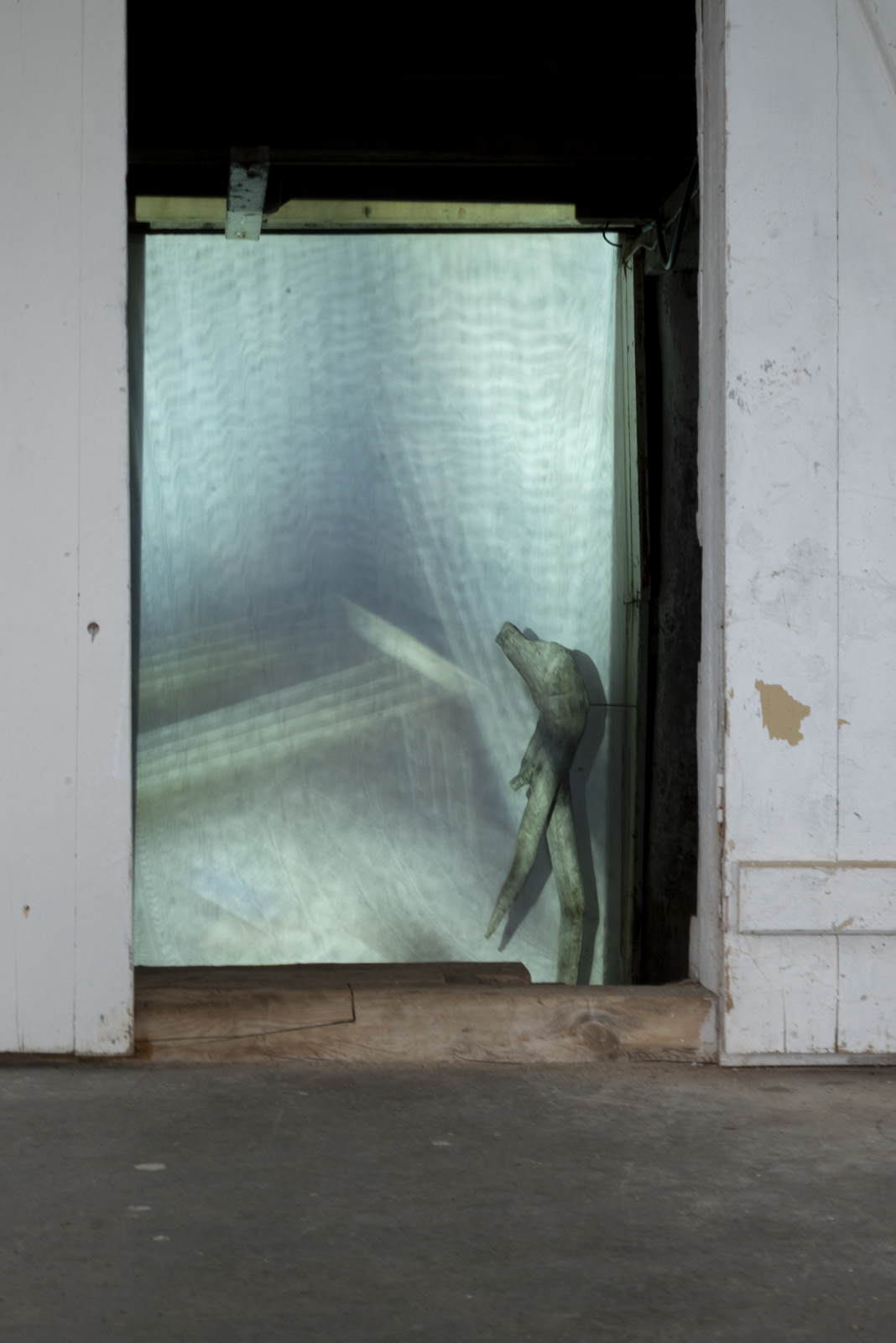
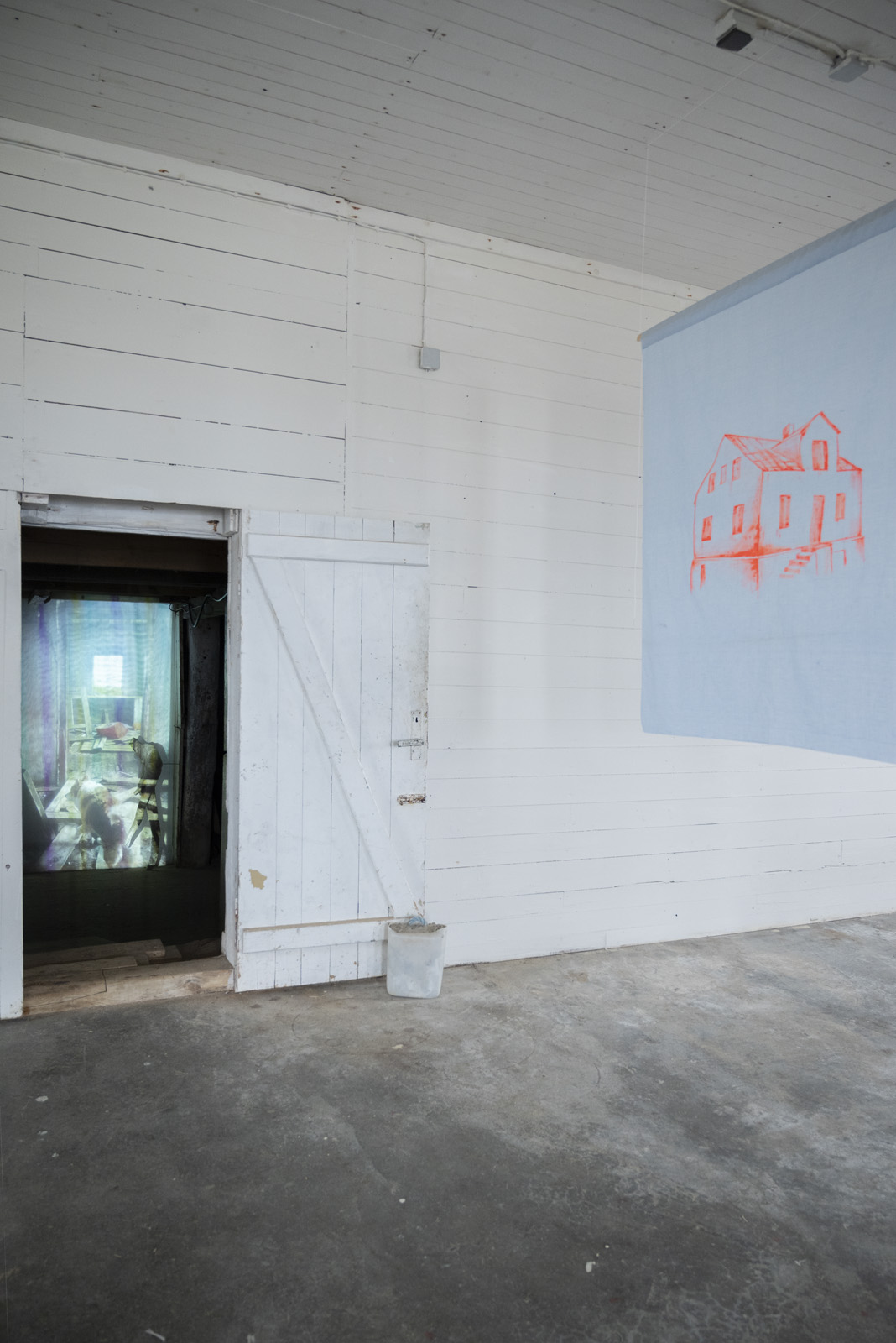
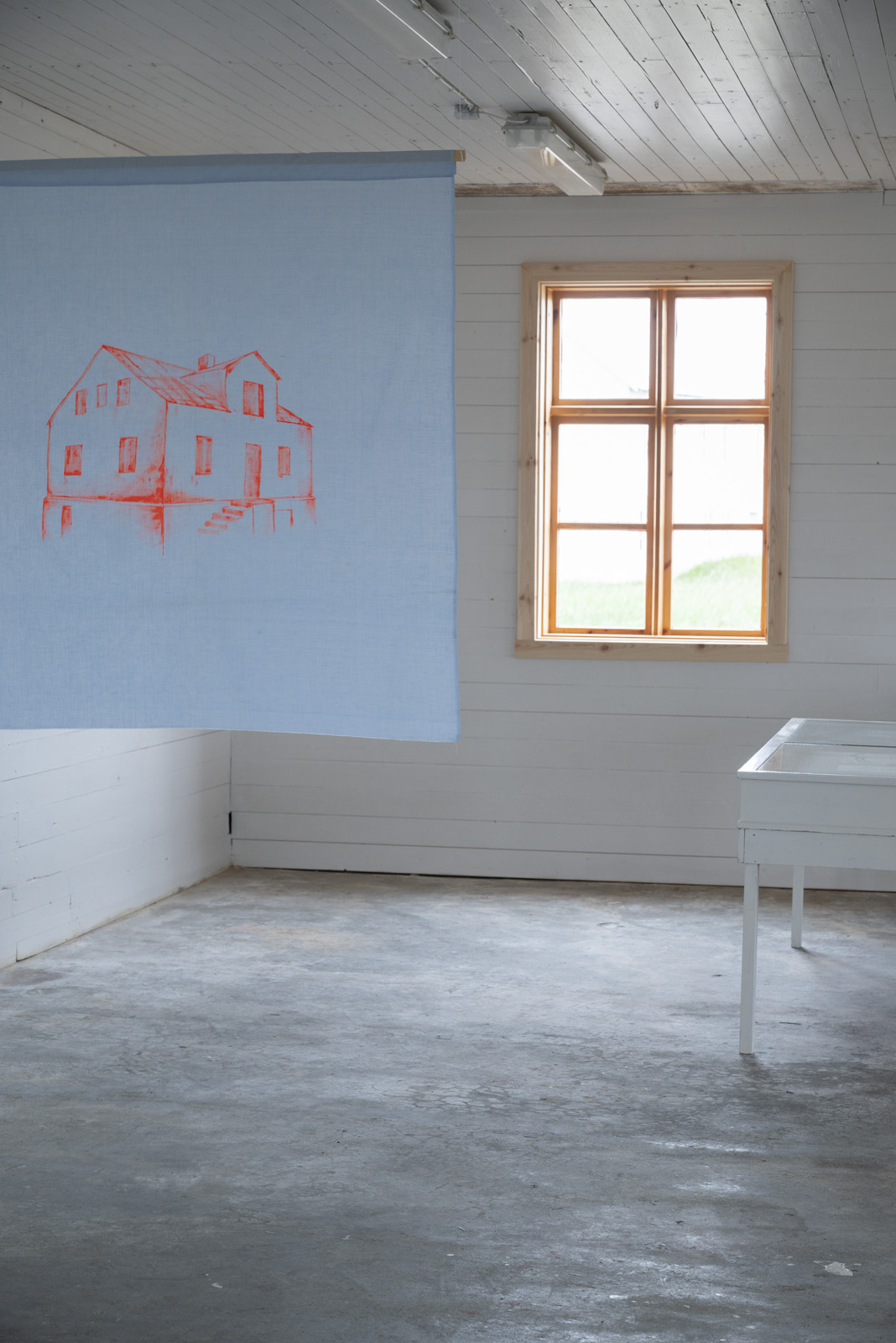
Kristín Reynisdóttir
Frjósemi og hverfulleiki
I have spent a few days in the last 4 summers on Melrakaslétta with a camera and a drawing pad, the biodiversity of the place fascinates me, the trout in the lakes, the birds, the flora, the mushrooms and the berries.
The driftwood that the sea has carefully polished speaks to me, a tree that had its roots growing in an unknown land, which drew nourishment from the soil into its vascular system, has given itself back to mother earth.
A shift has started to creep in, the Holtasóley (Eightpetal mountain-avens) are fighting for their lives, and as the climate crisis evolves, nature slowly takes over a house that stands like a sand-blasted rock with its own heartbeat.
The farm named Rif on Melrakkaslétta, at the northern tip of Iceland, bears witness to the optimism that once lived there, but when a large wave hit the shore in 1934 it took away what made the place what it was.
Rifstangi exhibits a diverse meeting point of land and sea. As I walk around the farm, my senses are alert, the flowers speak to me, and the arctic terns make themself heard and keep an eye on me. I feel connected to the past, as if time stands still, and tread carefully around the place.
Frjósemi og hverfulleiki
I have spent a few days in the last 4 summers on Melrakaslétta with a camera and a drawing pad, the biodiversity of the place fascinates me, the trout in the lakes, the birds, the flora, the mushrooms and the berries.
The driftwood that the sea has carefully polished speaks to me, a tree that had its roots growing in an unknown land, which drew nourishment from the soil into its vascular system, has given itself back to mother earth.
A shift has started to creep in, the Holtasóley (Eightpetal mountain-avens) are fighting for their lives, and as the climate crisis evolves, nature slowly takes over a house that stands like a sand-blasted rock with its own heartbeat.
The farm named Rif on Melrakkaslétta, at the northern tip of Iceland, bears witness to the optimism that once lived there, but when a large wave hit the shore in 1934 it took away what made the place what it was.
Rifstangi exhibits a diverse meeting point of land and sea. As I walk around the farm, my senses are alert, the flowers speak to me, and the arctic terns make themself heard and keep an eye on me. I feel connected to the past, as if time stands still, and tread carefully around the place.
Margrét H. Blöndal
Mylsna / Feed
Waxpaper from the forties found me. Pigment and oil pull the threads. Narwhaletusk from Greenland become unicornhorns within the Vatican treasures. One should neither underestimate the importance of the root system nor the cohabitation of herbs and flowers in one square. The Loom – the appeased bird – entangled in a fishingnet, pecks at its rescuer’s eyes. Herring barrels roll around. A youngster plays the accordion. The stories flickering between his hands.
Mylsna / Feed
Waxpaper from the forties found me. Pigment and oil pull the threads. Narwhaletusk from Greenland become unicornhorns within the Vatican treasures. One should neither underestimate the importance of the root system nor the cohabitation of herbs and flowers in one square. The Loom – the appeased bird – entangled in a fishingnet, pecks at its rescuer’s eyes. Herring barrels roll around. A youngster plays the accordion. The stories flickering between his hands.
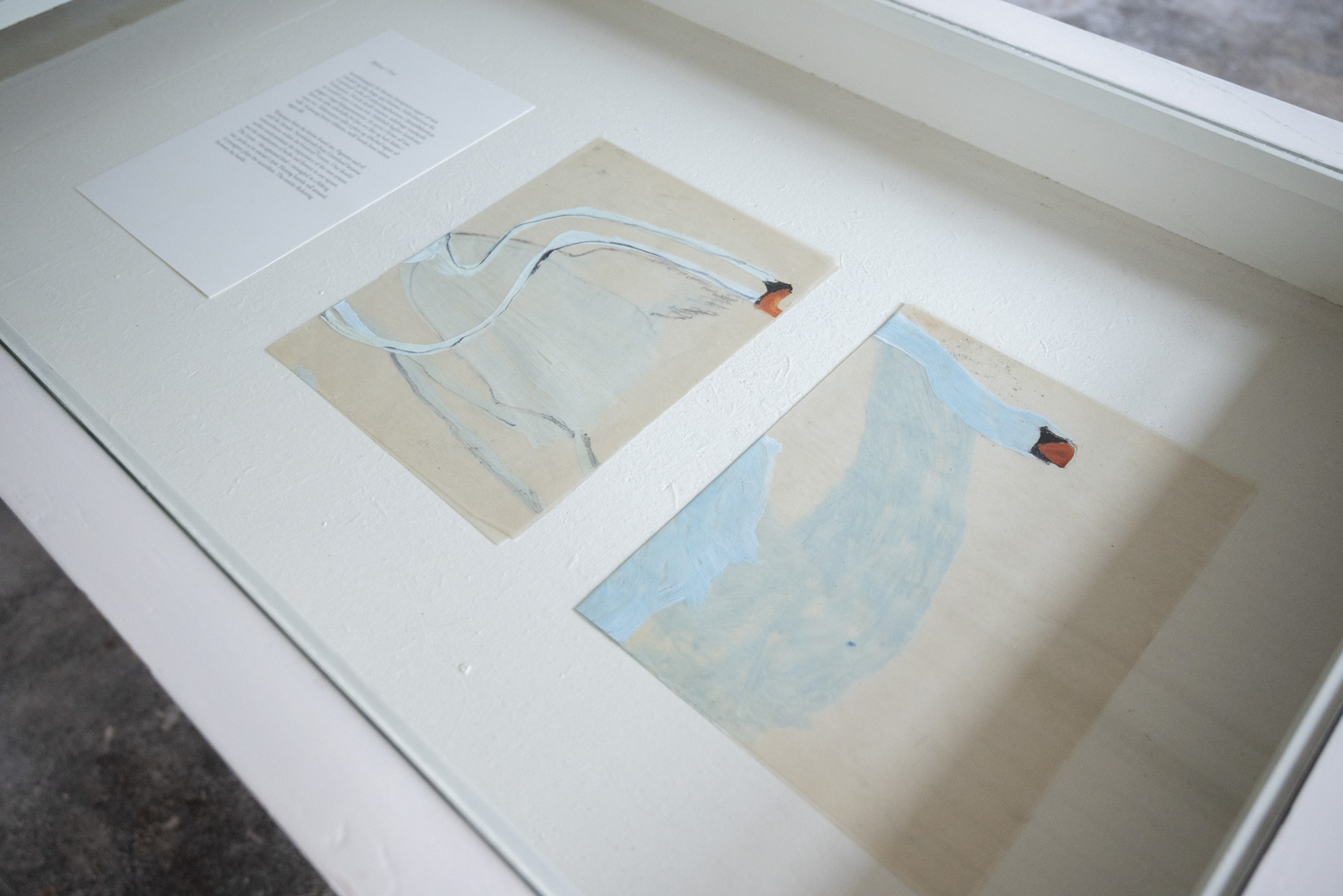
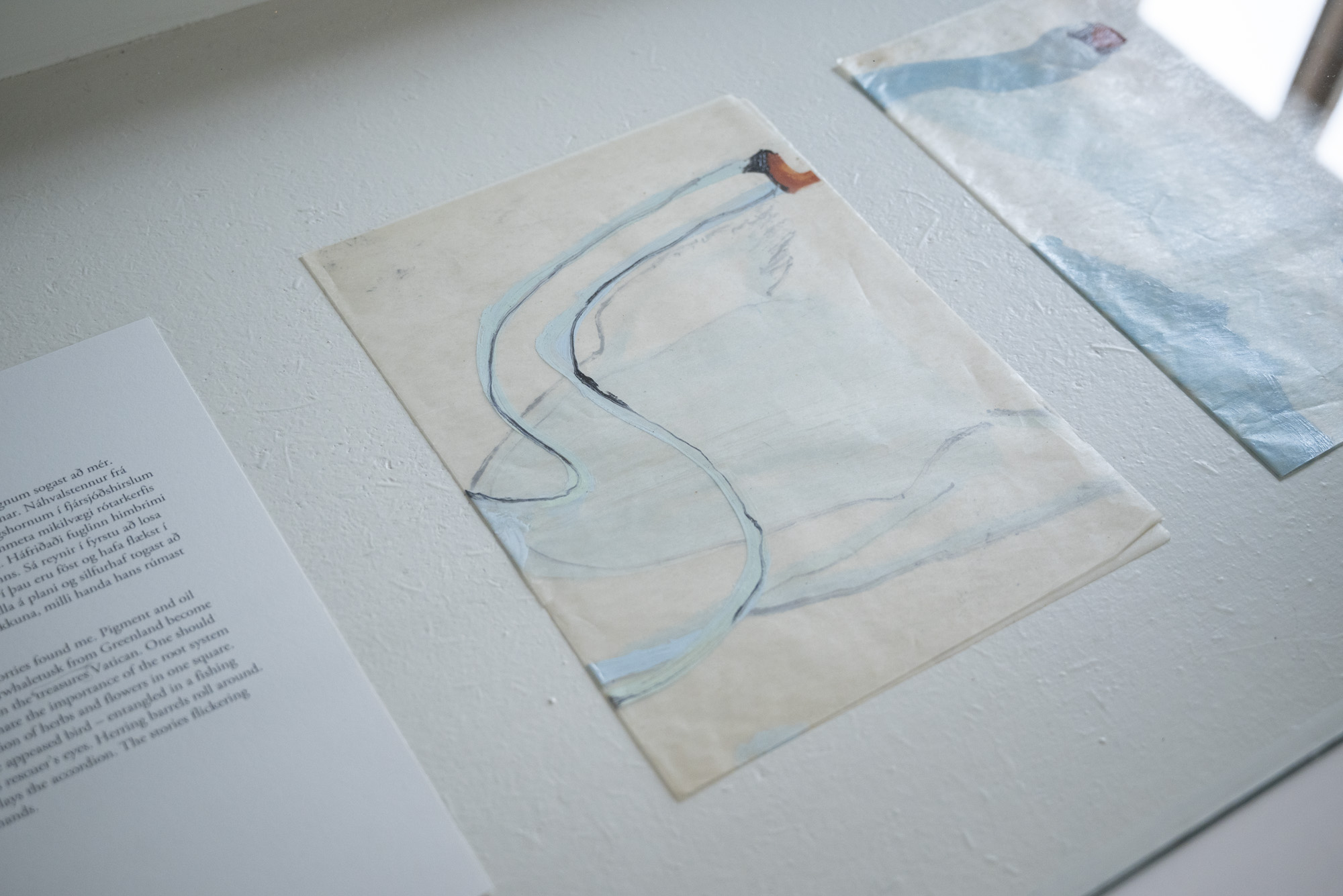
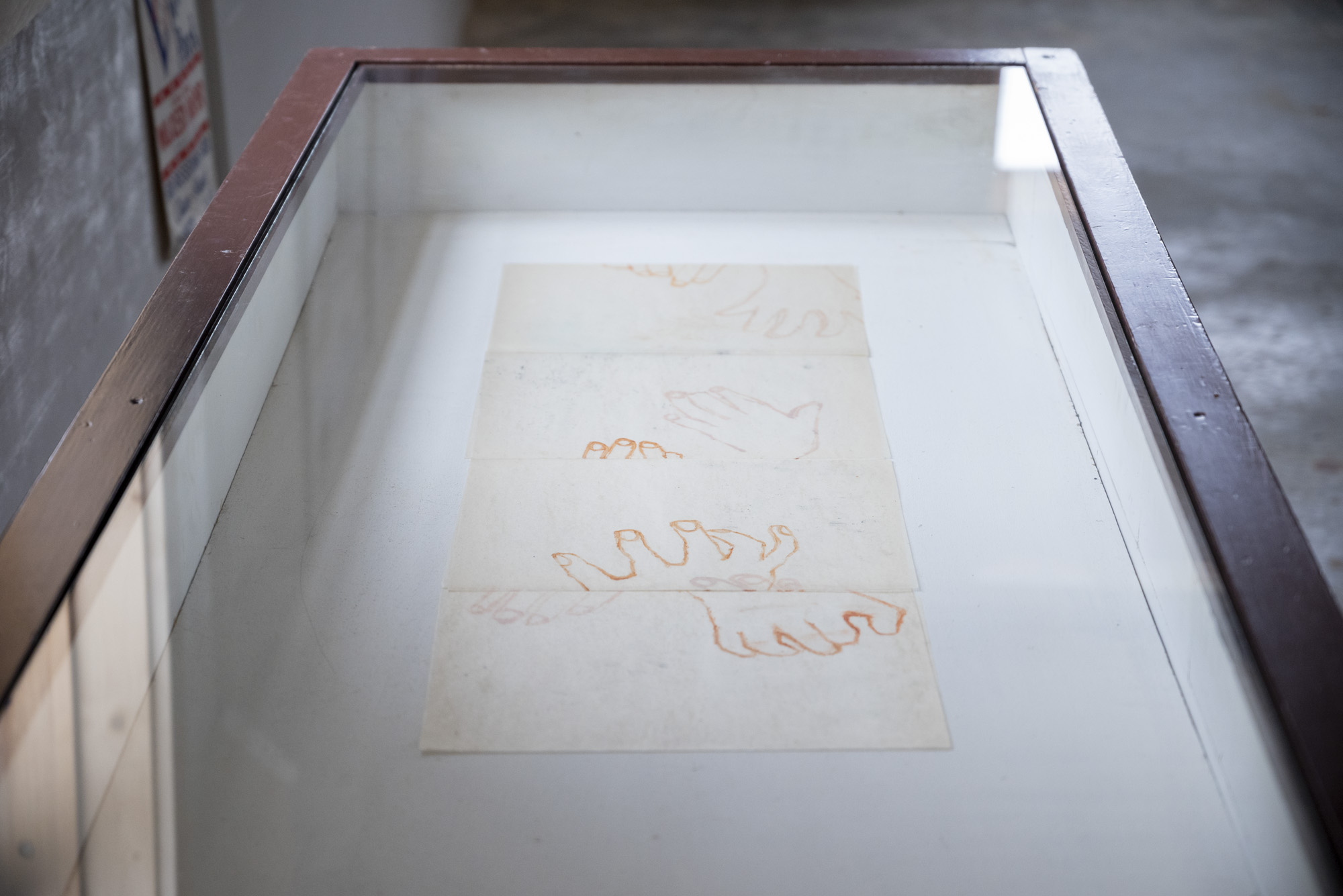




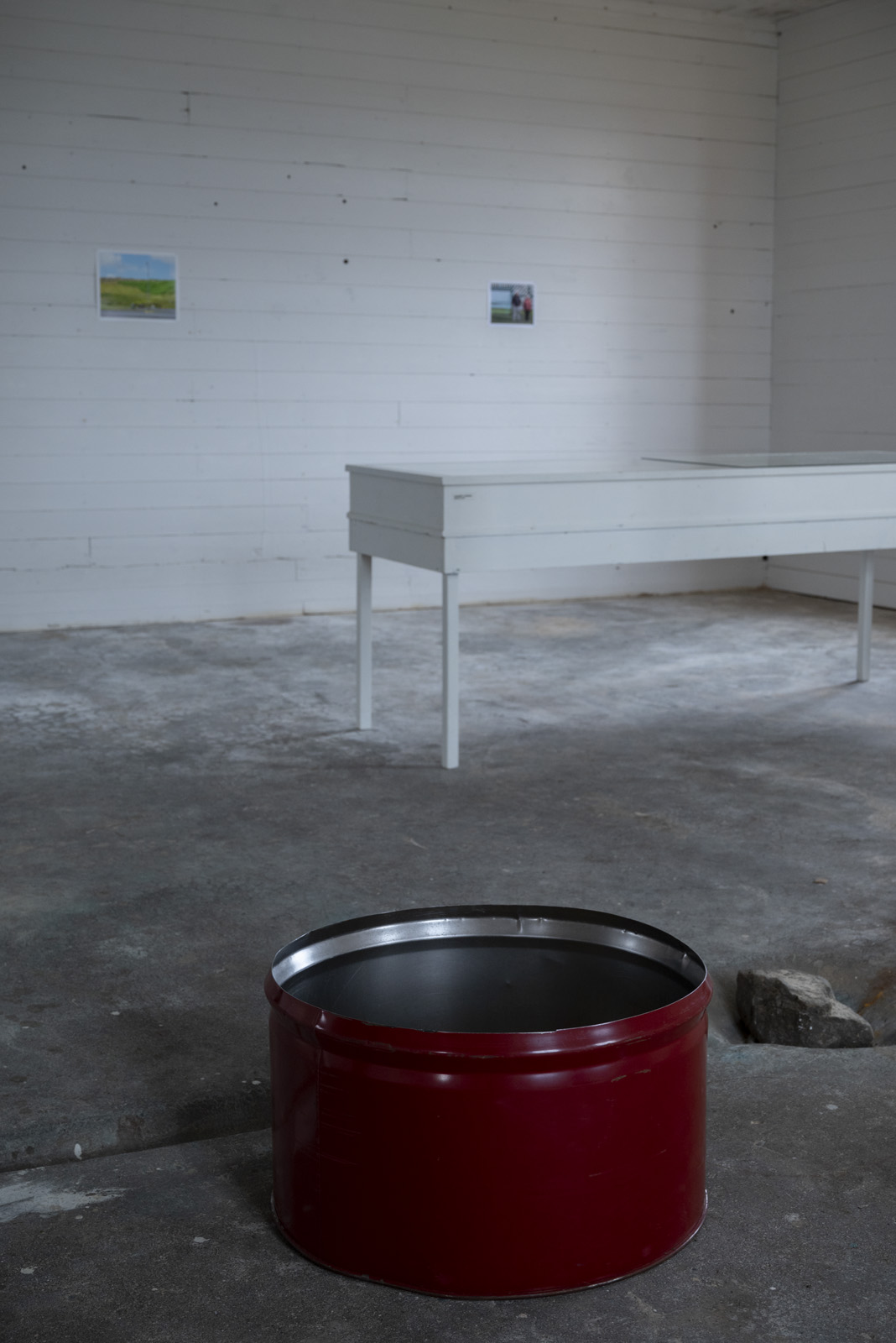
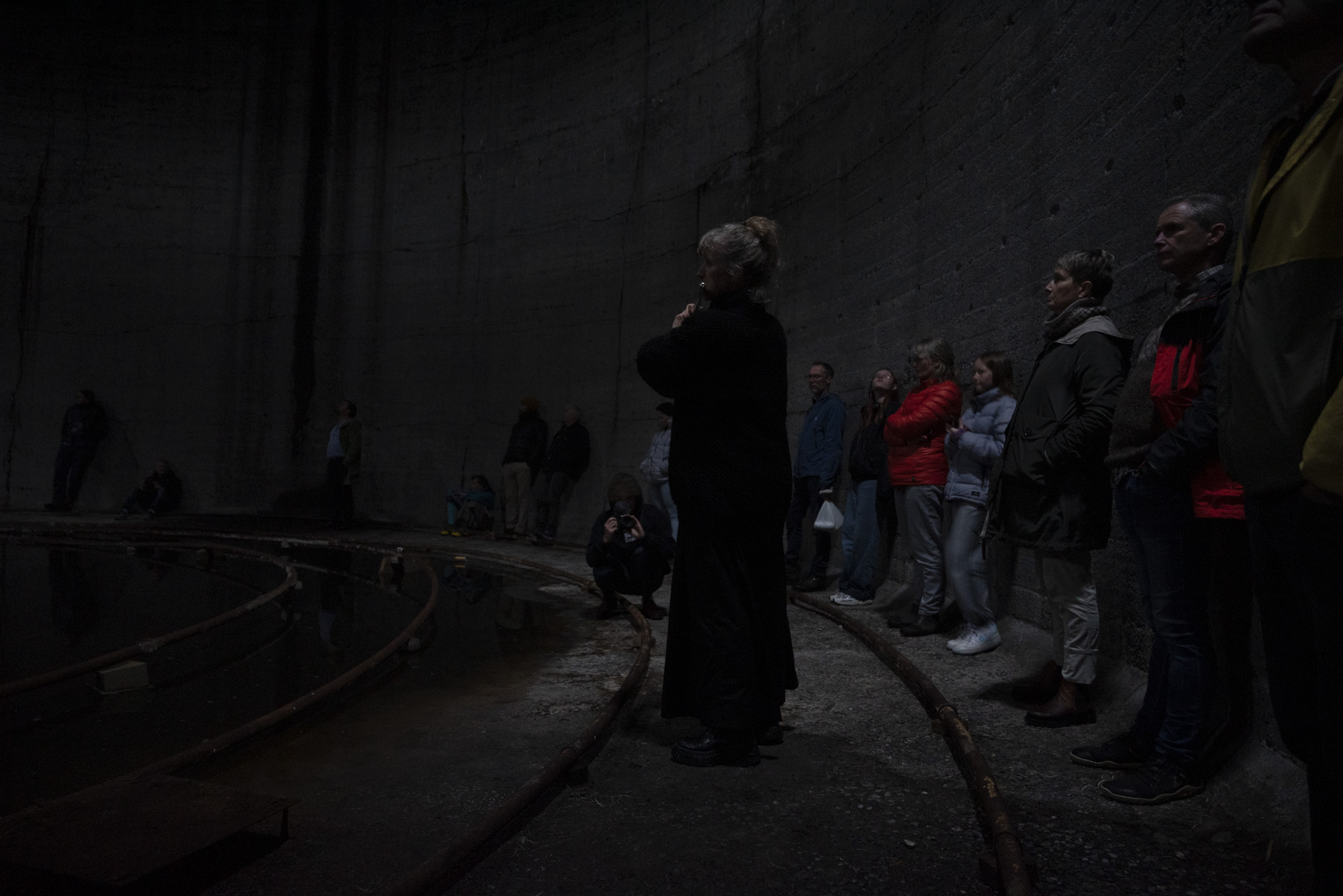
Berglind María Tómasdóttir
Minni
The work is inspired by an old silo situated in Raufarhöfn. During my visits to Raufarhöfn for the past summers I frequently went inside the silo and enjoyed the surroundings and atmosphere. The mood was exalted and somewhat beyond time. During these visits, I played the flute and enjoyed playing into and with the reverberations of the silo. These moments could be called duets for flute and silo because it became an active part of the performance.
Memory; Beyond Time is inspired by these visits, by a silo that has lost its former function and stands empty and abandoned, as a monument to Raufarhöfn’s past. At the same time, it gains a new role; the tank turns into a resonating concert hall full of magic. The sound recording was done in
St. Jósefsspítali, Hafnarfjörður (another space that has lost its former purpose) in November 2023 by Kurt Uenala. Performing with me is Júlía Mogensen on halldorophone.
Minni
The work is inspired by an old silo situated in Raufarhöfn. During my visits to Raufarhöfn for the past summers I frequently went inside the silo and enjoyed the surroundings and atmosphere. The mood was exalted and somewhat beyond time. During these visits, I played the flute and enjoyed playing into and with the reverberations of the silo. These moments could be called duets for flute and silo because it became an active part of the performance.
Memory; Beyond Time is inspired by these visits, by a silo that has lost its former function and stands empty and abandoned, as a monument to Raufarhöfn’s past. At the same time, it gains a new role; the tank turns into a resonating concert hall full of magic. The sound recording was done in
St. Jósefsspítali, Hafnarfjörður (another space that has lost its former purpose) in November 2023 by Kurt Uenala. Performing with me is Júlía Mogensen on halldorophone.
Bryndís Snæbjörnsdóttir & Mark Wilson
Watchtower I, II & III
The duo Bryndís Snæbjörnsdóttir and Mark Wilson have two related works in this exhibition – one installation involves the old lighthouse situated between the town lake and the seashore – and the other, inside the Óskarbraggi building, comprising three proposals for watchtowers. Each of the proposals is related to a particular historical event in which polar bears came to the shores of Raufarhöfn. The watchtowers are intended both as memorials to the bears involved and as prospective viewing platforms to enable early sightings of approaching animals from the sea. This idea signals an imagined shift in the way we humans might regard animals with whom we share the environment, and reflects modest allowances and investment in the welfare of animal others, already in place around the world. Polar bears have come to Iceland for many millennia before the arrival of humans, and in this shift, future arrivals might be planned for and handled by people in generally a more imaginative and sympathetic manner.
At the lighthouse, the windows have been blanked with images of bones salvaged from one, the female, of two polar bears that arrived in the north of Iceland in June 2008. A three-times mother of 16 years, to get here she had swum over 300 km from Greenland. Although some strategies for her capture and release were considered, in the end, though she was fatigued, she got up from where she had lain for many hours on the shore, and on moving back in the direction of
the sea, was shot dead. In one of the Raufarhöfn reports, from 1969, an already dead polar bear was washed ashore here. In another, from 1914, a bear was tracked down and shot and in a third, in 1965, bears were heard bellowing through the dense mist, far out on the sea ice.
Watchtower I, II & III
The duo Bryndís Snæbjörnsdóttir and Mark Wilson have two related works in this exhibition – one installation involves the old lighthouse situated between the town lake and the seashore – and the other, inside the Óskarbraggi building, comprising three proposals for watchtowers. Each of the proposals is related to a particular historical event in which polar bears came to the shores of Raufarhöfn. The watchtowers are intended both as memorials to the bears involved and as prospective viewing platforms to enable early sightings of approaching animals from the sea. This idea signals an imagined shift in the way we humans might regard animals with whom we share the environment, and reflects modest allowances and investment in the welfare of animal others, already in place around the world. Polar bears have come to Iceland for many millennia before the arrival of humans, and in this shift, future arrivals might be planned for and handled by people in generally a more imaginative and sympathetic manner.
At the lighthouse, the windows have been blanked with images of bones salvaged from one, the female, of two polar bears that arrived in the north of Iceland in June 2008. A three-times mother of 16 years, to get here she had swum over 300 km from Greenland. Although some strategies for her capture and release were considered, in the end, though she was fatigued, she got up from where she had lain for many hours on the shore, and on moving back in the direction of
the sea, was shot dead. In one of the Raufarhöfn reports, from 1969, an already dead polar bear was washed ashore here. In another, from 1914, a bear was tracked down and shot and in a third, in 1965, bears were heard bellowing through the dense mist, far out on the sea ice.

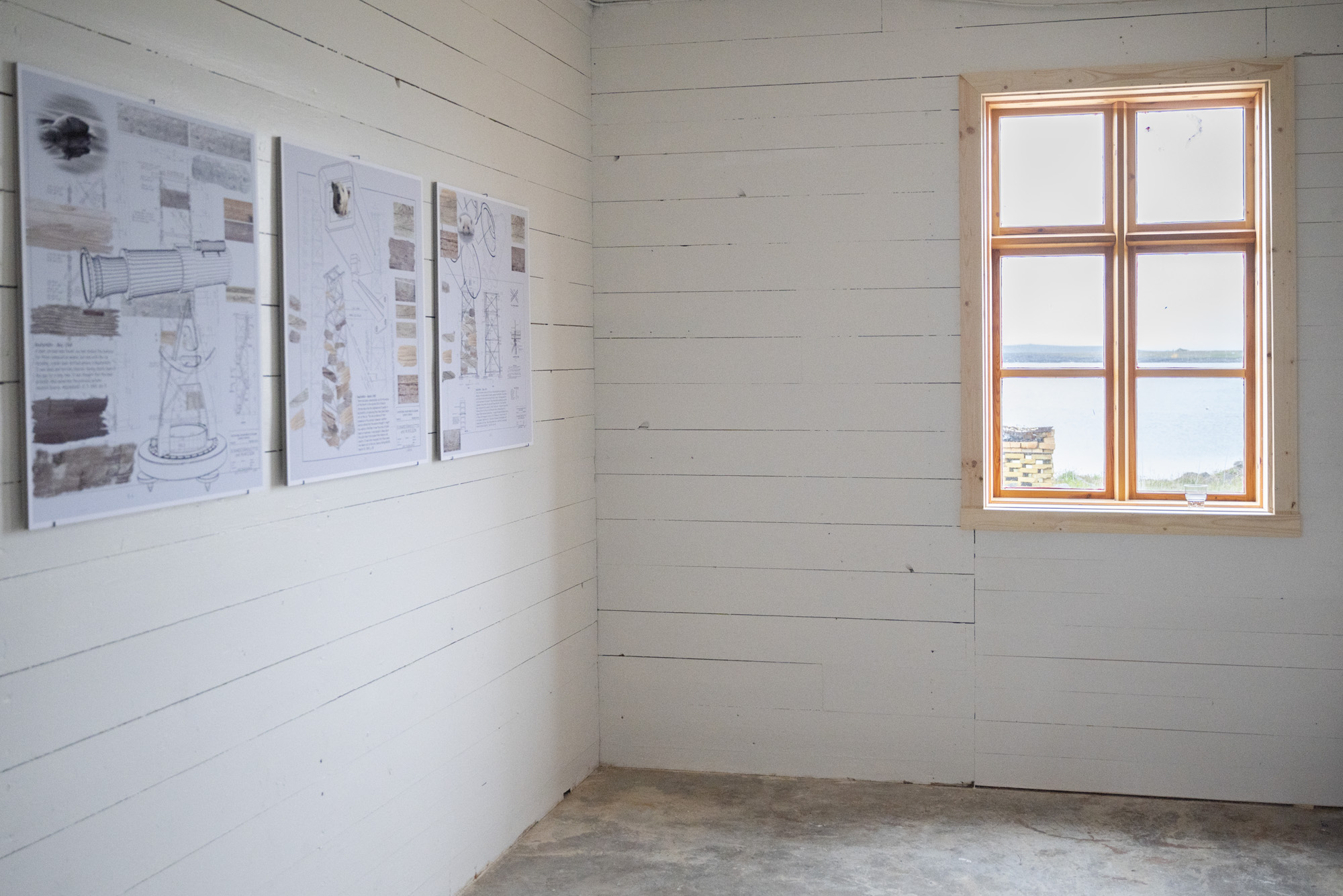

Spreading between floors:
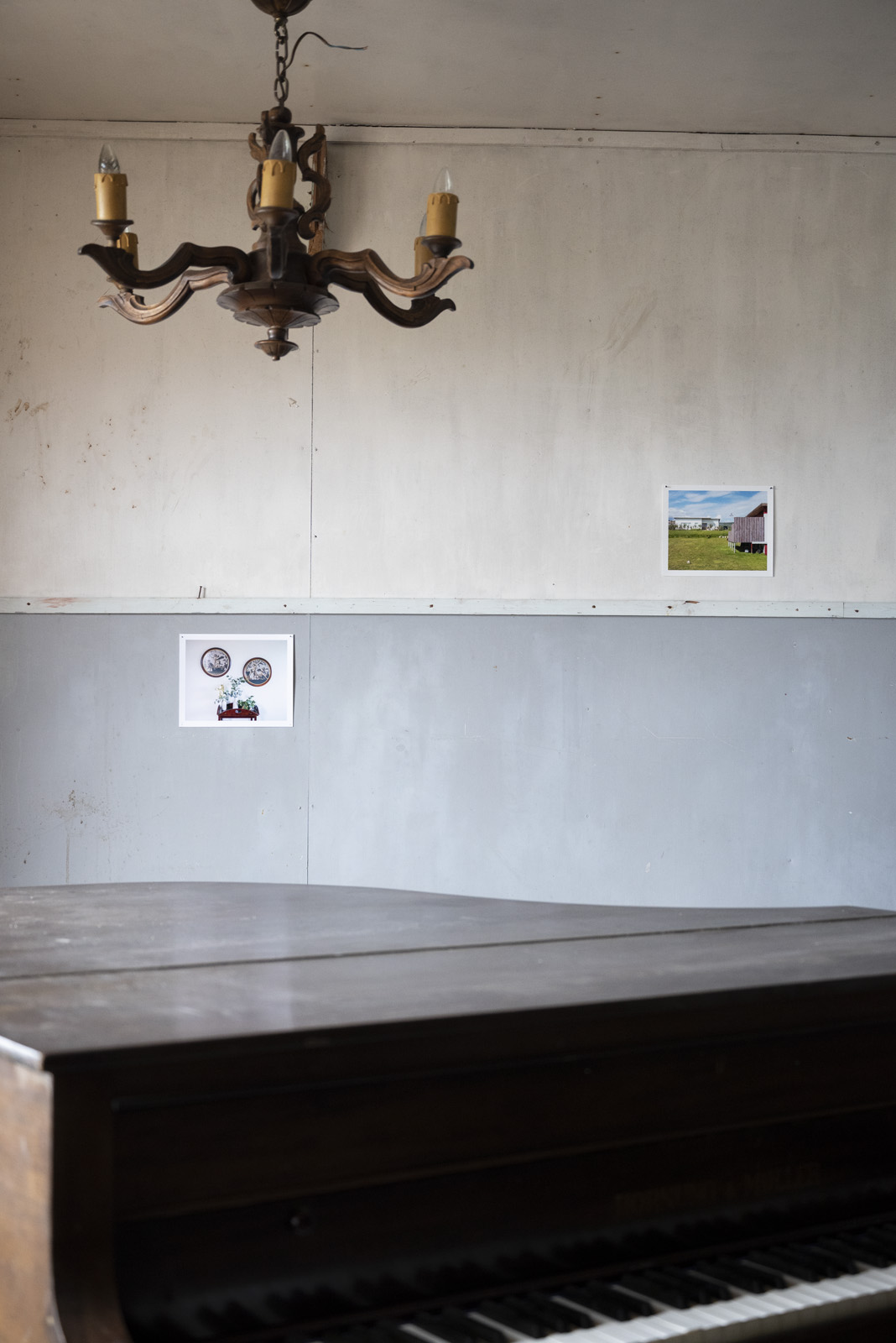
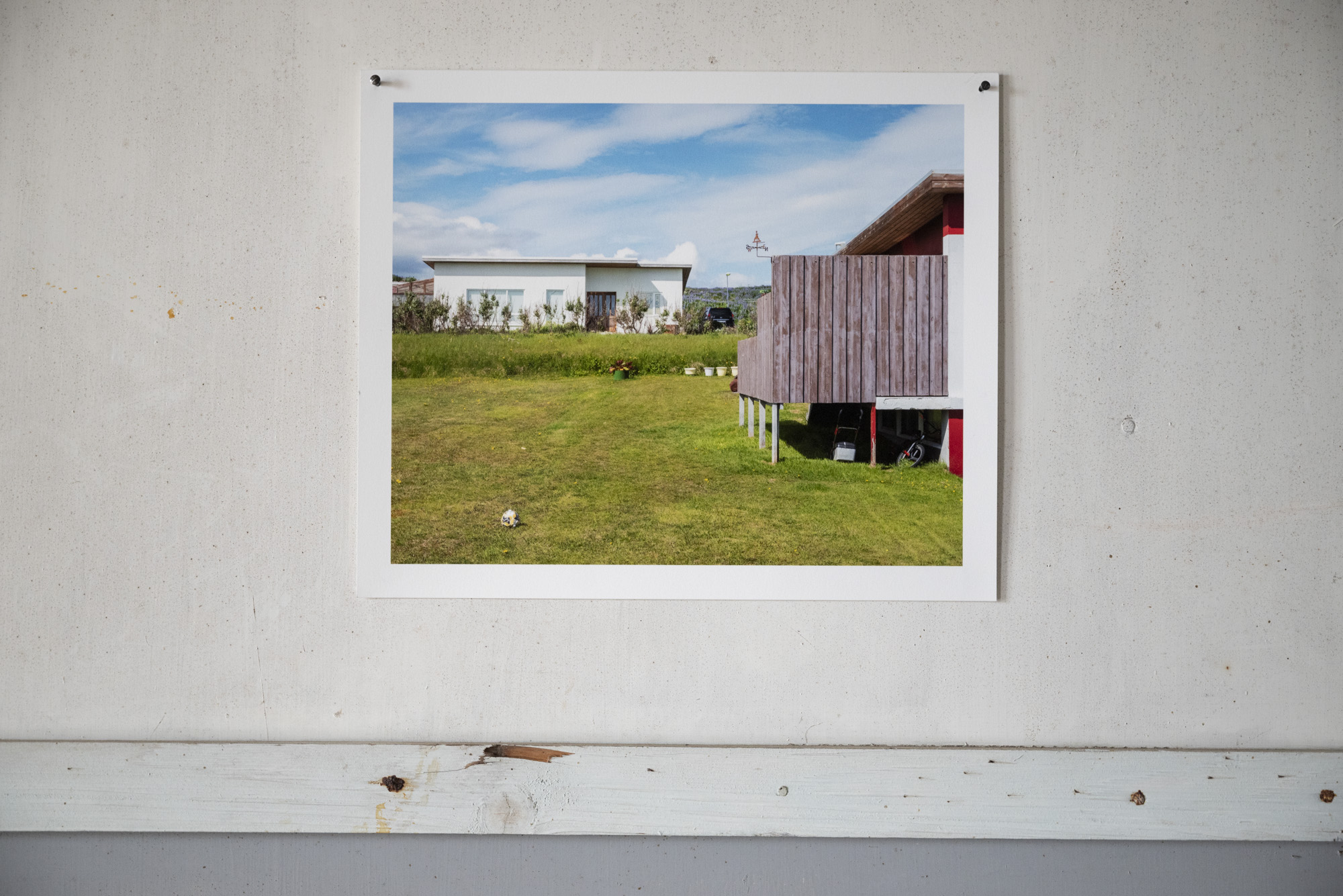
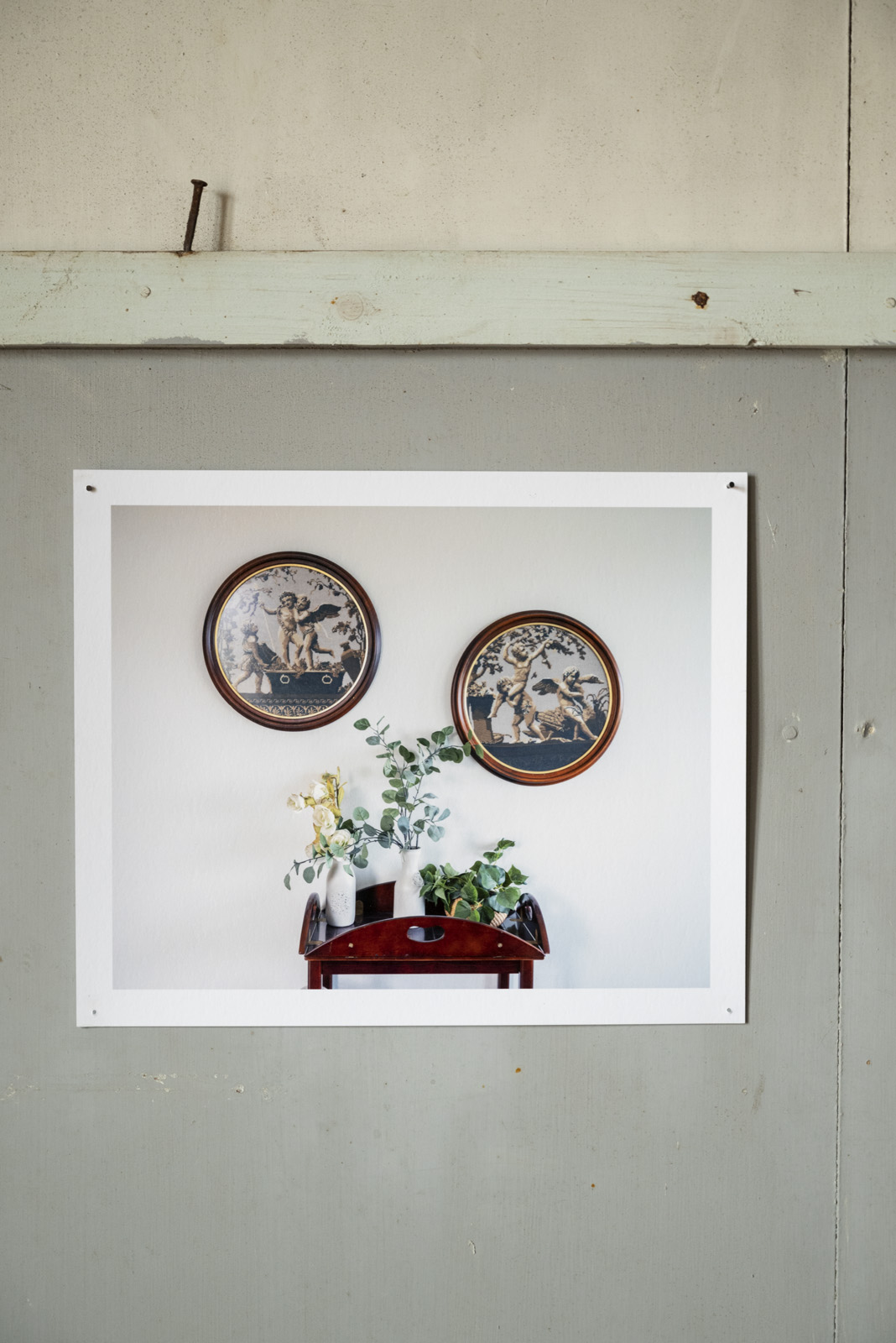

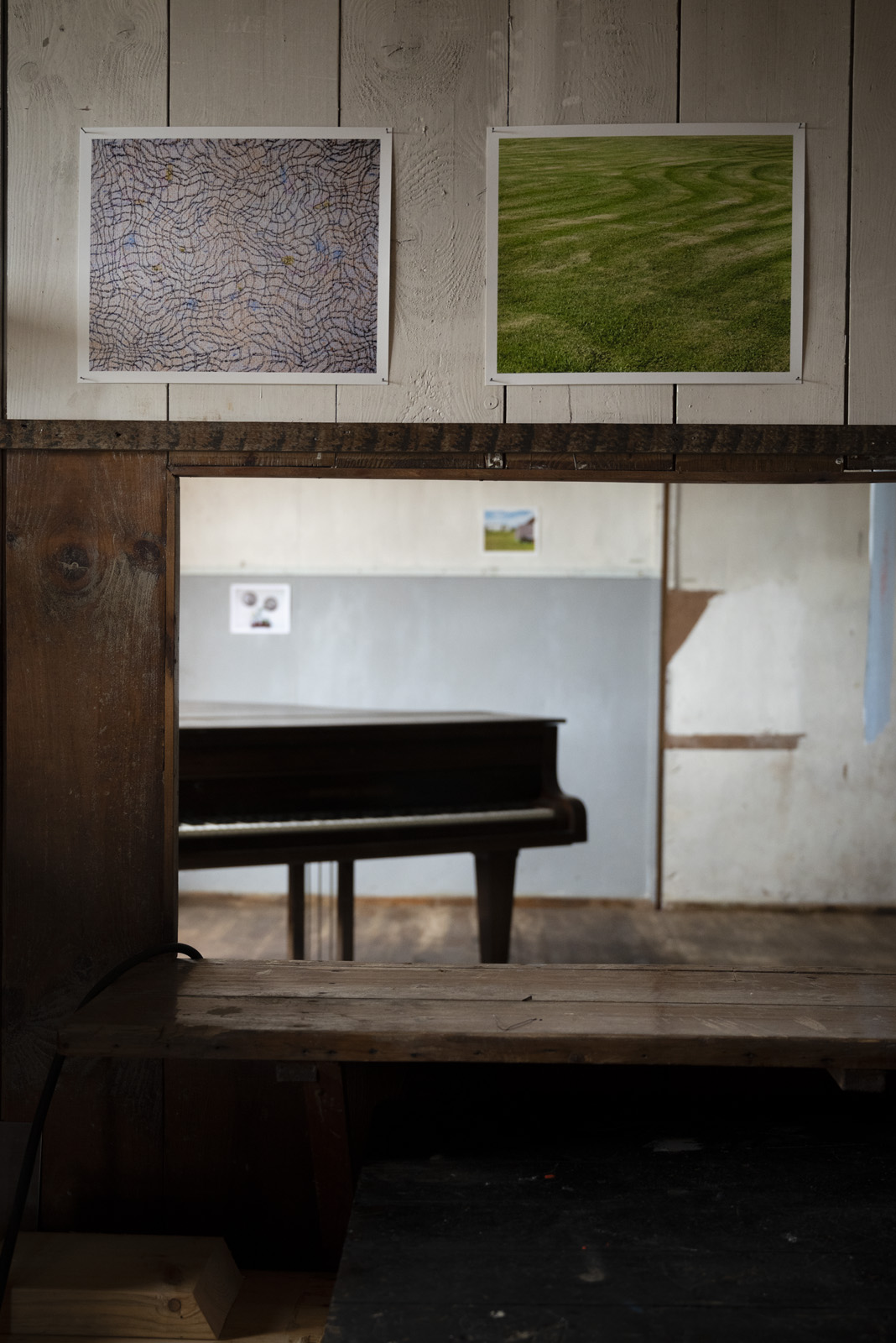


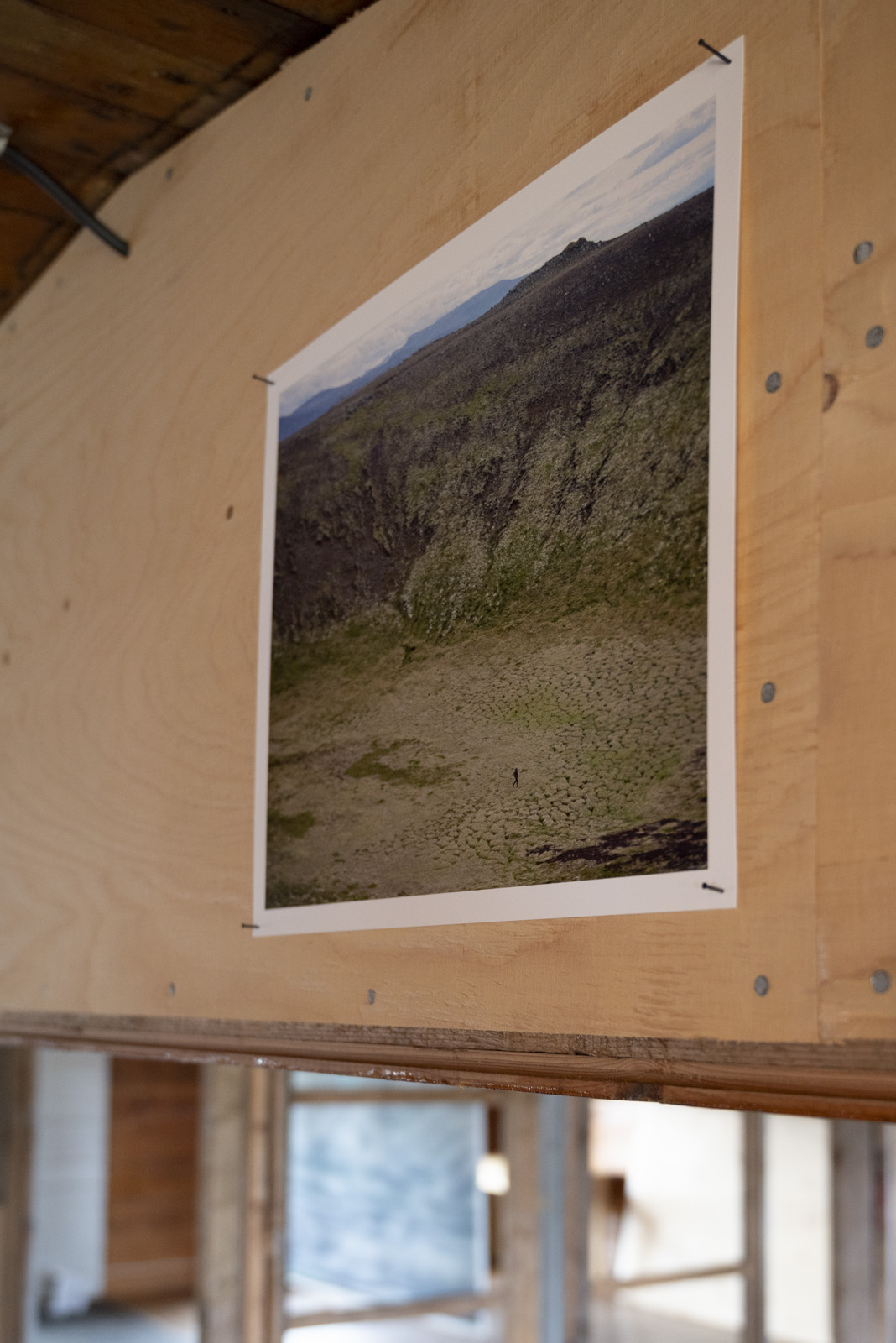
Einar Falur Ingólfsson
From the Slétta Diary
During three visits to Melrakkaslétta and Raufarhöfn in the summers of 2022 and 2023, I kept creating my visual diary.
In photographs, I recorded different experiences as well as meetings with both strangers and acquaintances. In the last few months I have edited the diary and created, through connecting selected photographs, a certain harmony where the individual images can also stand alone and reflect various experiences, as a member of the artist group, from expeditions - both in the village and in the nature around, from conversations with people I met and of the weather. (Big part of the time I represented Iceland in the multinational World Weather Network, where artists selected by 28 visual arts centers created works about the weather).
![]()
![]()
![]()
![]()
![]()
![]()
![]()
![]()
From the Slétta Diary
During three visits to Melrakkaslétta and Raufarhöfn in the summers of 2022 and 2023, I kept creating my visual diary.
In photographs, I recorded different experiences as well as meetings with both strangers and acquaintances. In the last few months I have edited the diary and created, through connecting selected photographs, a certain harmony where the individual images can also stand alone and reflect various experiences, as a member of the artist group, from expeditions - both in the village and in the nature around, from conversations with people I met and of the weather. (Big part of the time I represented Iceland in the multinational World Weather Network, where artists selected by 28 visual arts centers created works about the weather).
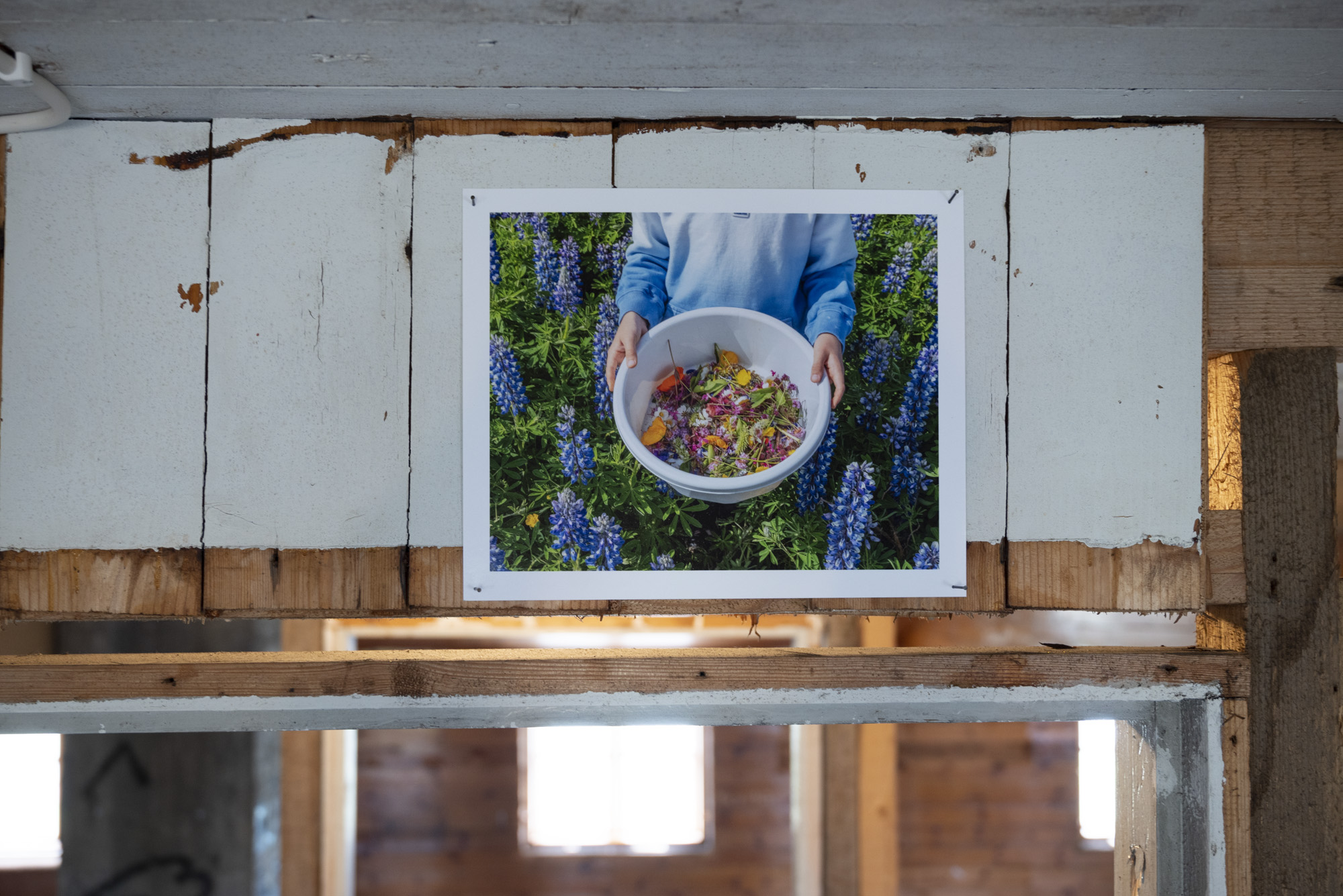
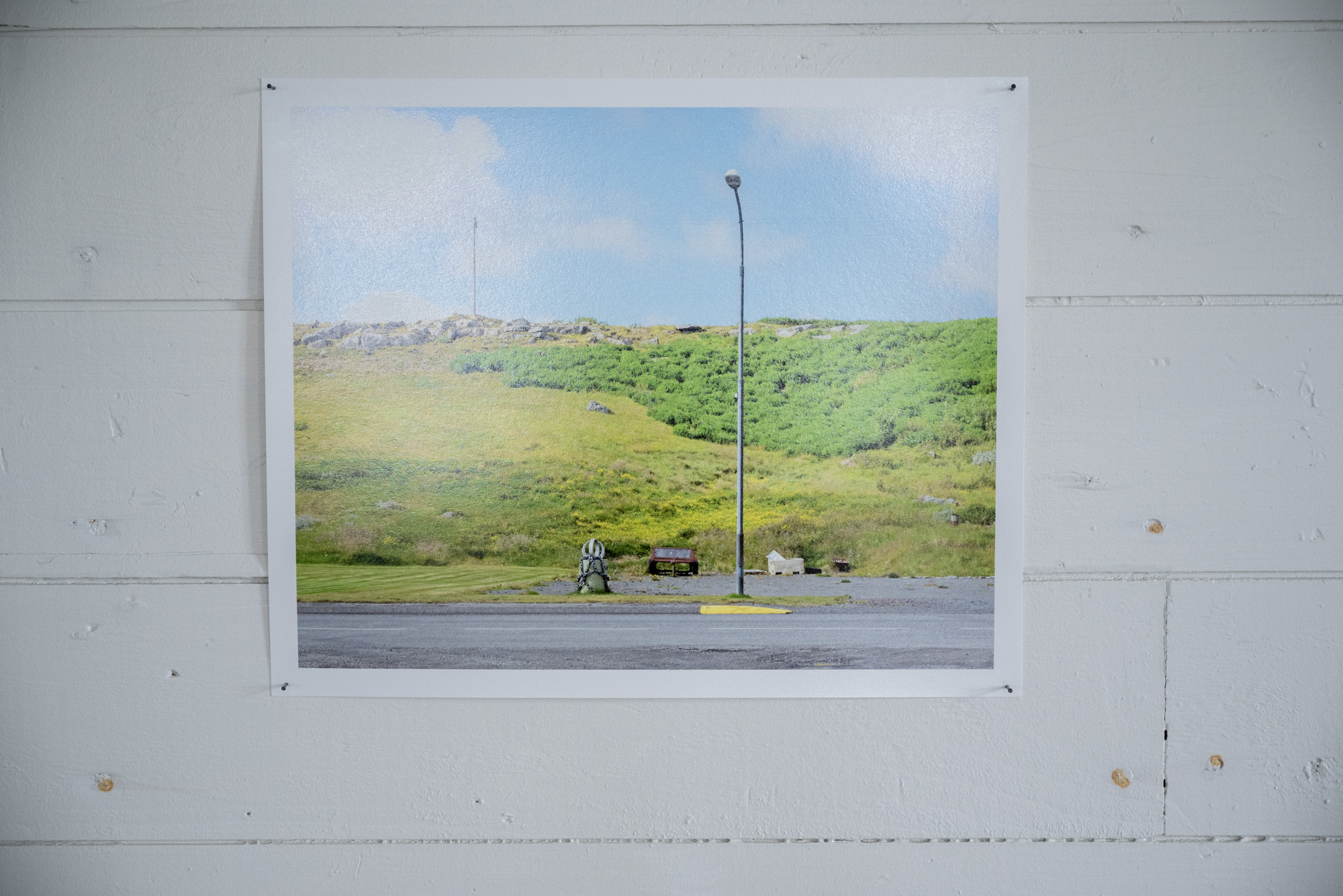
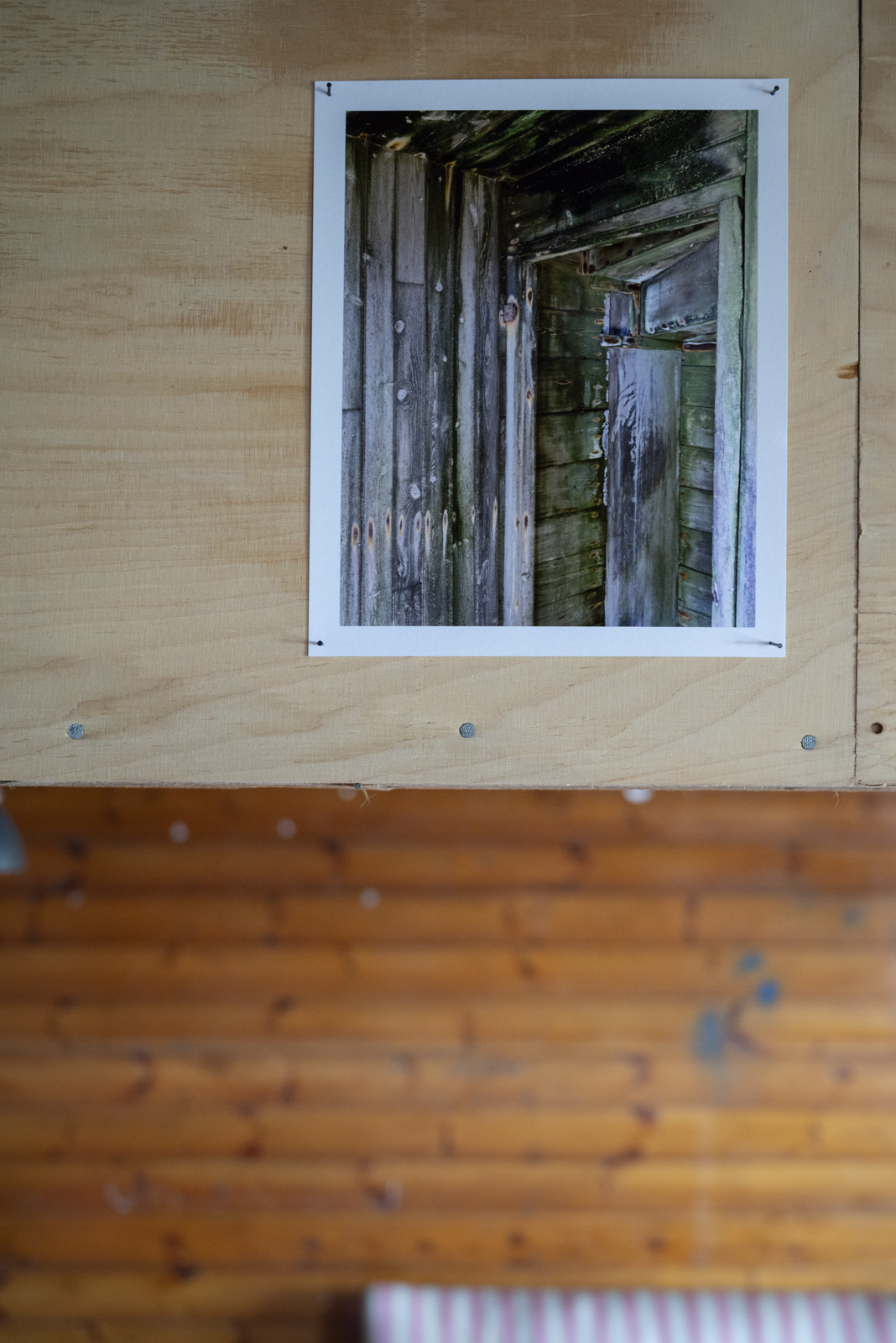

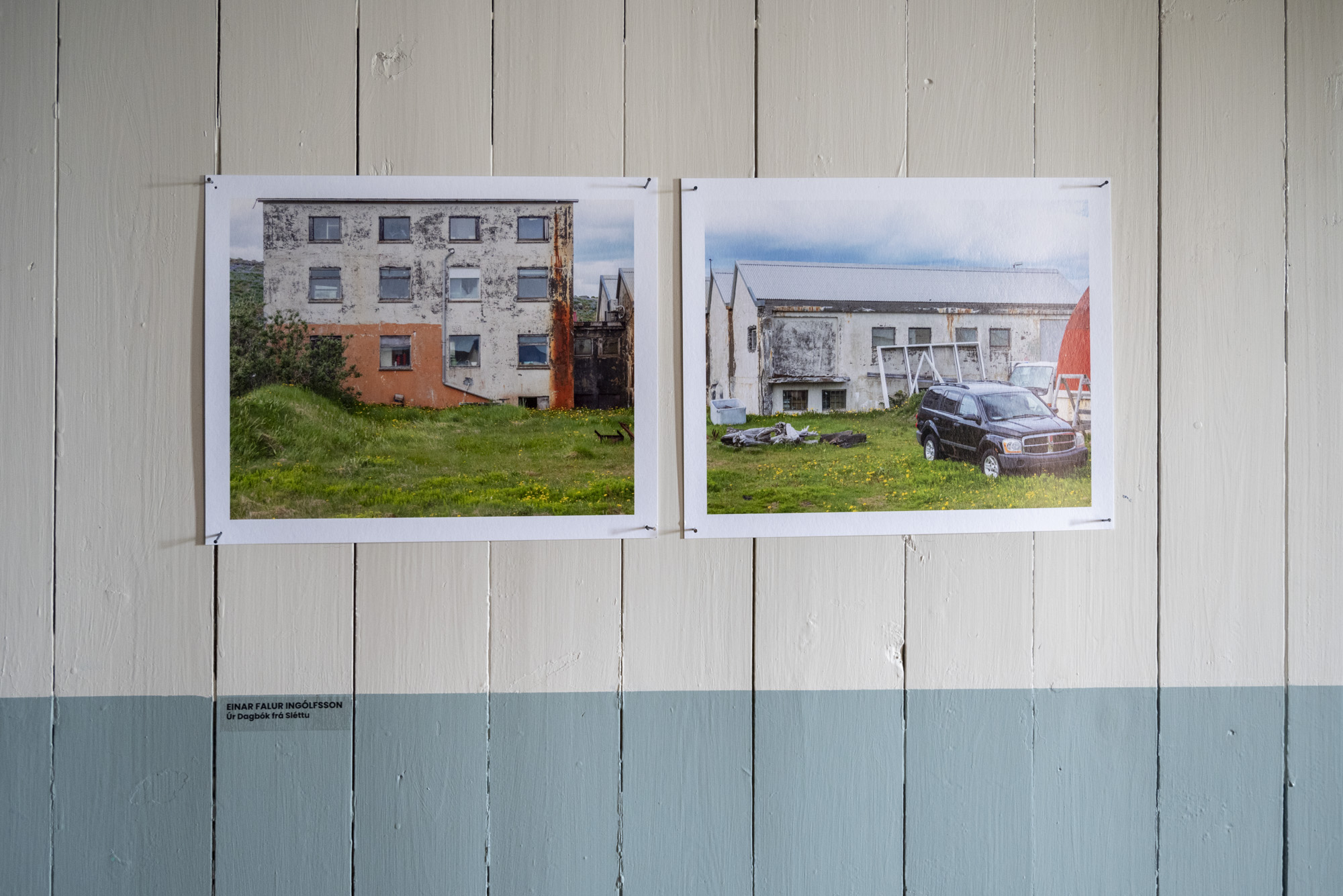

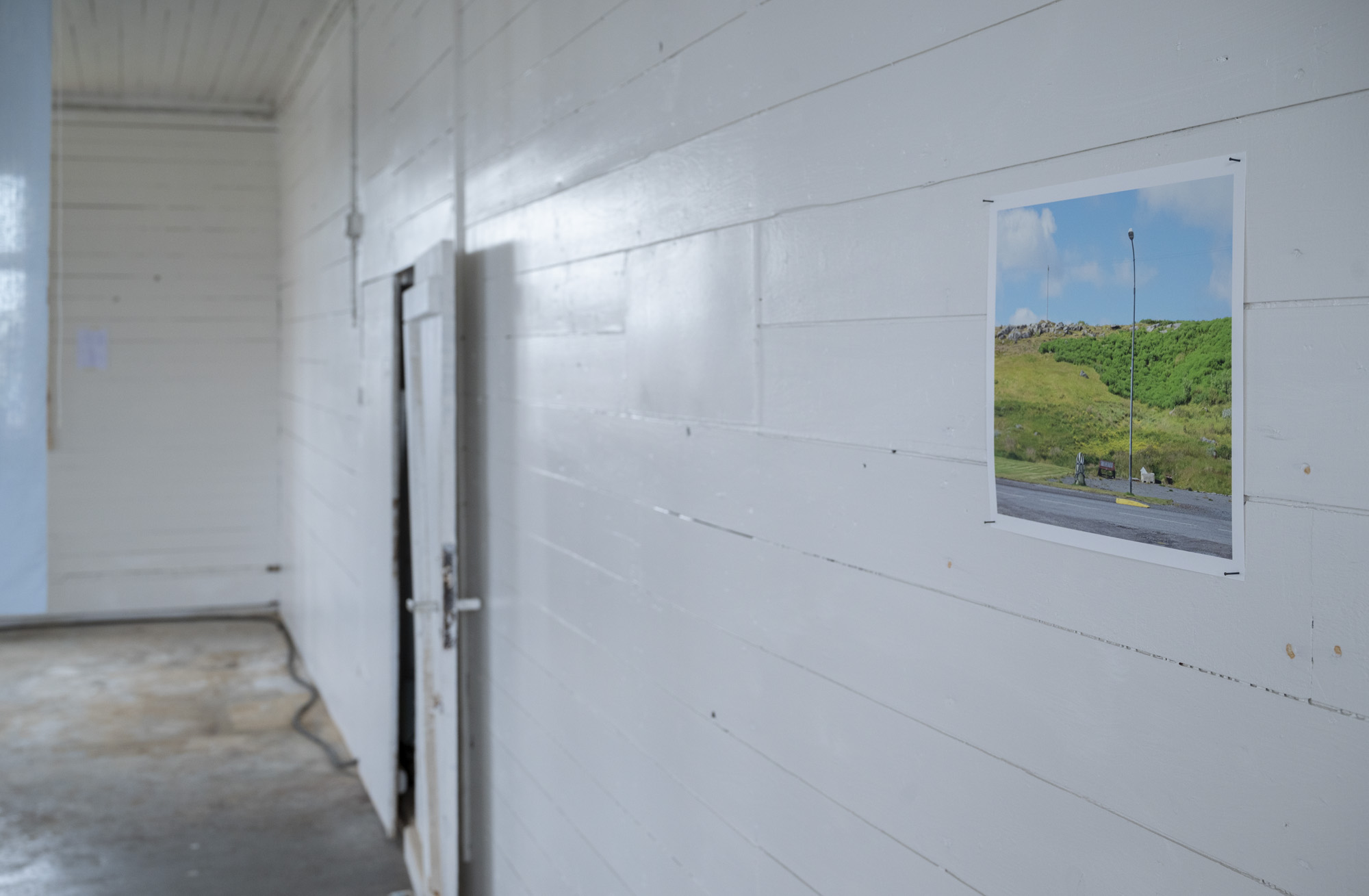

Second Floor:
Þórarinn Blöndal
Hólsstígur
We all put on some kind of glasses when we look at our country and its nature. The shepherd walks around the
farm and sees it with different eyes than a tourist does. We go on various errands to the mountains. Let’s look for a deer, a beautiful flower, maybe a sheep or climb the highest peak.
I intend to make a road map of the road Hólsstígur on Melrakkaslétta, it is an ancient national road that runs across the peninsula and is still clearly identifiable most of the way. The path goes through a varied landscape where you can find mela and móa, hills and valleys, lakes and streams. Most of the path lies on the high ground at about 120 m above sea level.
I will walk Hólsstíg going back in time, through 1000 years, starting around 900 years ago. Although the project revolves around Hólsstígur, I will allow for sidetracks and explore other places around the plain. Moreover, I want to examine the land and its transformations from an objective perspective, aiming to perceive it as it is, without preconceived ideas.
![]()
Hólsstígur
We all put on some kind of glasses when we look at our country and its nature. The shepherd walks around the
farm and sees it with different eyes than a tourist does. We go on various errands to the mountains. Let’s look for a deer, a beautiful flower, maybe a sheep or climb the highest peak.
I intend to make a road map of the road Hólsstígur on Melrakkaslétta, it is an ancient national road that runs across the peninsula and is still clearly identifiable most of the way. The path goes through a varied landscape where you can find mela and móa, hills and valleys, lakes and streams. Most of the path lies on the high ground at about 120 m above sea level.
I will walk Hólsstíg going back in time, through 1000 years, starting around 900 years ago. Although the project revolves around Hólsstígur, I will allow for sidetracks and explore other places around the plain. Moreover, I want to examine the land and its transformations from an objective perspective, aiming to perceive it as it is, without preconceived ideas.
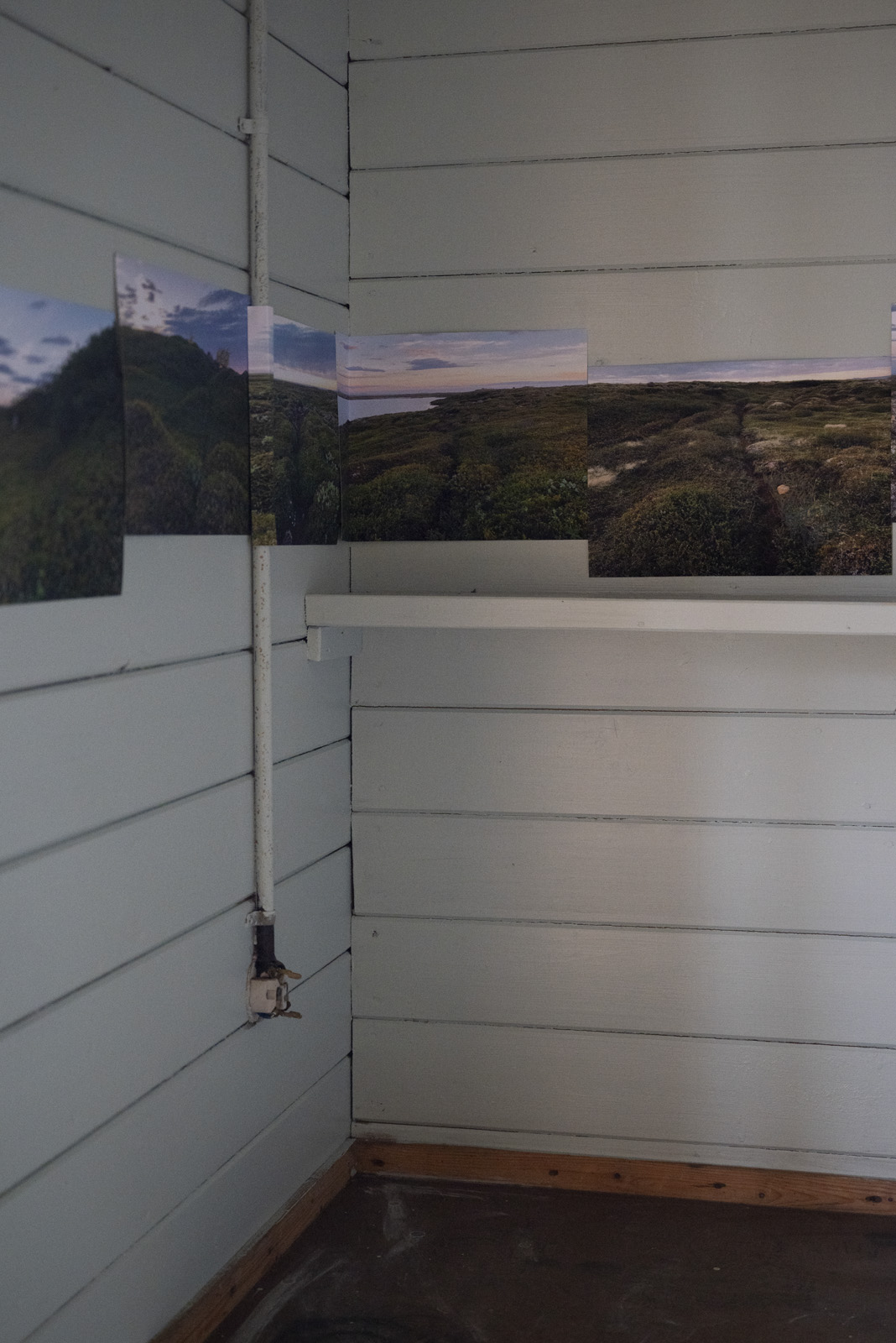
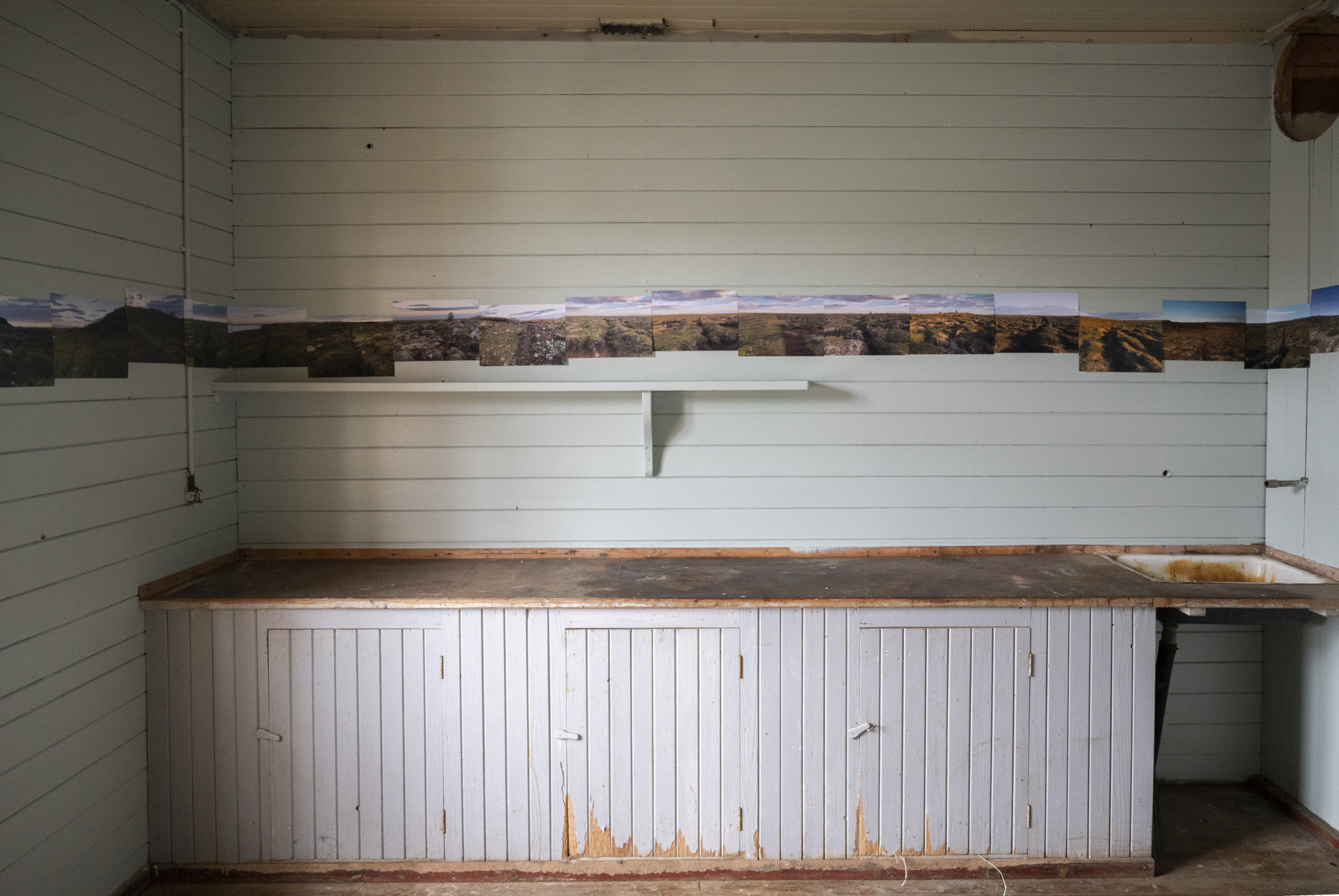
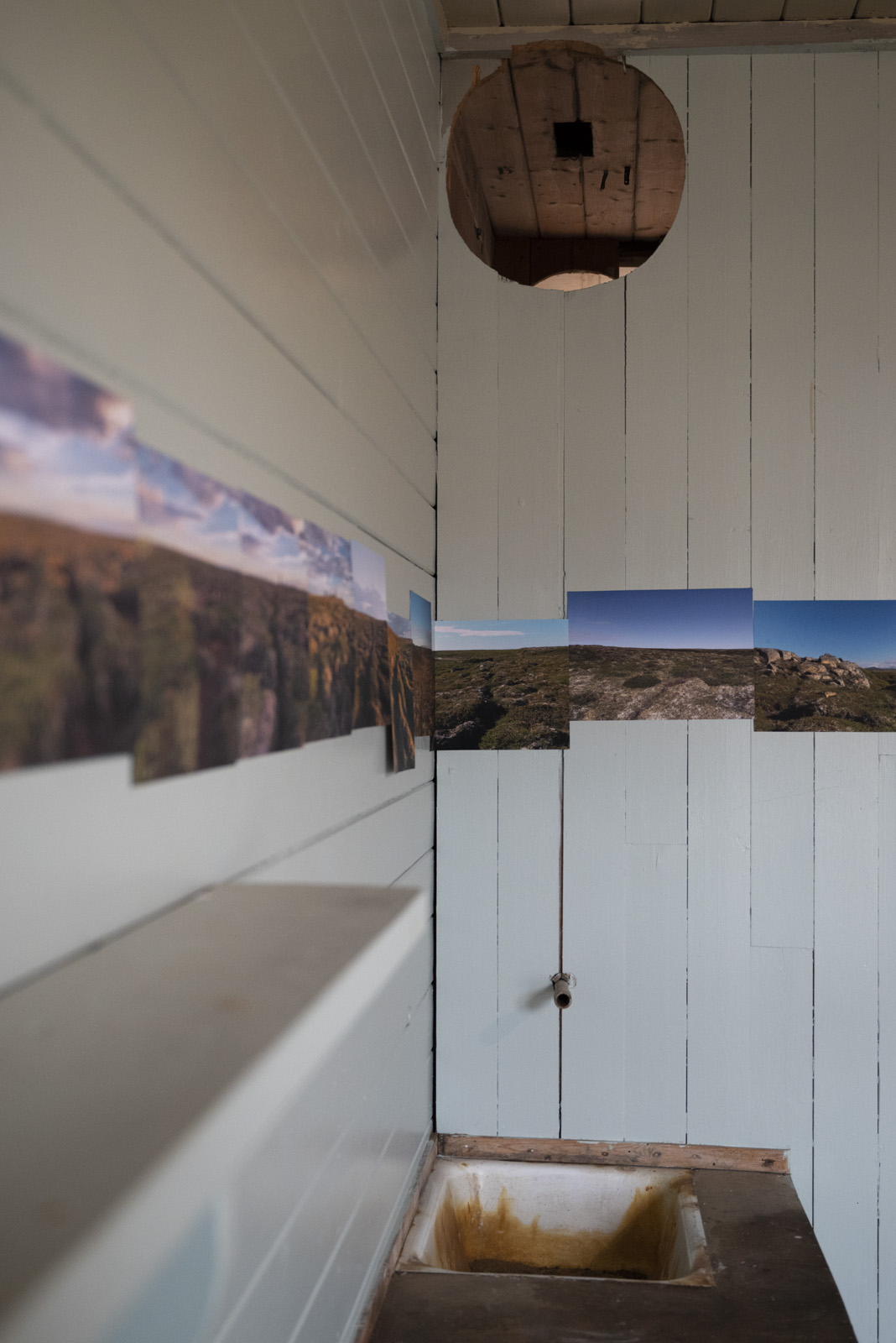
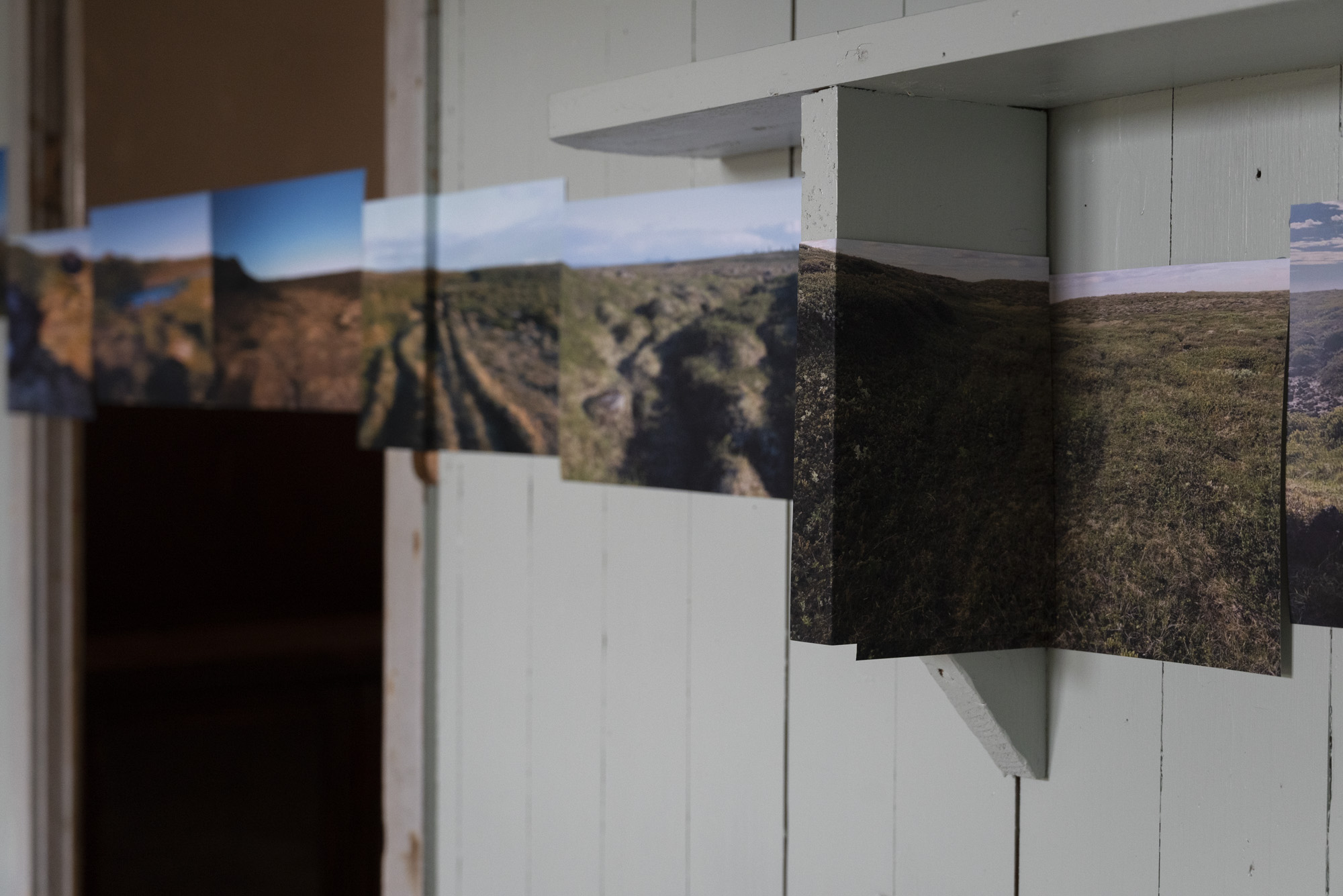
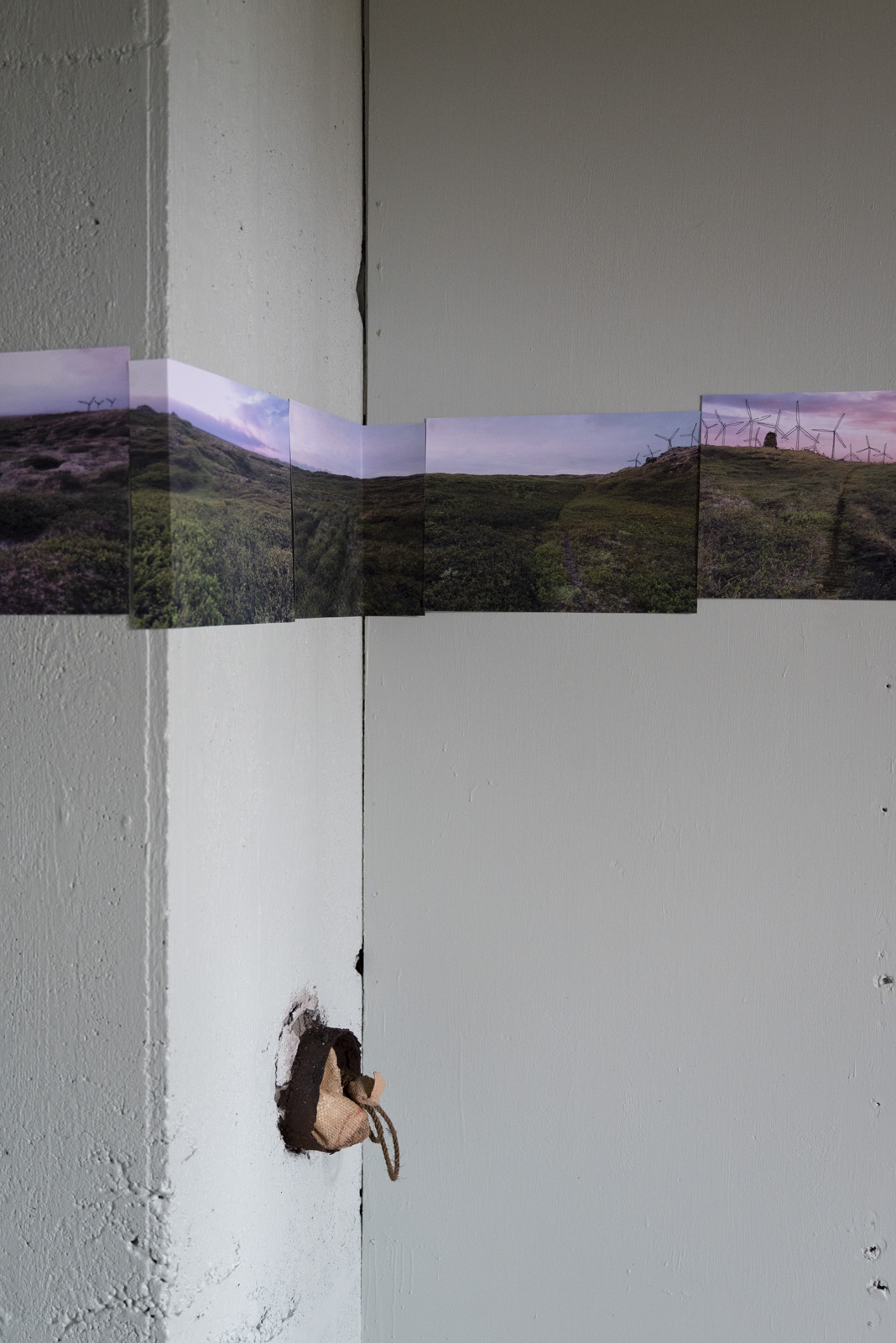
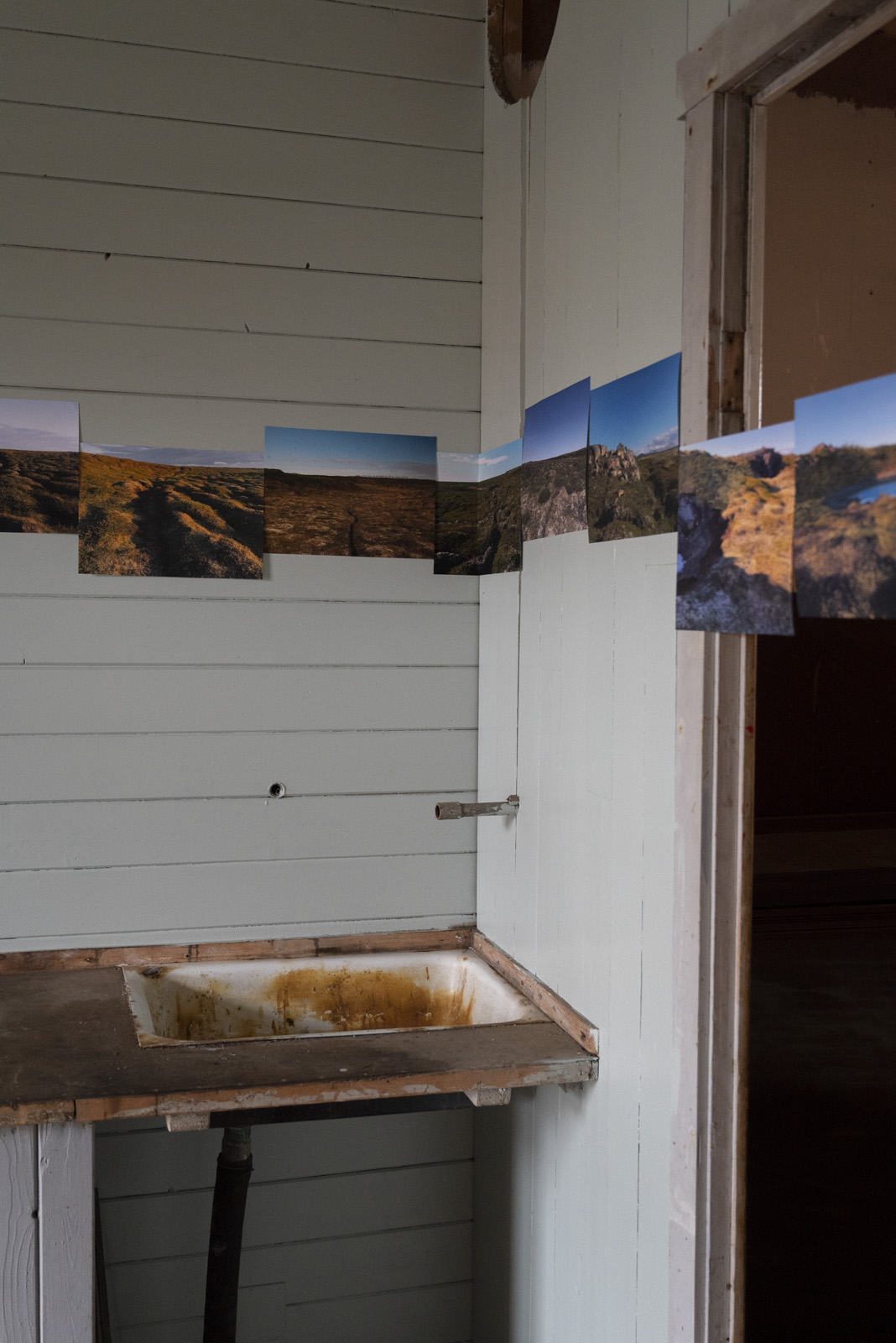
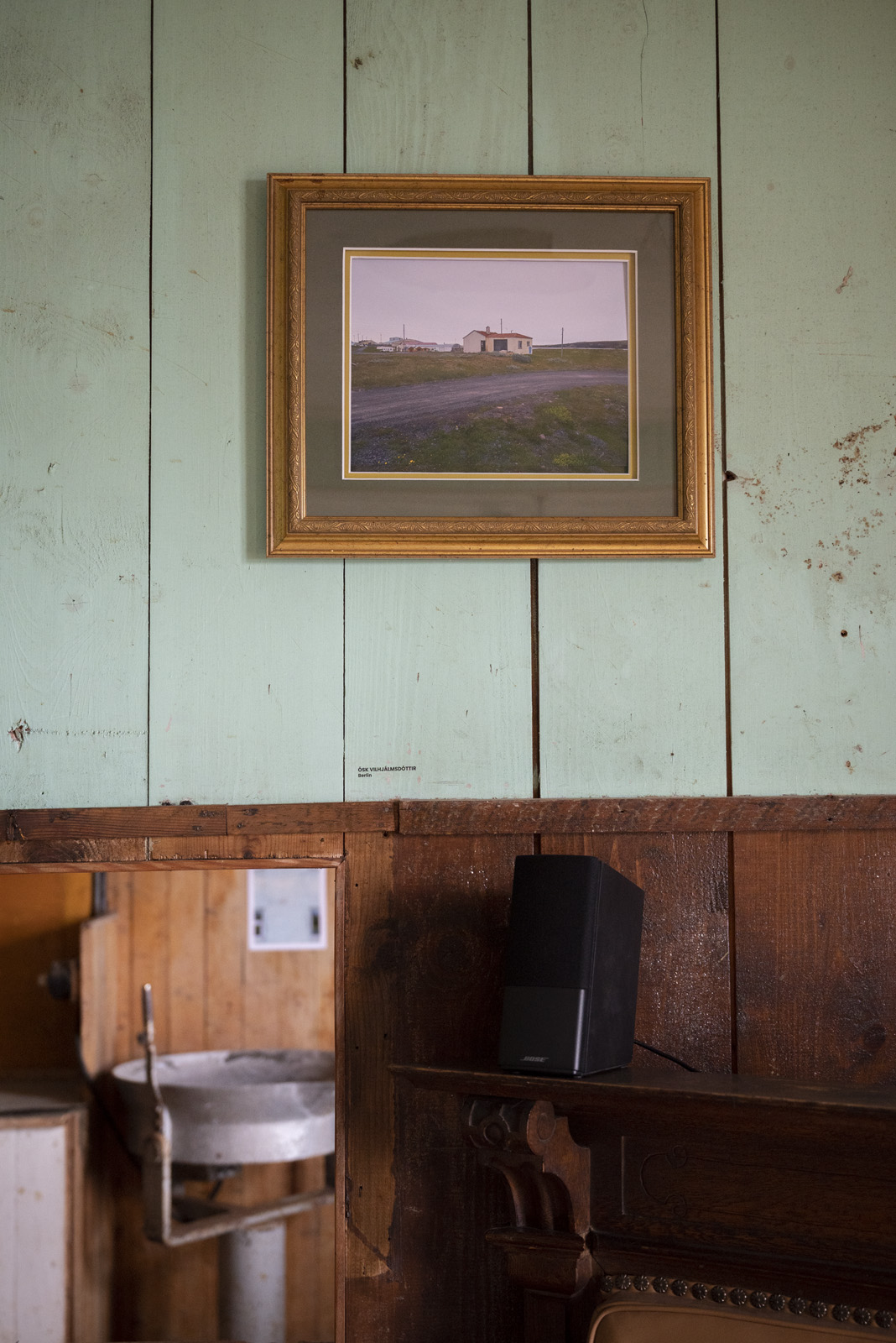


Ósk Vilhjálmsdóttir
Berlín
LISTEN HERE
“Berlin ist nicht eine Fischerhütte, sondern Ruine”, said Ásdís on the phone and brushed herself off. She was talking to a representative of the Cultural Affairs Committee of the City of Berlin, which happens to be the current owner of a house that stands empty and abandone
d opposite the sea on the Melrakkaslétta, more specifically in Raufarhöfn, going by the name of Berlin. There is very little left of Berlin other than its fragile shell.
When Nína (Katarina Peters) came to Raufarhöfn to visit
her friend, Ásdís Thoroddsen, she immediately knew that
she wanted to have a refuge here. She and Ásdís met in the eighties at the film academy in Berlin. Soon enough, Nina secured the purchase of an abandoned house with one of
the most beautiful ocean views in the middle of the town.
The house was in bad shape, but she planned to renovate it. When Nína acquired the house, she envisioned a bright future, picturing herself commuting across the ocean between Berlin and Raufarhöfn.
Berlin and Raufarhöfn may be some of the most opposite places one can think of. Berlin with all its history, culture, clubs and multiculturalism and Raufarhöfn, much quieter, where Nína envisioned a haven, away from the hustle and bustle
of the big city. She would work from there on writing scripts and developing her ongoing filmmaking practice, just like her friend Ásdís. But fate saw it otherwise, hopes and expectations vanished when Nína was diagnosed with brain cancer, shortly after purchasing the house.
Nína dreamed a lot, and among other things, she dreamed of herself riding naked on a ram through Melrakkaslétta’s plain and saw signs of rams in many places. She knew that she had to make this dream into a film. Which she did with the help of Ásdís.
When it sadly became clear that Nina had little left to live, she donated to the city of Berlin all her possessions, which were considerable since she had been successful in life. She now wanted to repay the city of Berlin for the support that had been given to her throughout her career as a filmmaker. And just like that, Berlin became the owner of this shell-of-a-house that Berlin is, at the very edge of the Arctic circle, in the remote town of Raufarhöfn.
Like Nina, I learnt that the plain of Melrakaslétta is perishable and that we can already witness changes in the land. During my walks in the surroundings, I focused my attention on the touch of moss and sedge.
Berlín
LISTEN HERE
“Berlin ist nicht eine Fischerhütte, sondern Ruine”, said Ásdís on the phone and brushed herself off. She was talking to a representative of the Cultural Affairs Committee of the City of Berlin, which happens to be the current owner of a house that stands empty and abandone
d opposite the sea on the Melrakkaslétta, more specifically in Raufarhöfn, going by the name of Berlin. There is very little left of Berlin other than its fragile shell.
When Nína (Katarina Peters) came to Raufarhöfn to visit
her friend, Ásdís Thoroddsen, she immediately knew that
she wanted to have a refuge here. She and Ásdís met in the eighties at the film academy in Berlin. Soon enough, Nina secured the purchase of an abandoned house with one of
the most beautiful ocean views in the middle of the town.
The house was in bad shape, but she planned to renovate it. When Nína acquired the house, she envisioned a bright future, picturing herself commuting across the ocean between Berlin and Raufarhöfn.
Berlin and Raufarhöfn may be some of the most opposite places one can think of. Berlin with all its history, culture, clubs and multiculturalism and Raufarhöfn, much quieter, where Nína envisioned a haven, away from the hustle and bustle
of the big city. She would work from there on writing scripts and developing her ongoing filmmaking practice, just like her friend Ásdís. But fate saw it otherwise, hopes and expectations vanished when Nína was diagnosed with brain cancer, shortly after purchasing the house.
Nína dreamed a lot, and among other things, she dreamed of herself riding naked on a ram through Melrakkaslétta’s plain and saw signs of rams in many places. She knew that she had to make this dream into a film. Which she did with the help of Ásdís.
When it sadly became clear that Nina had little left to live, she donated to the city of Berlin all her possessions, which were considerable since she had been successful in life. She now wanted to repay the city of Berlin for the support that had been given to her throughout her career as a filmmaker. And just like that, Berlin became the owner of this shell-of-a-house that Berlin is, at the very edge of the Arctic circle, in the remote town of Raufarhöfn.
Like Nina, I learnt that the plain of Melrakaslétta is perishable and that we can already witness changes in the land. During my walks in the surroundings, I focused my attention on the touch of moss and sedge.
Kristín Reynisdóttir
Frjósemi og hverfulleiki
![]()
Frjósemi og hverfulleiki
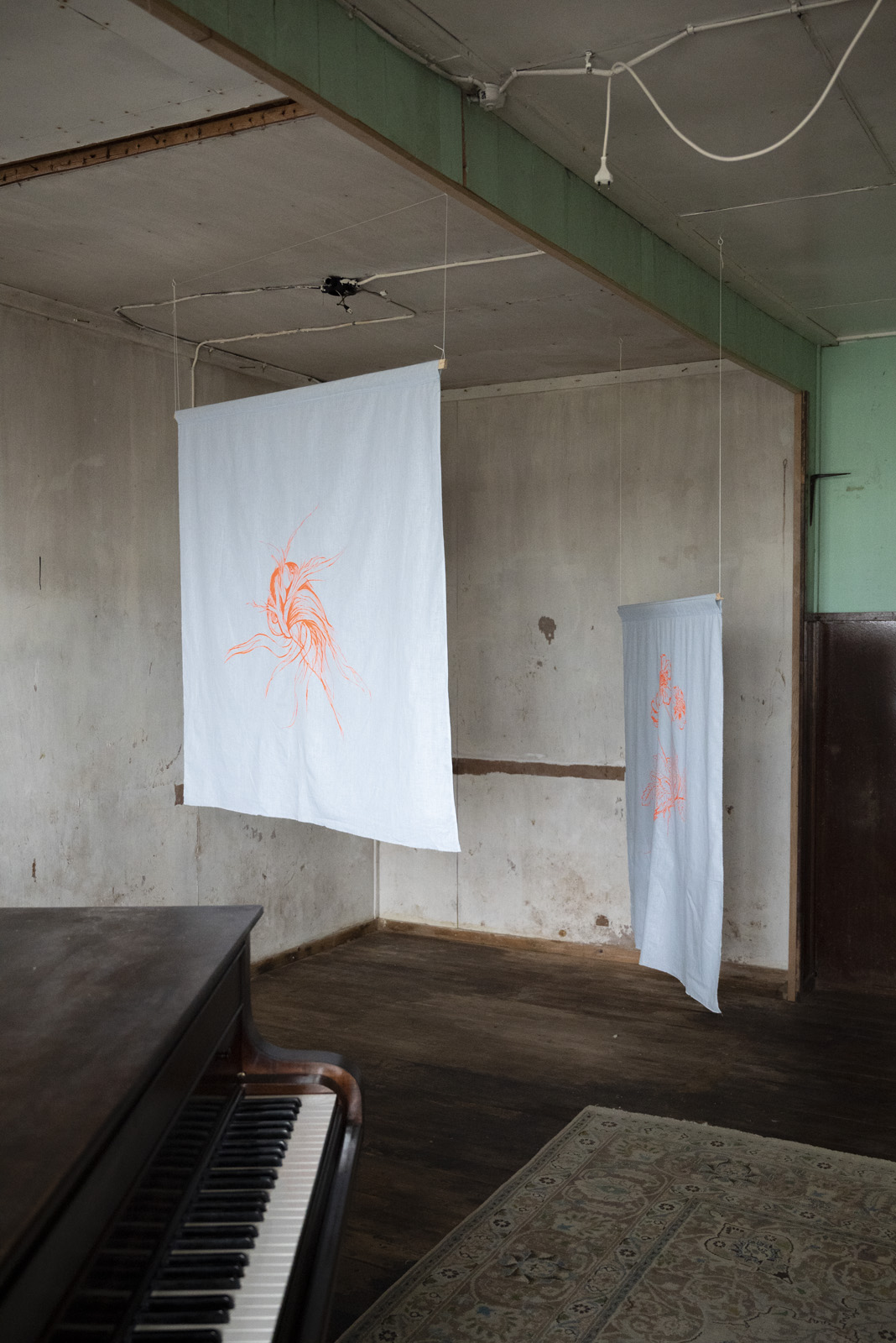

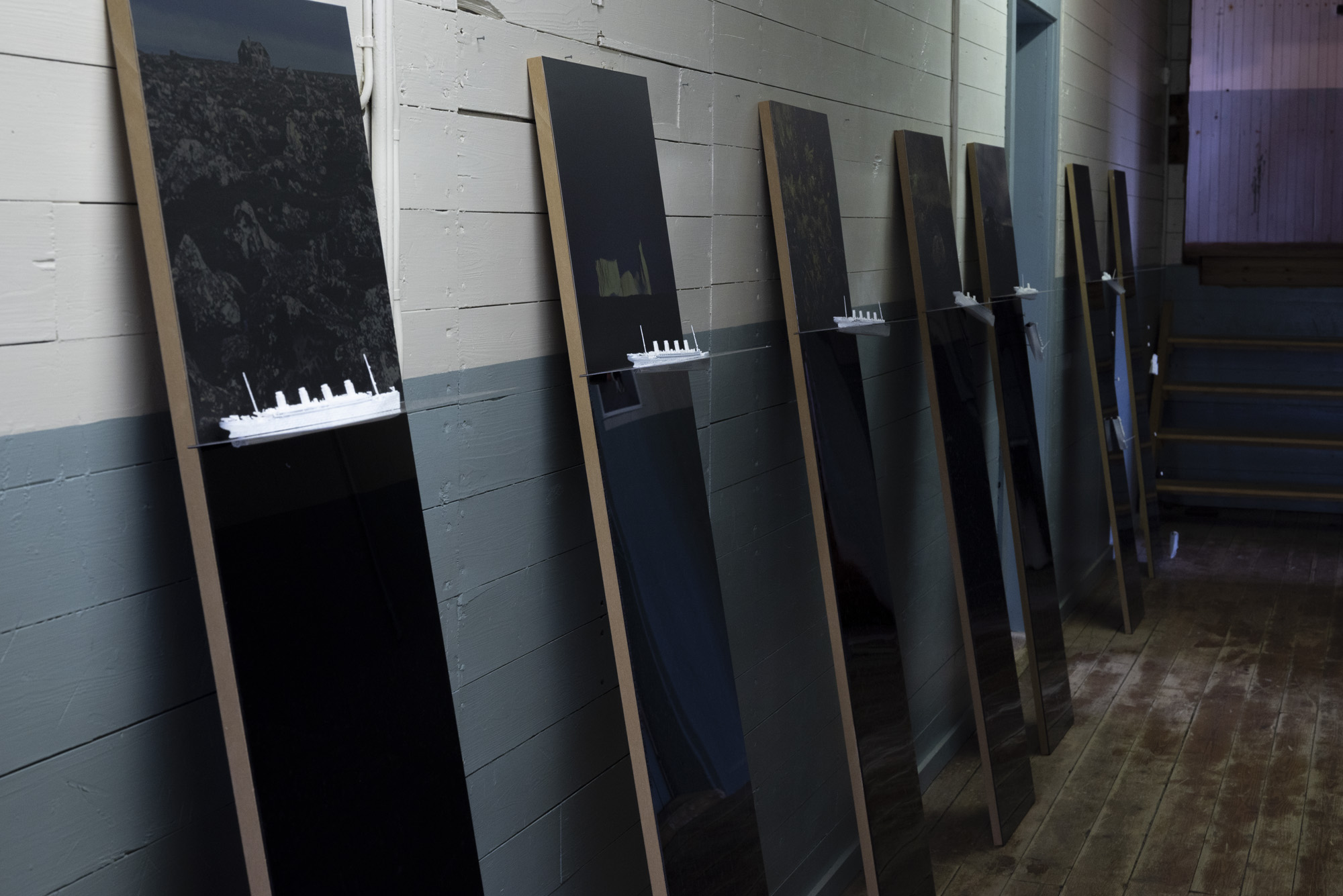
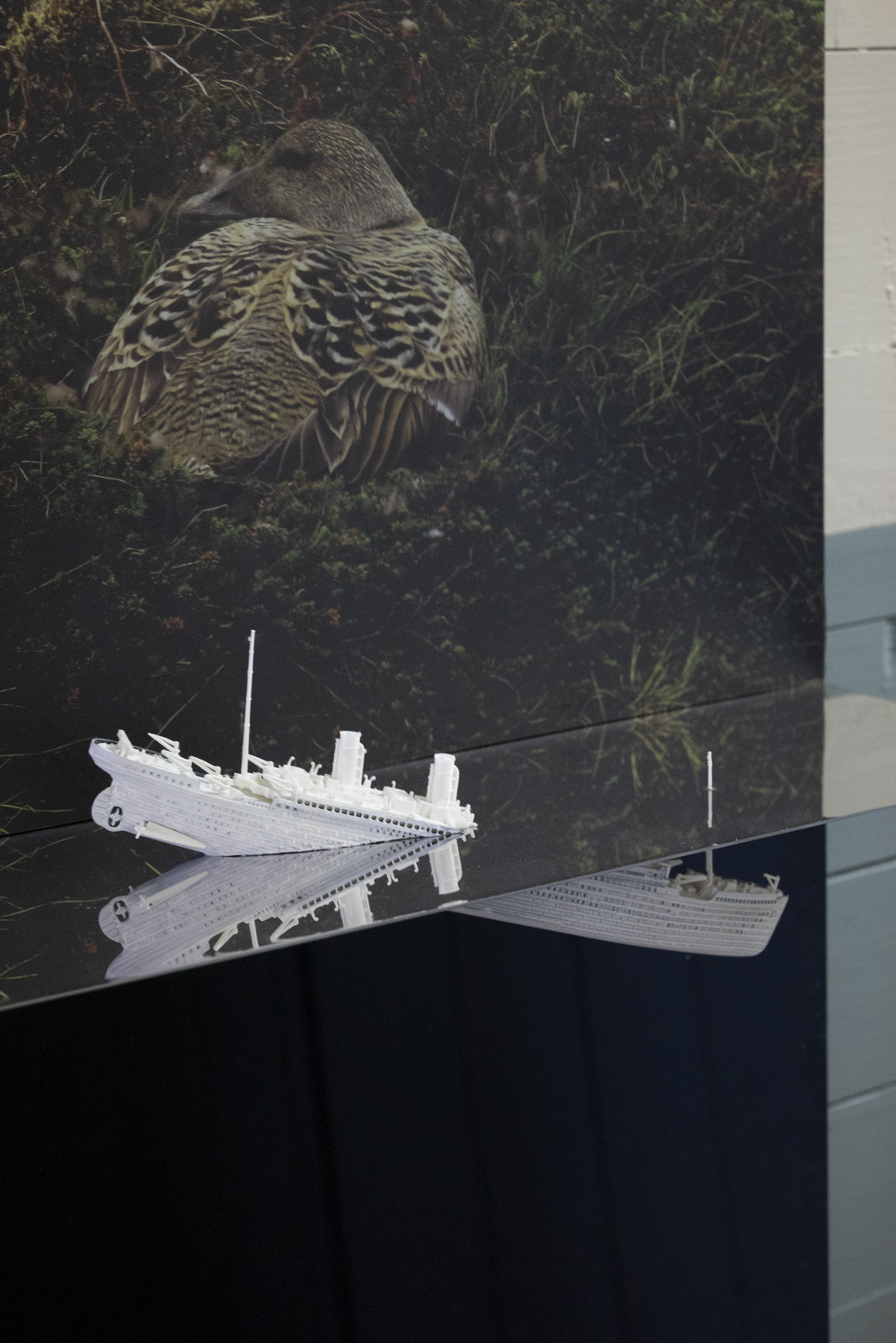
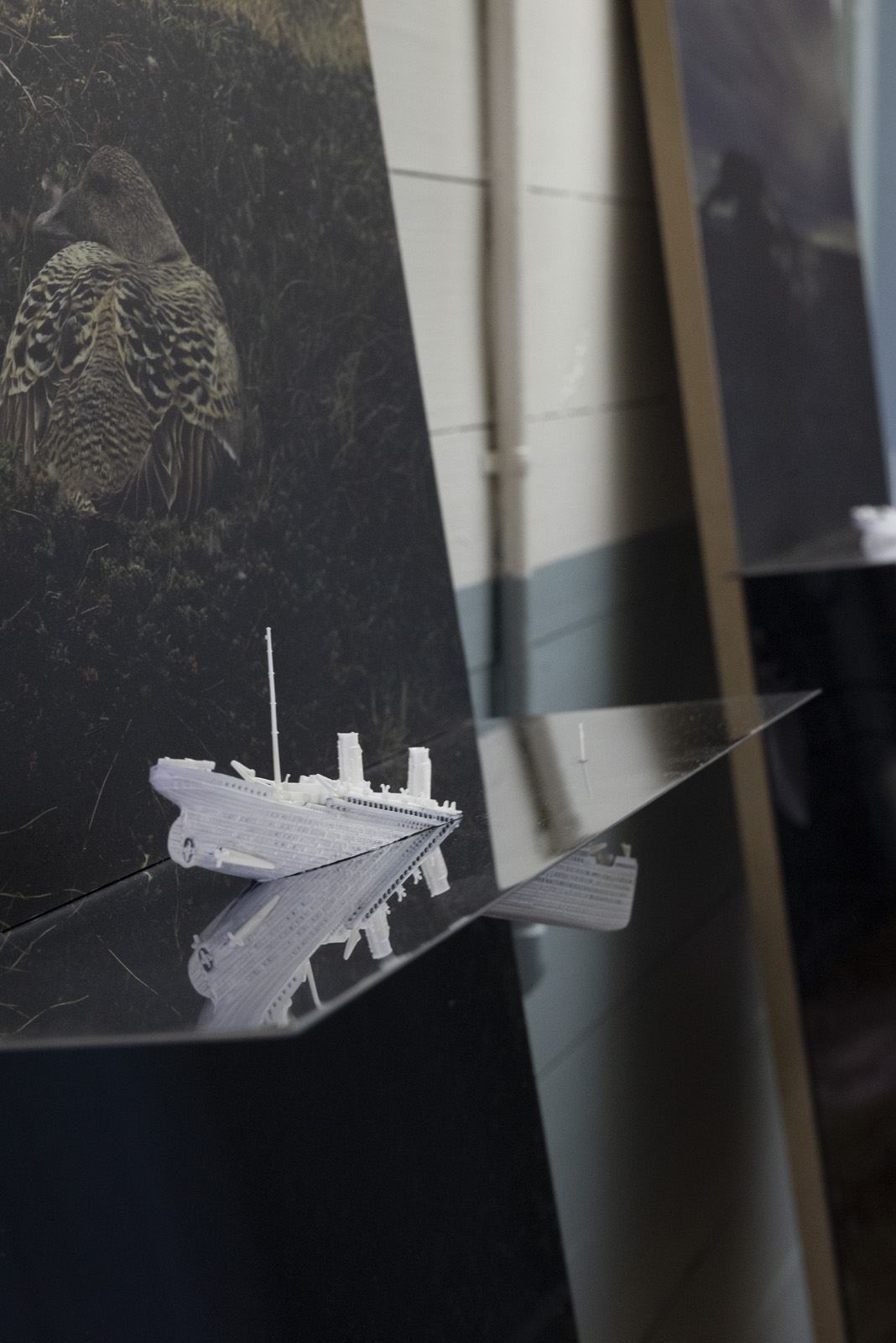
Snorri Freyr Hilmarsson
“When does the band start playing?”
When does the critical moment come and what makes us understand and perceive that pivoting moment in time? Humans have a genetic evolutionary tendency to believe in their “own luck”, when facing a difficult challenge. That
very tendency is now its culprit, making the inhabitants o the planet unable to face the current challenge of climate change. Changes based on probability, abstract relativity of time and changes that will only affect some “one else” and yet not “me”.
Here, the idea is to bring together well-known history and myth, the condemned engineering marvel of humans, the coal giant Titanic and Rif, to see what that history can teach us about the inevitable: about nature and society. Compare, the collision of ice and coal, before and now.” When does reality trump the idea of luck?
On the plain of Melrakkaslétta, the land is sinking while the sea level is rising. The Human Age has come in the Earth’s geological history.
Rif on Melrakkaslétta is a benchmark in this matter. Rif is no longer a human habitation but the drama, the accident continues on a time scale that is not visible to human experience , yet it is still present.
Here, you can study how the land sinks, how nature and the ecosystem behave, or take the hit, under those changing conditions. The Arctic, of which the plain of Merakkaslétta is a part of, has a story to tell, story about what is happening worldwide if we dare listen to it.
It is said that man’s intuitive thinking is best activated through myths rather than statistics and facts. Here two stories of coal and the Arctic meet, can the timelines of unrelated events be a reflection of each other?
“When does the band start playing?”
When does the critical moment come and what makes us understand and perceive that pivoting moment in time? Humans have a genetic evolutionary tendency to believe in their “own luck”, when facing a difficult challenge. That
very tendency is now its culprit, making the inhabitants o the planet unable to face the current challenge of climate change. Changes based on probability, abstract relativity of time and changes that will only affect some “one else” and yet not “me”.
Here, the idea is to bring together well-known history and myth, the condemned engineering marvel of humans, the coal giant Titanic and Rif, to see what that history can teach us about the inevitable: about nature and society. Compare, the collision of ice and coal, before and now.” When does reality trump the idea of luck?
On the plain of Melrakkaslétta, the land is sinking while the sea level is rising. The Human Age has come in the Earth’s geological history.
Rif on Melrakkaslétta is a benchmark in this matter. Rif is no longer a human habitation but the drama, the accident continues on a time scale that is not visible to human experience , yet it is still present.
Here, you can study how the land sinks, how nature and the ecosystem behave, or take the hit, under those changing conditions. The Arctic, of which the plain of Merakkaslétta is a part of, has a story to tell, story about what is happening worldwide if we dare listen to it.
It is said that man’s intuitive thinking is best activated through myths rather than statistics and facts. Here two stories of coal and the Arctic meet, can the timelines of unrelated events be a reflection of each other?
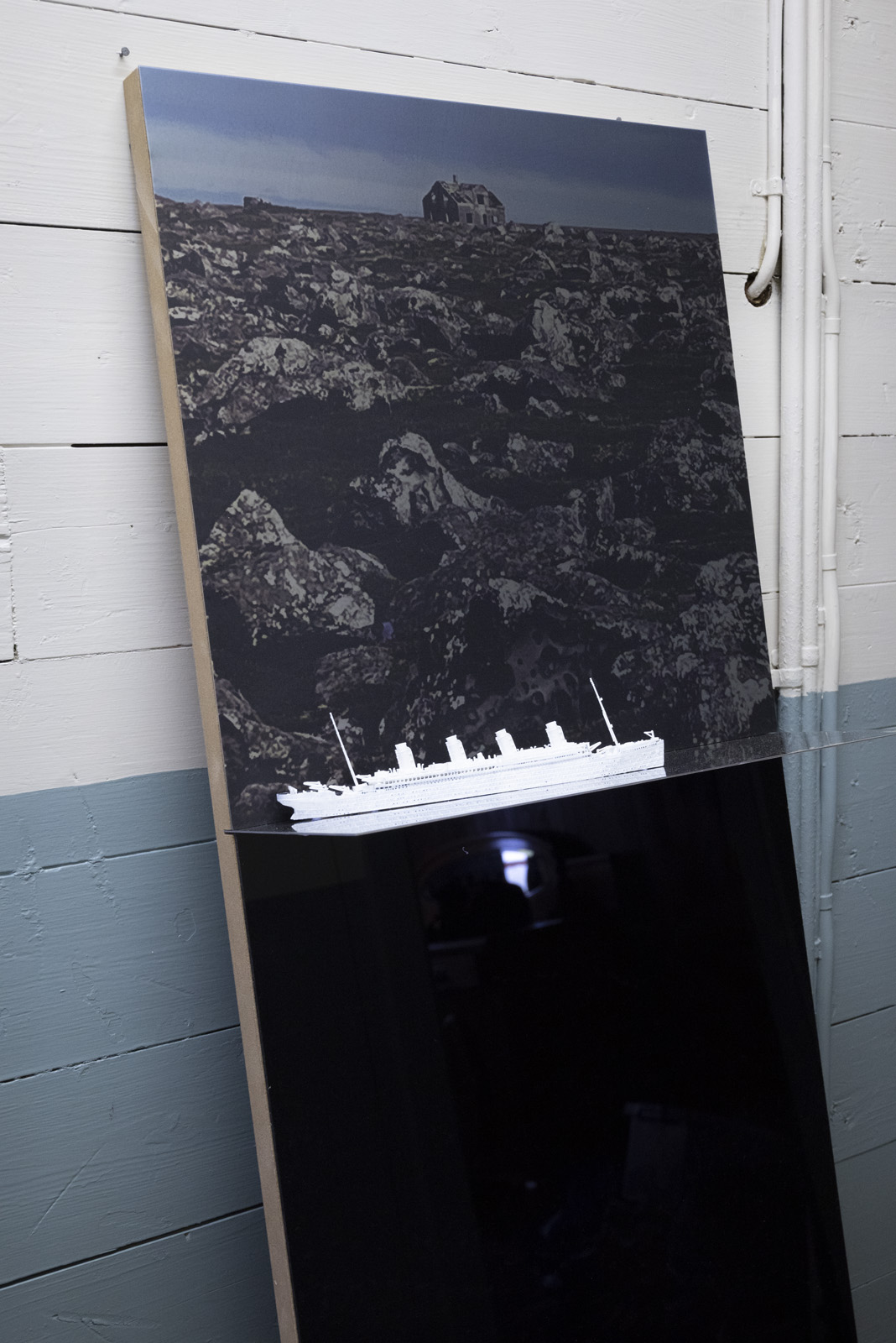

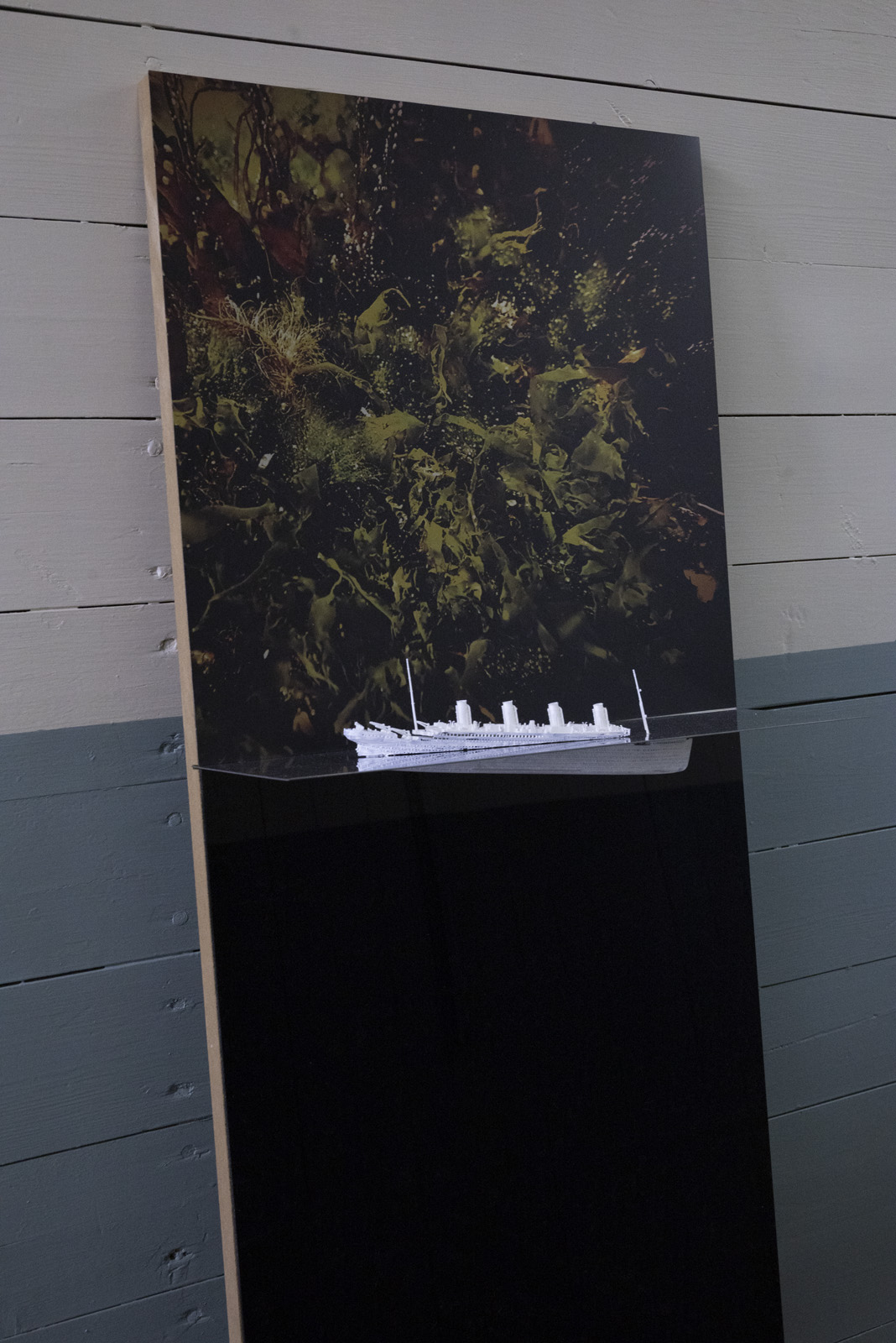
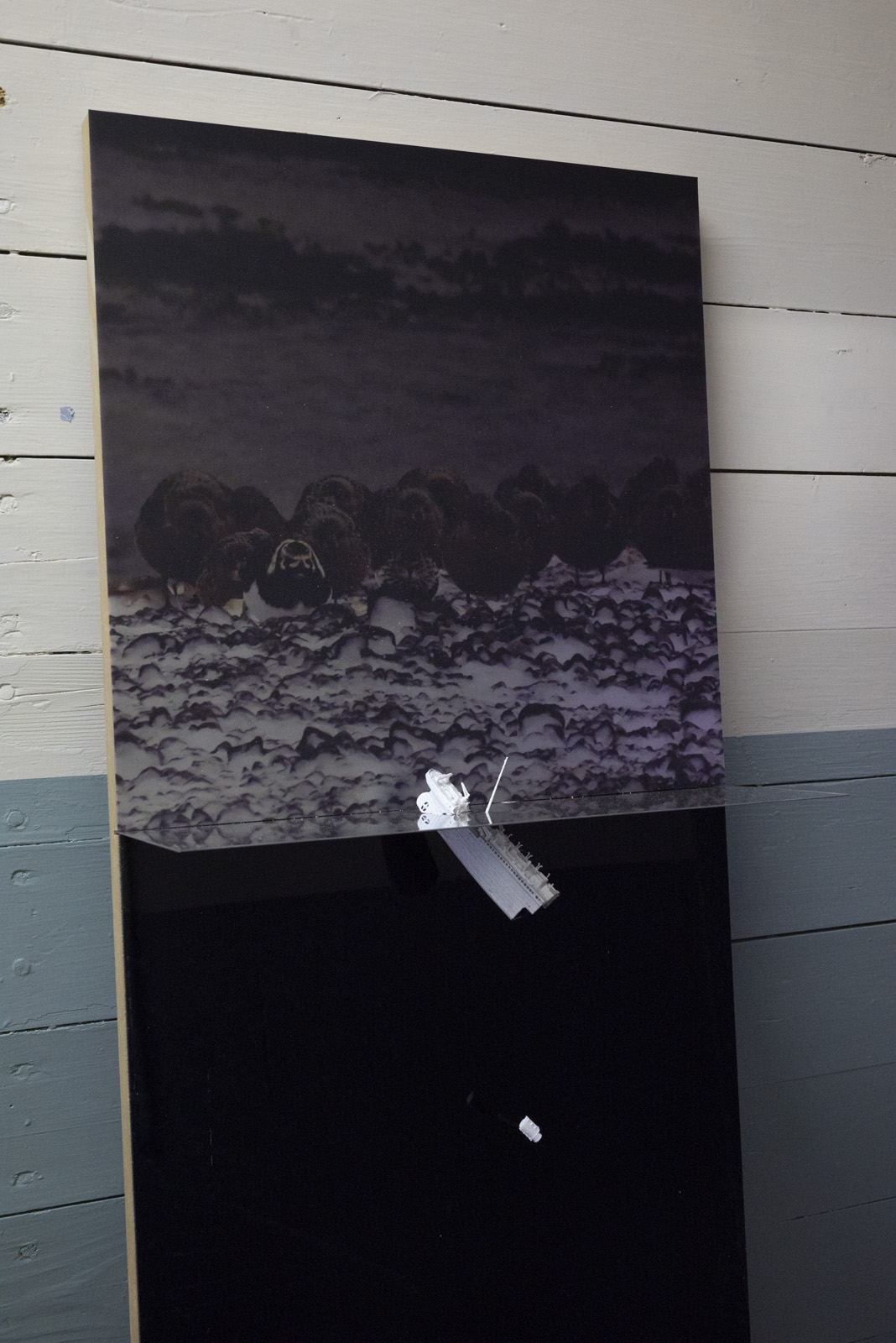
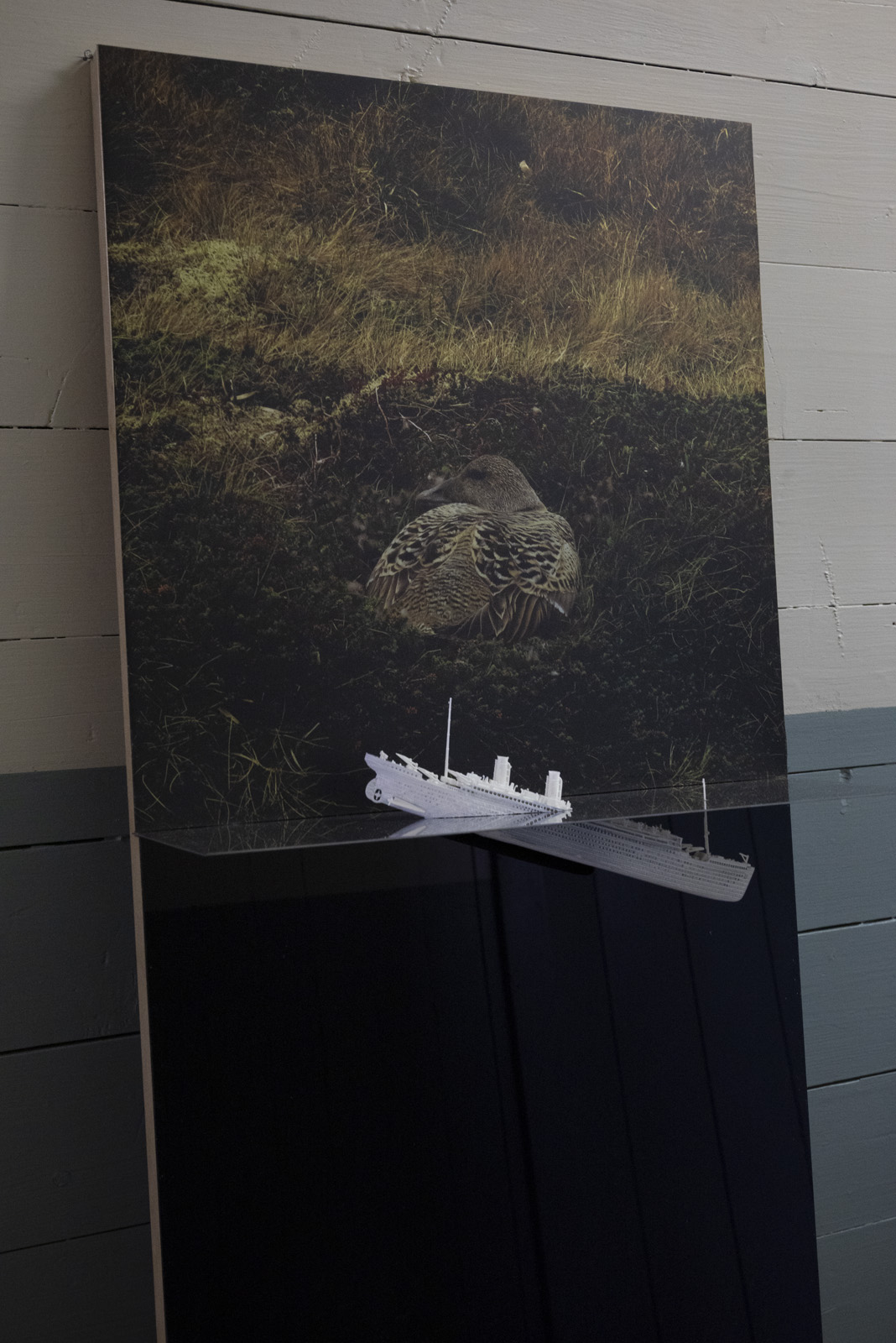


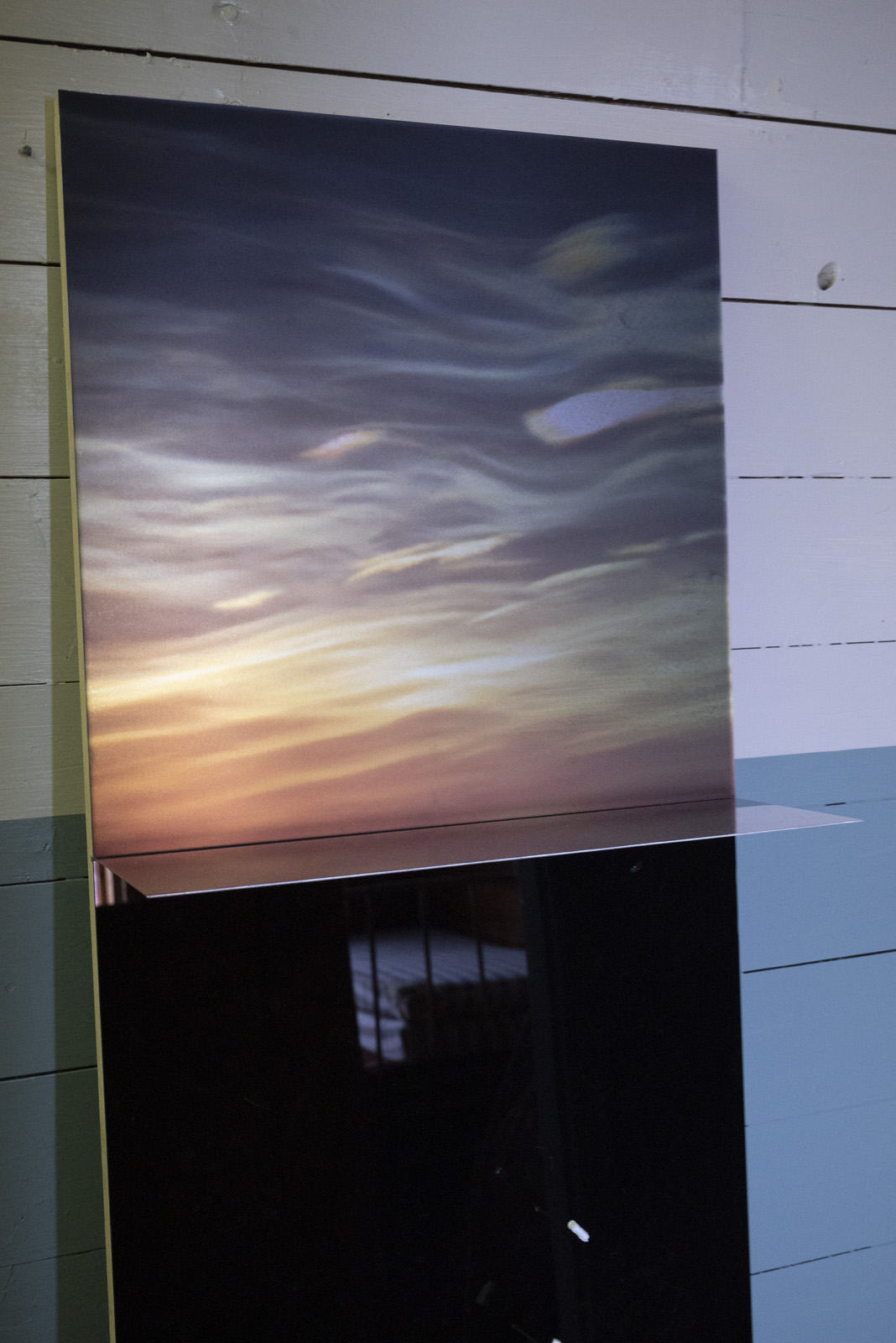
Top Floor:
Sigtryggur Bjarni Baldvinsson
Himnar og helvíti.
The sky above the plain of Melrakkaslétta is vast, not overshadowed by mountains like in most Icelandic landscapes. The sky, a widely read natural phenomenon. There are omens in the sky and God lives there. For centuries, farmers and fishermen have looked to the sky and predicted the future. Being able to read the sky separated the wise from the ignorant; since those who misunderstood heaven: starved and drowned.
During my travels through Melrakaslétta, the last summers and autumns, I have seen the omens of changes in climate, drought, storm and erosion, triggering fears for our future, the future of our children and their descendants.
My feelings get reflected in large watercolours of the sky over the plain. These are large watercolour works, but tiny compared to the original model, the sky itself, like “a crowberry in hell”. ‘
That is also how I feel about the challenges ahead, like” a crowberry in hell”.
The soundpiece was composed by “Turous Merula” also called Common Blackbird. After being slowed down, the message from the blackbird’s song takes a darker turn.
Himnar og helvíti.
The sky above the plain of Melrakkaslétta is vast, not overshadowed by mountains like in most Icelandic landscapes. The sky, a widely read natural phenomenon. There are omens in the sky and God lives there. For centuries, farmers and fishermen have looked to the sky and predicted the future. Being able to read the sky separated the wise from the ignorant; since those who misunderstood heaven: starved and drowned.
During my travels through Melrakaslétta, the last summers and autumns, I have seen the omens of changes in climate, drought, storm and erosion, triggering fears for our future, the future of our children and their descendants.
My feelings get reflected in large watercolours of the sky over the plain. These are large watercolour works, but tiny compared to the original model, the sky itself, like “a crowberry in hell”. ‘
That is also how I feel about the challenges ahead, like” a crowberry in hell”.
The soundpiece was composed by “Turous Merula” also called Common Blackbird. After being slowed down, the message from the blackbird’s song takes a darker turn.

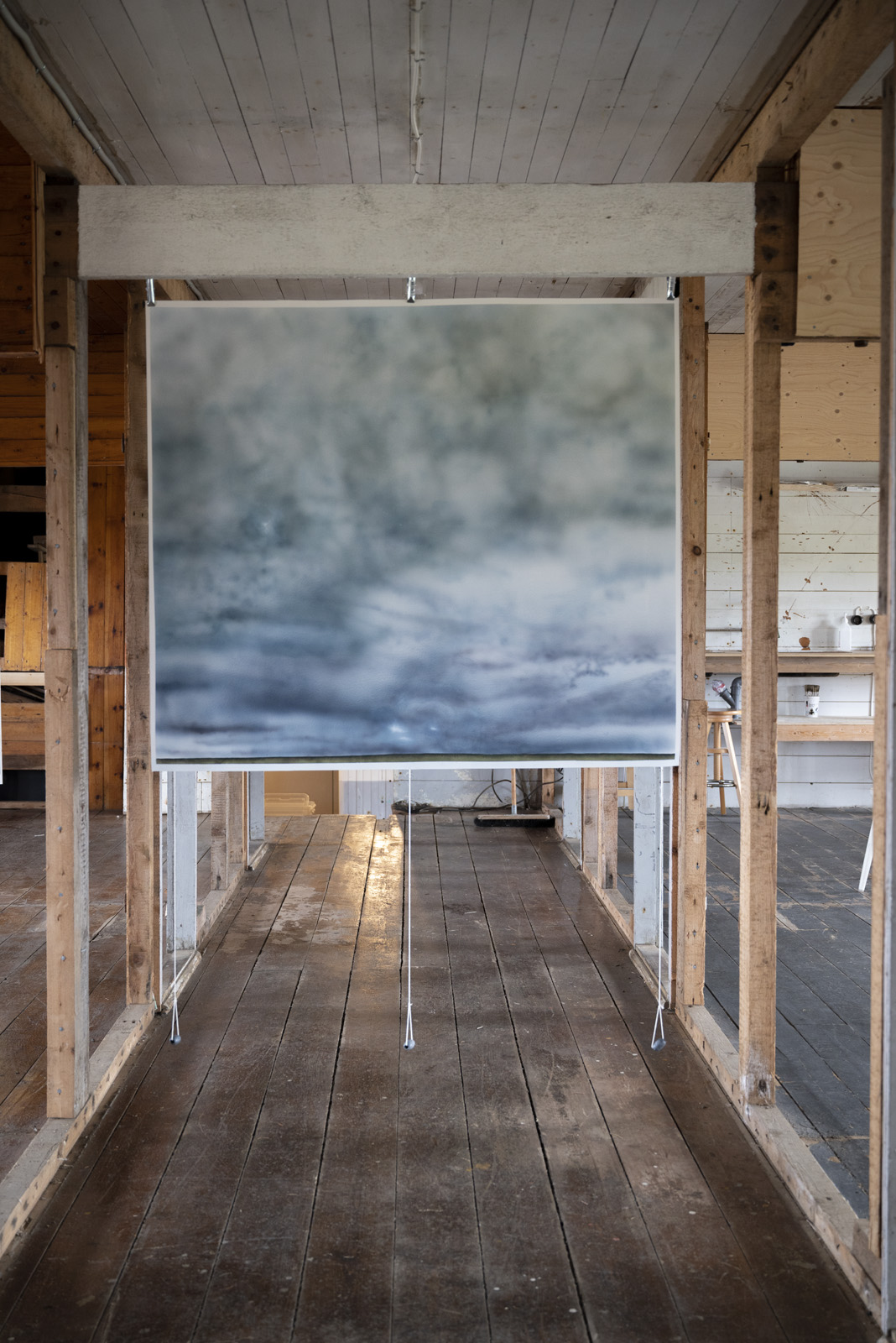
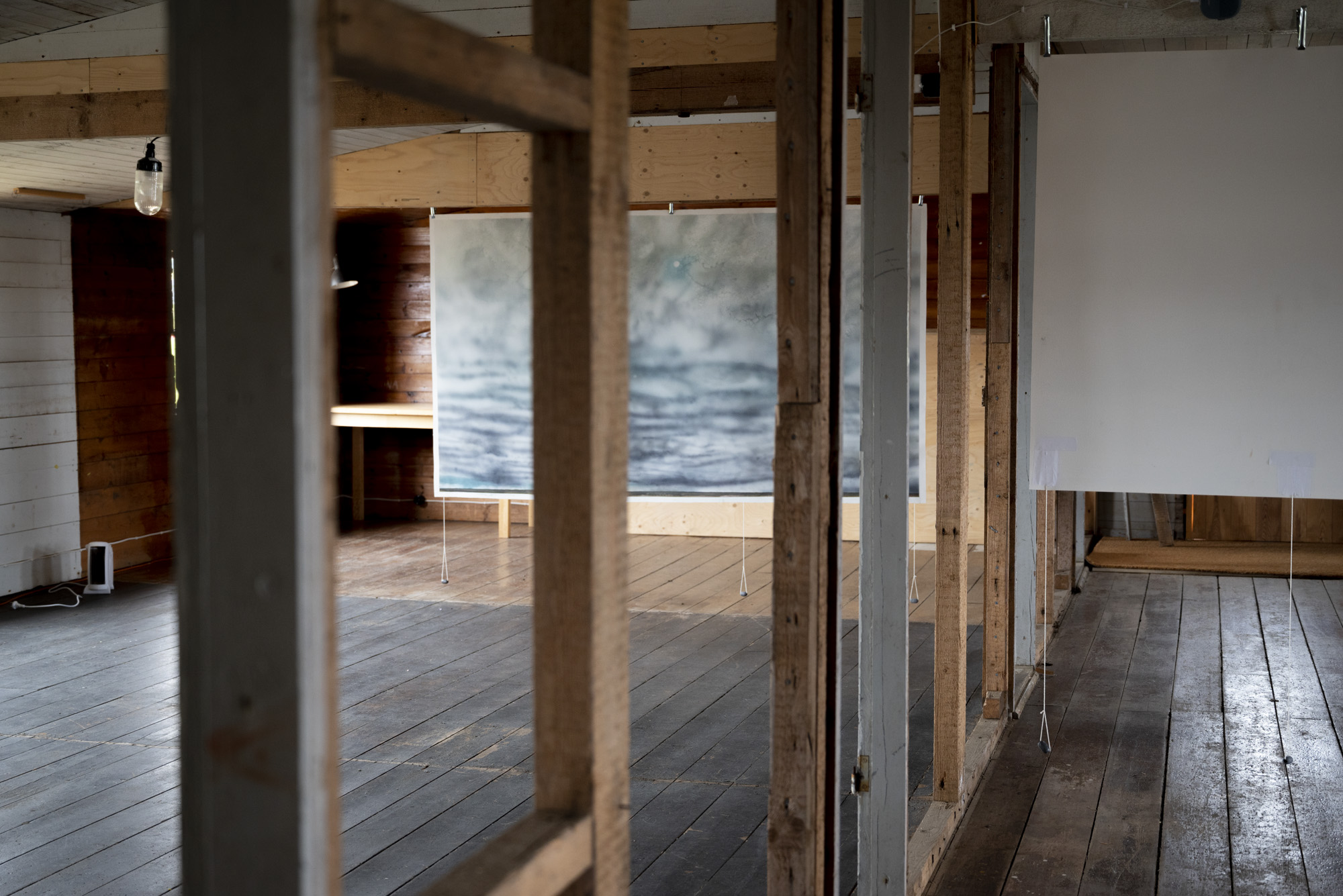
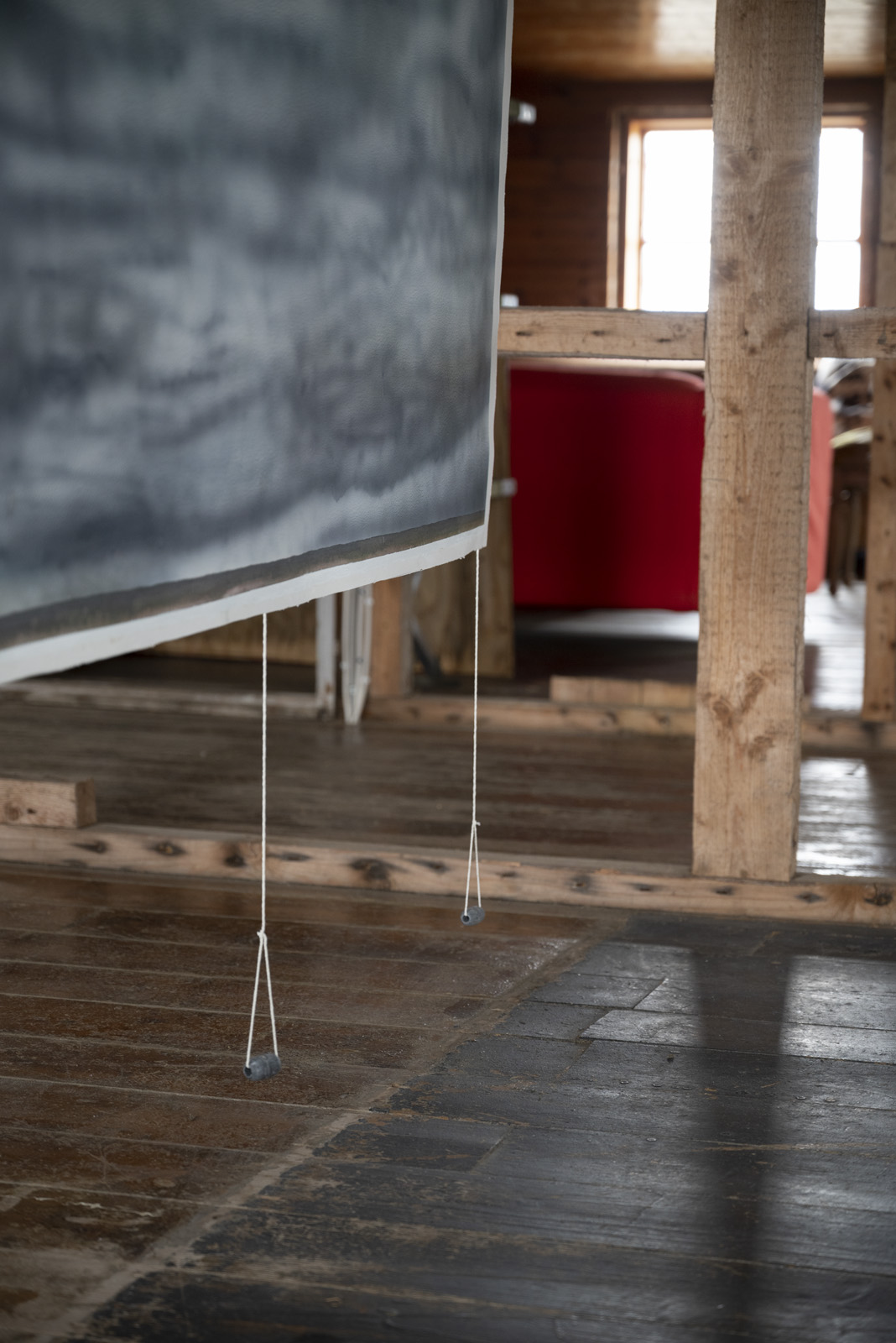


Outside:
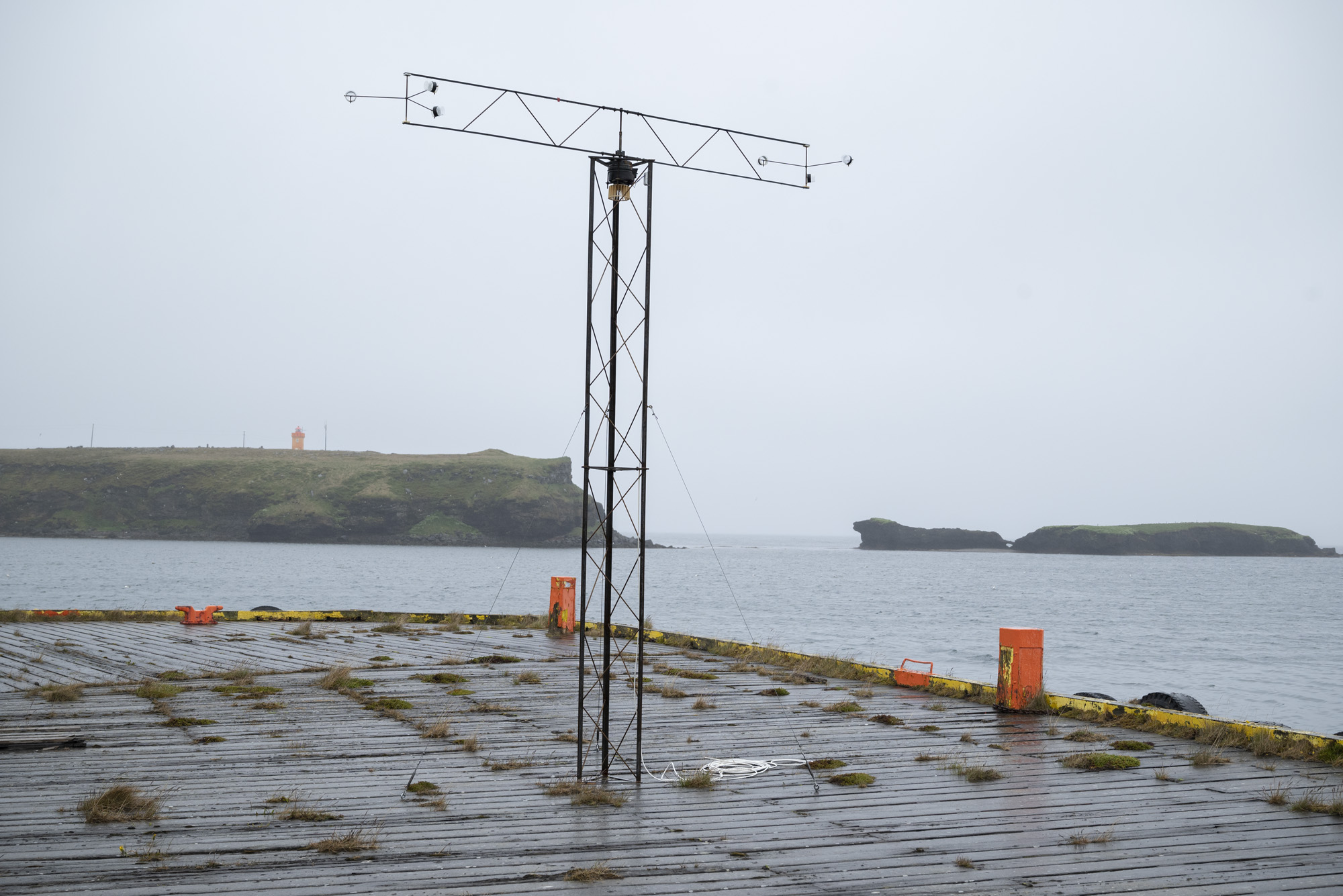
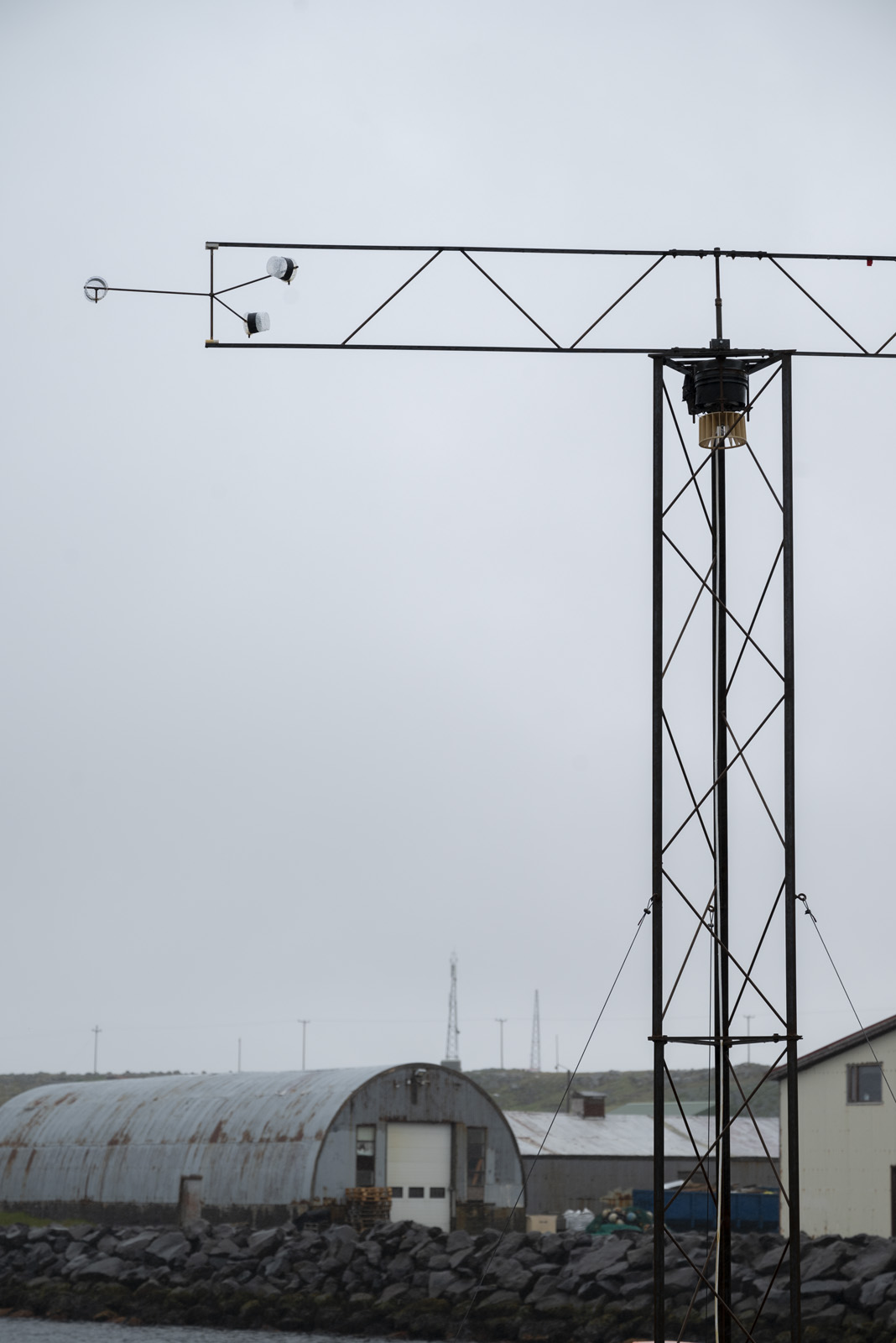
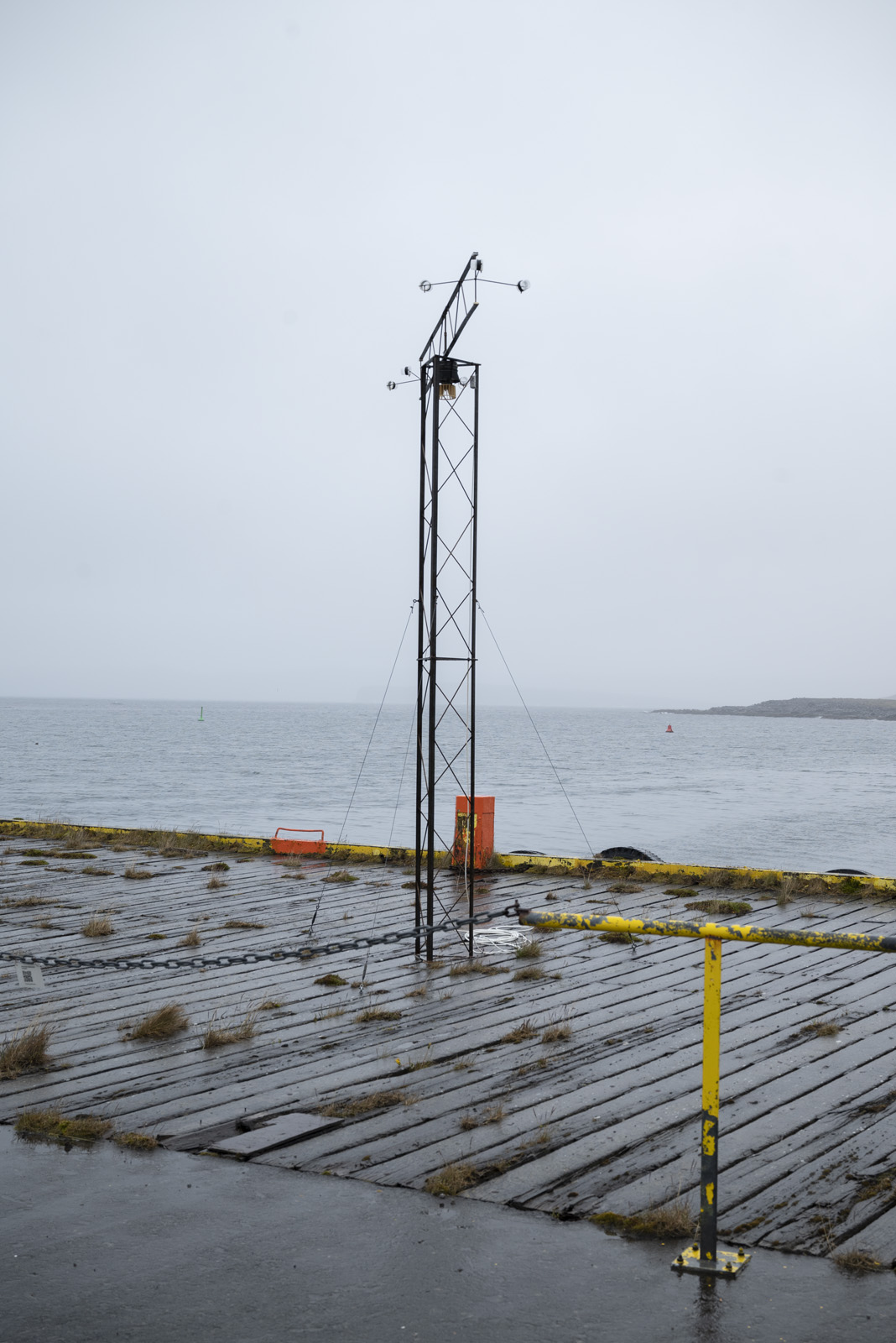
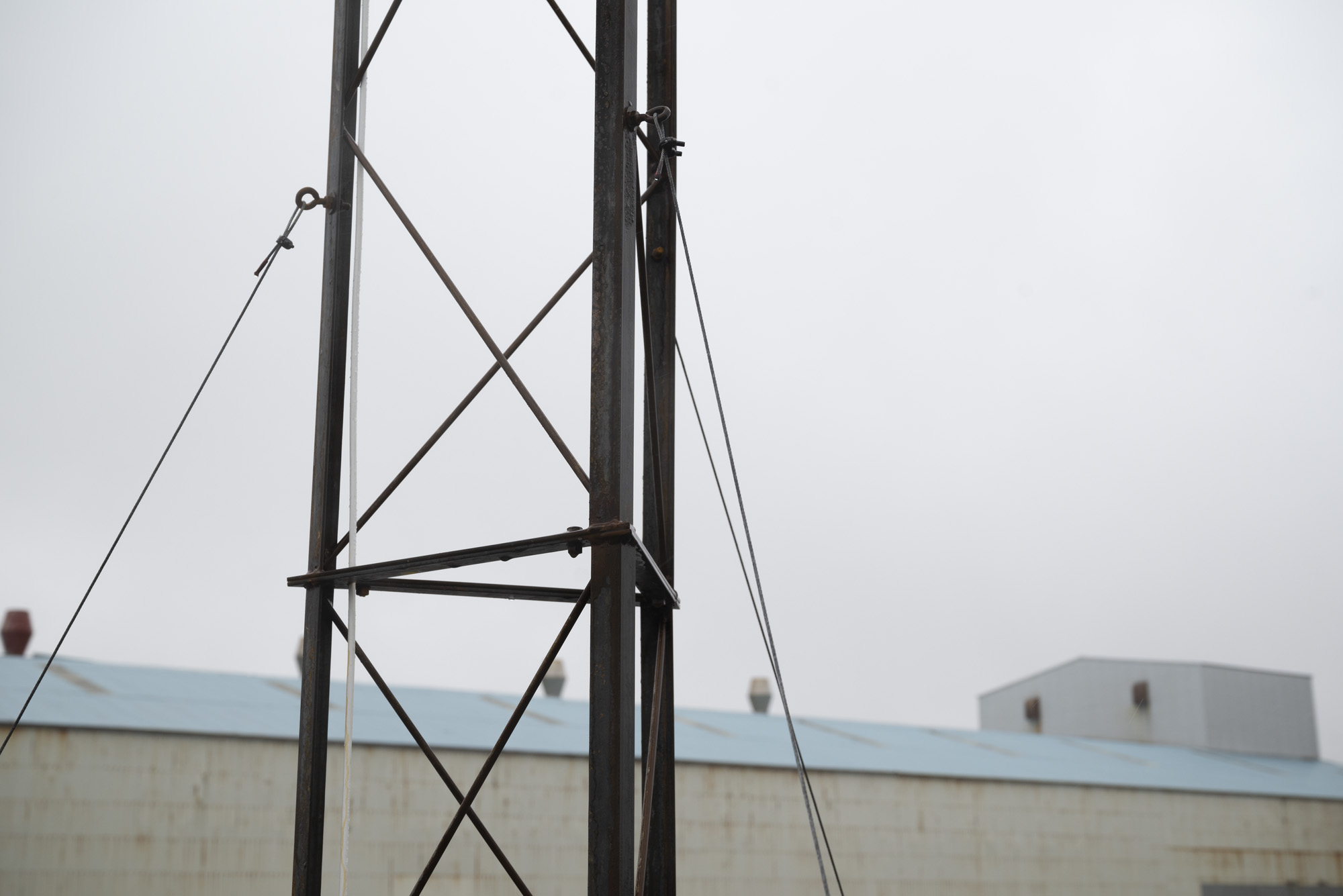

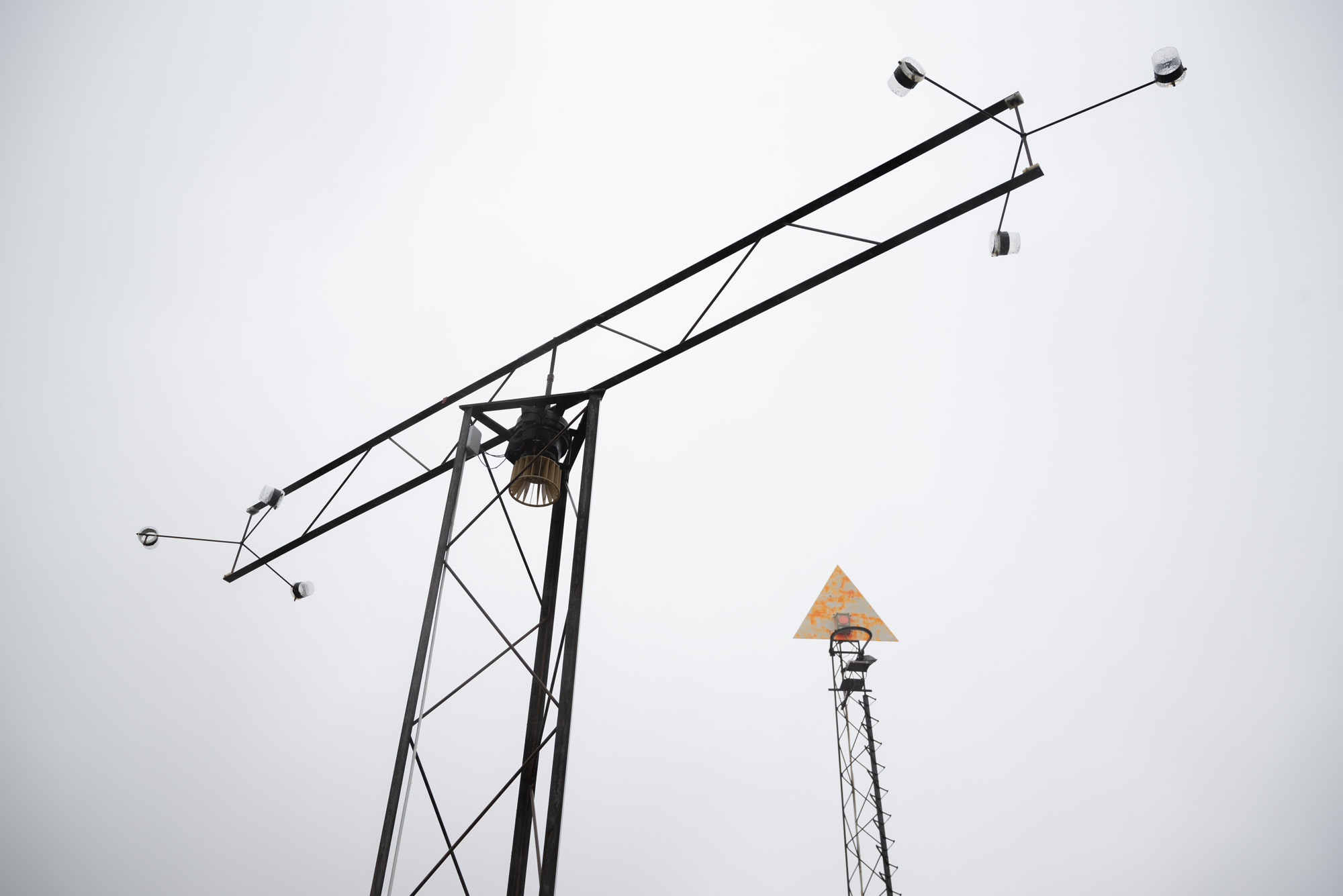
Pétur Örn Friðriksson
Aðstæður
What I explore is nature and life in the area. I focus on human existence; history, farming, hunting and society based on necessity.
The life can be here in slow beat and silence. Infrastructure is minimal today but became immense by the last echo of the Industrial Revolution.
I make sculptures to reflect, it‘s a research. It‘s a method to explore situations and history.
It is a rural iron mast with a vertical rotating bar. Nothing to stand out aesthetically, it could be practical utility based on land for sea traffic security or for monitoring surroundings.
A tool for command, communication or research. Its appearance and friction with air is mine extraction of tundra integrated society.
Bryndís Snæbjörnsdóttir & Mark Wilson
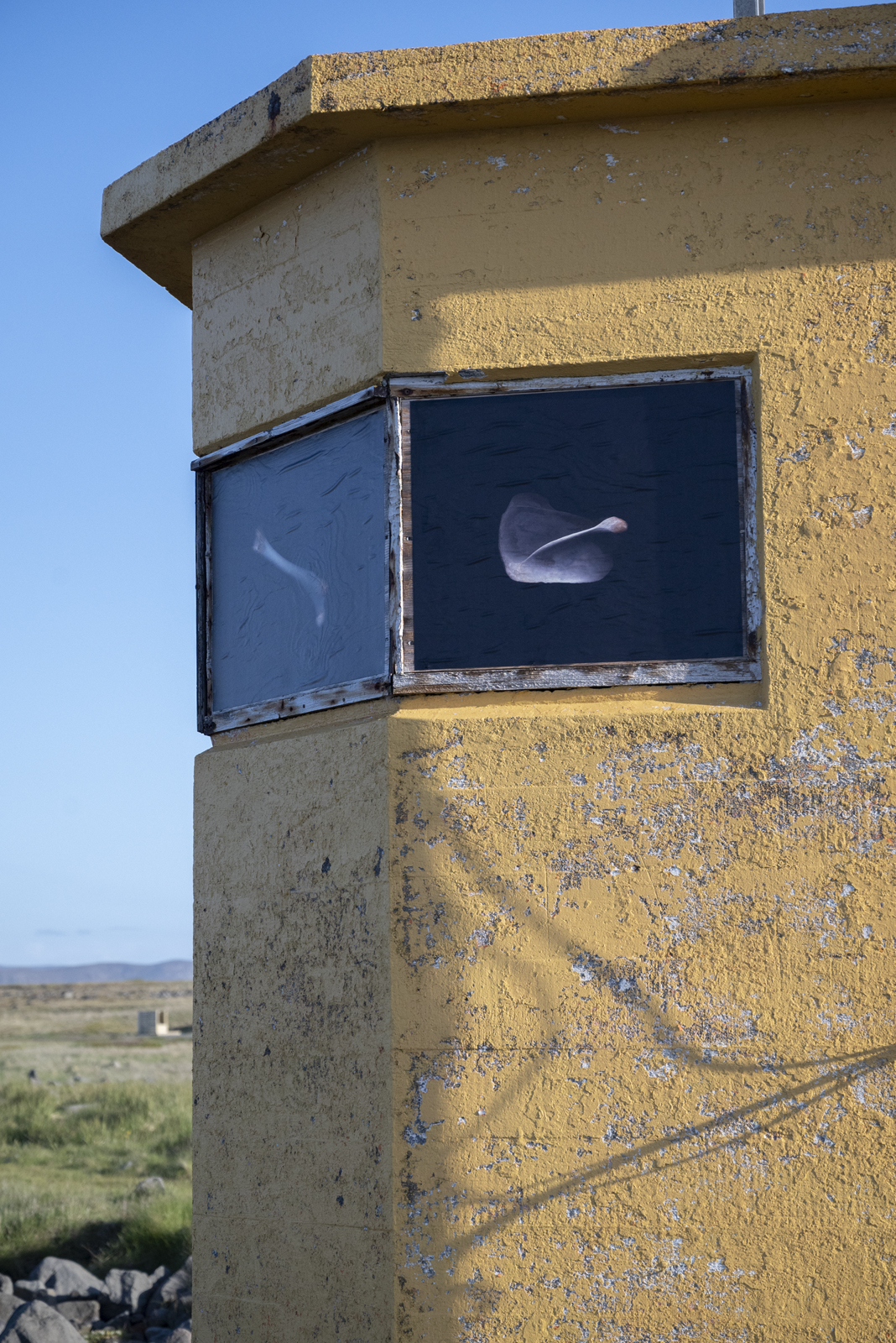
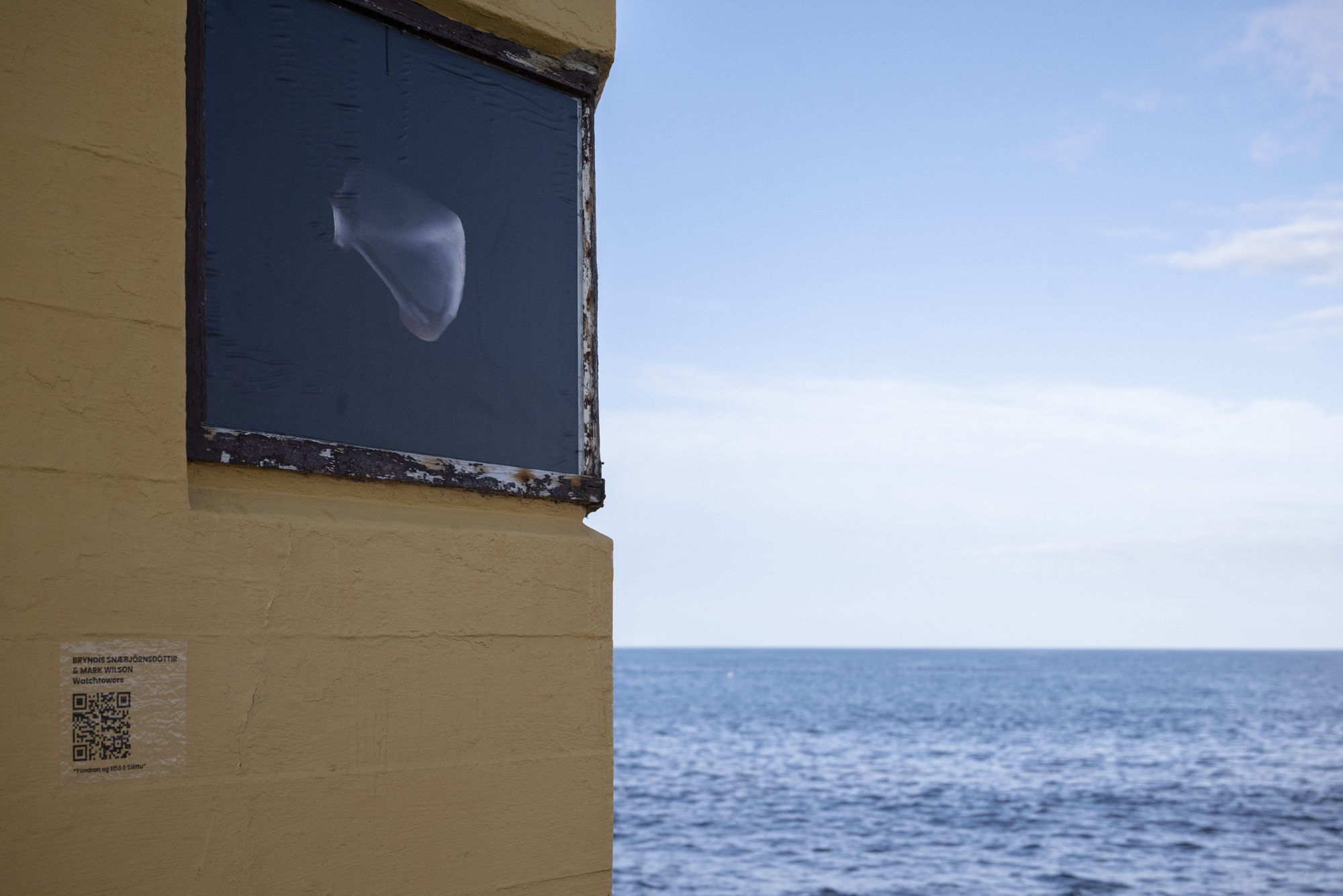


Einar Falur Ingólfsson
From the Slétta Diary
![]()
From the Slétta Diary
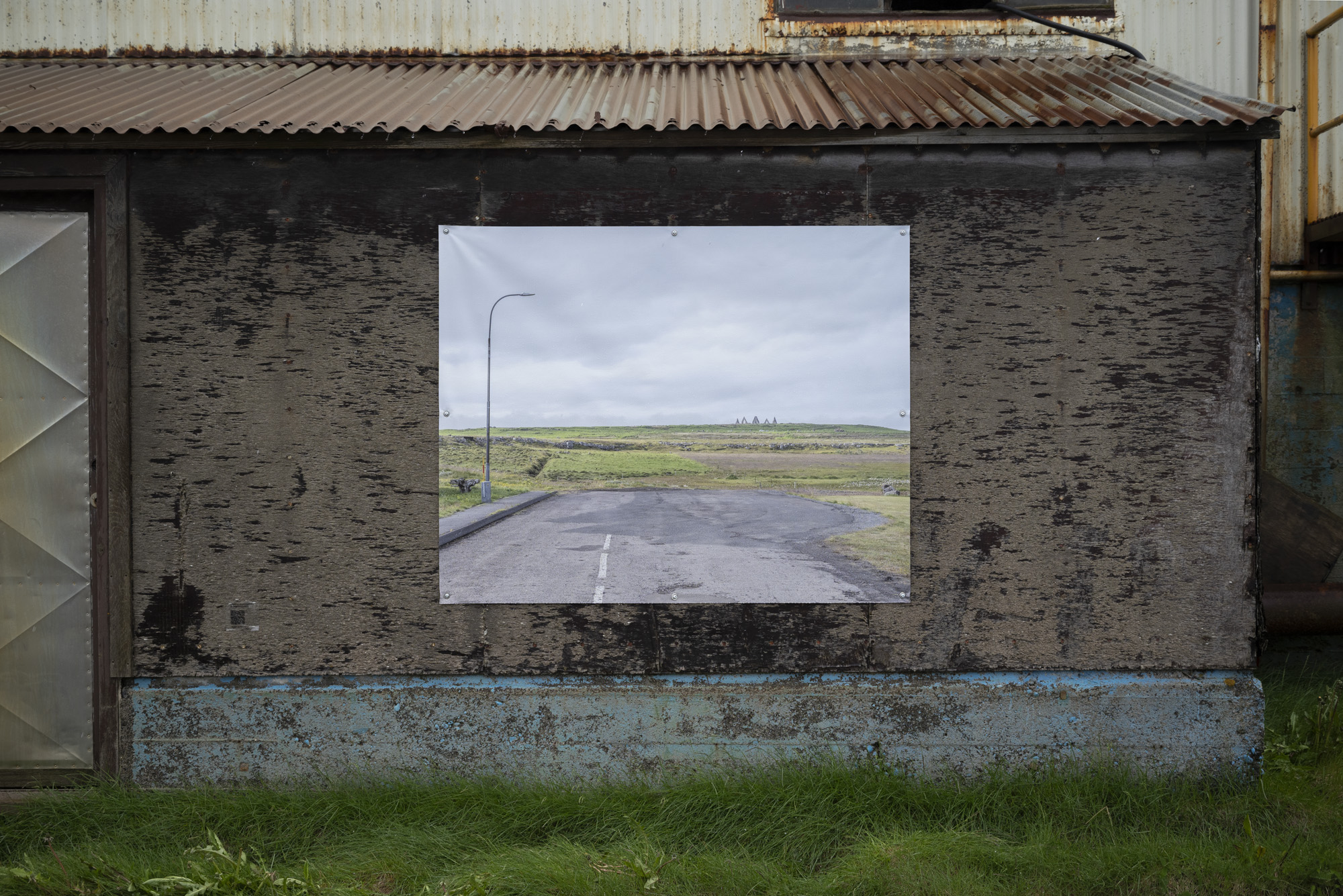
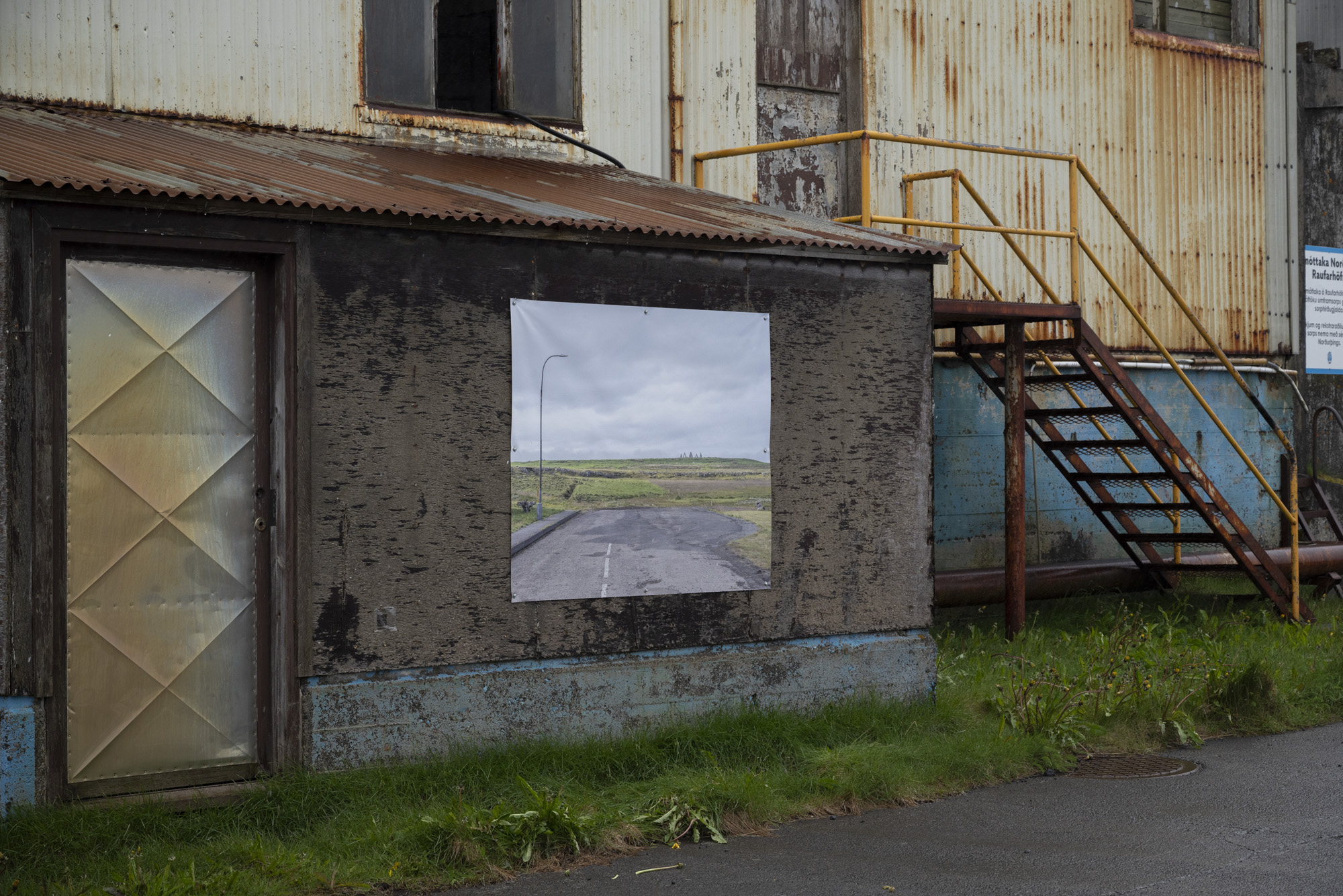
Ósk Vilhjálmsdóttir
Berlín
![]()
![]()
Berlín



Sólveig Aðalsteinsdóttir
Kindagötur
![]()
![]()
Kindagötur
